Introduction to Norway through SAS Scandinavian Airlines' A320-200
Flight routing
- 1SAS - SK4610 - Manchester (MAN) to Oslo Gardermoen (OSL) - A320-200
- 2
- 3
Flight Background:
Hello Flight-Report community,
A trip to Norway has always been on my bucket list since I was 11 years old when I read a travelling guide about Norway in a bookshop. The July of 2025 is finally the time for my dream to come true.
Planning a trip in Norway is no easy task due to its complex geography, with long fjords, winding coastlines and high mountain ranges that result in long travelling time. My trip consisted of a variety of transportation such as trains, coaches, ferries and most importantly, planes. I would only explore Eastern and Western Norway in this trip due to my limited time.
I would take three flights on this trip and managed to try out all three major airlines in Norway: SAS Scandinavian Airlines, Widerøe and Norwegian Air Shuttle.
Flight Selection:
I would be flying to Norway's largest and the capital's main airport of Oslo Gardermoen (OSL) from Manchester Airport (MAN), U.K. This route is served by SAS, Norwegian and Easyjet. I chose SAS this time since it is the cheapest flight on that day. Moreover, the schedule of the flight also worked for me as the 12:55 departure allowed me to have sufficient time to travel from Nottingham to Manchester Airport via train, plus a bit of time to explore Oslo on my first day with a landing time of 15:55. It would also be interesting to observe SAS' service after its emergence from bankruptcy protection and restructuring, plus its transition from Star Alliance to Sky Team after Air France-KLM group investment and acquisition in 2024. Last but not least, travelling on SAS for my first trip to Norway sounds like a perfect introduction to the country. Note that my flight was operated by SAS' subsidiary SAS Connect.
Flight Purchasing:
At the time of purchasing the ticket, SAS was doing a summer promotion fare across its network. Despite not the cheapest fare, it cost me GBP 100.45 for a SAS Go Smart ticket and GBP 10.8 for seat selection. The SAS Go Smart ticket includes one underseat bag, one carry-on bag (max 8kg) and one checked bag (max 23kg).
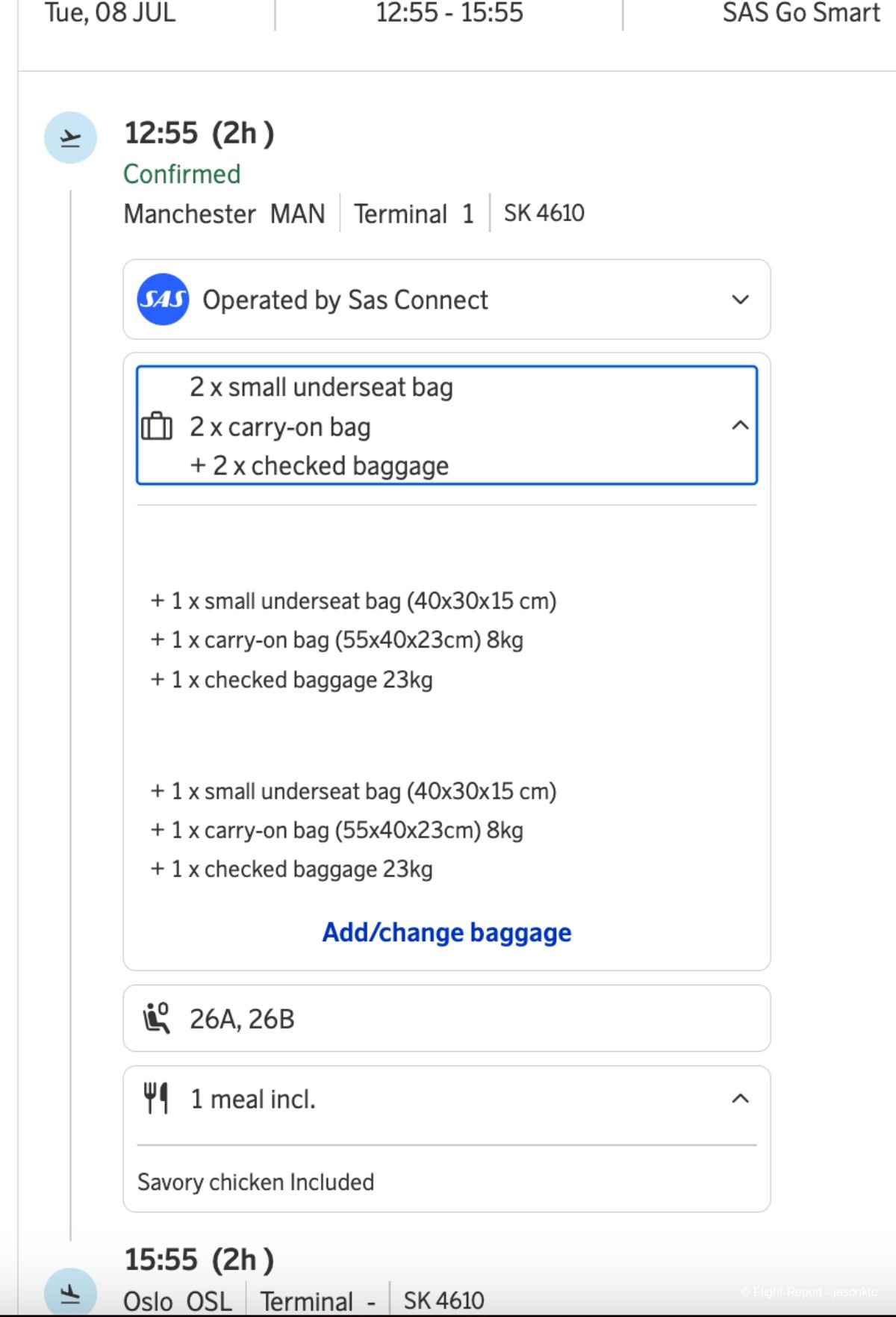
Below is an example of the four different types of fare class offered by SAS on its intra-European flights. Be aware that from 1 October 2025, SAS Go, SAS Plus and SAS Business will be renamed Economy, Premium and Business respectively.
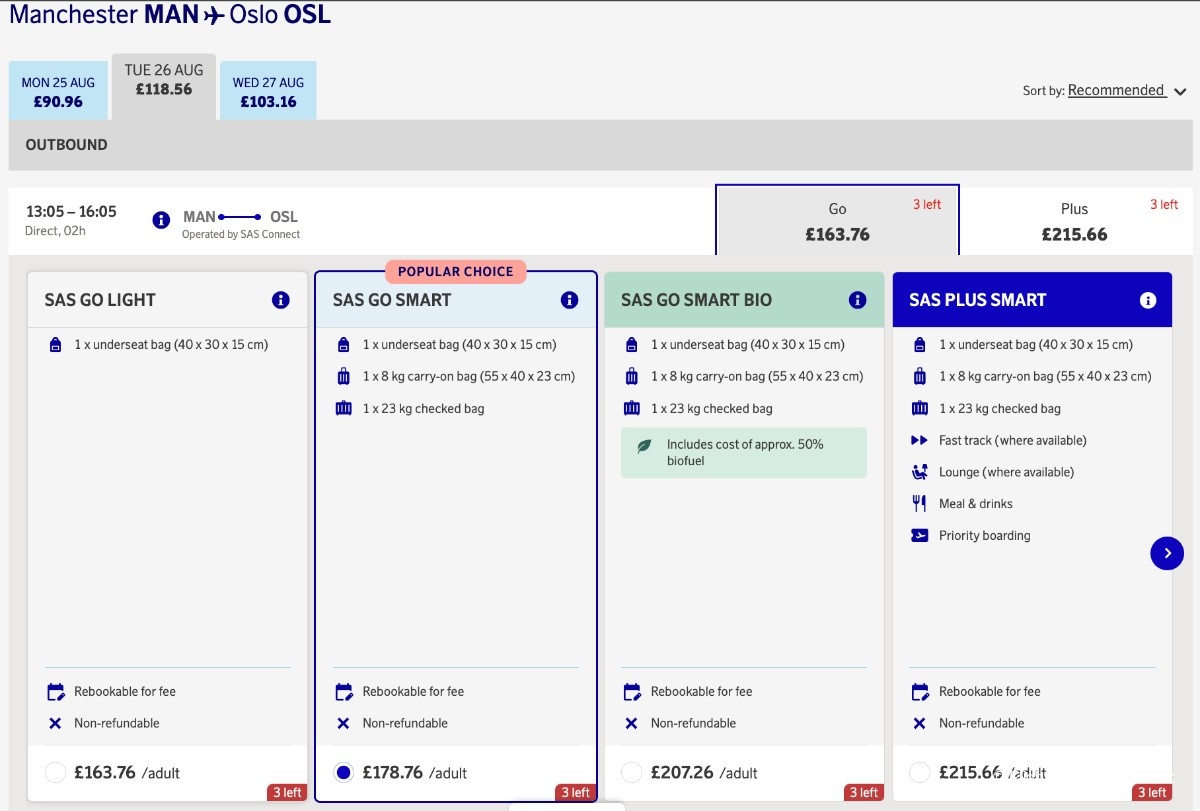
Pre-order Meals:
All SAS ticket types come with free water, tea and coffee service. SAS Go passengers can pre-order meals on European flights that are longer than 80 minutes. And SAS Plus and SAS Business come with complementary meal, too. Passengers can buy meals up to 18 hours before departure which is more flexible than other airlines. I have ordered a chicken meal for the sake of trying out the quality of SAS' meal. I added the meal four days before departure and cost me GBP 12.1. The screenshot below shows the other meals it offer. I remember that the fish, meat and vegetarian meals cost the same as the chicken meal.
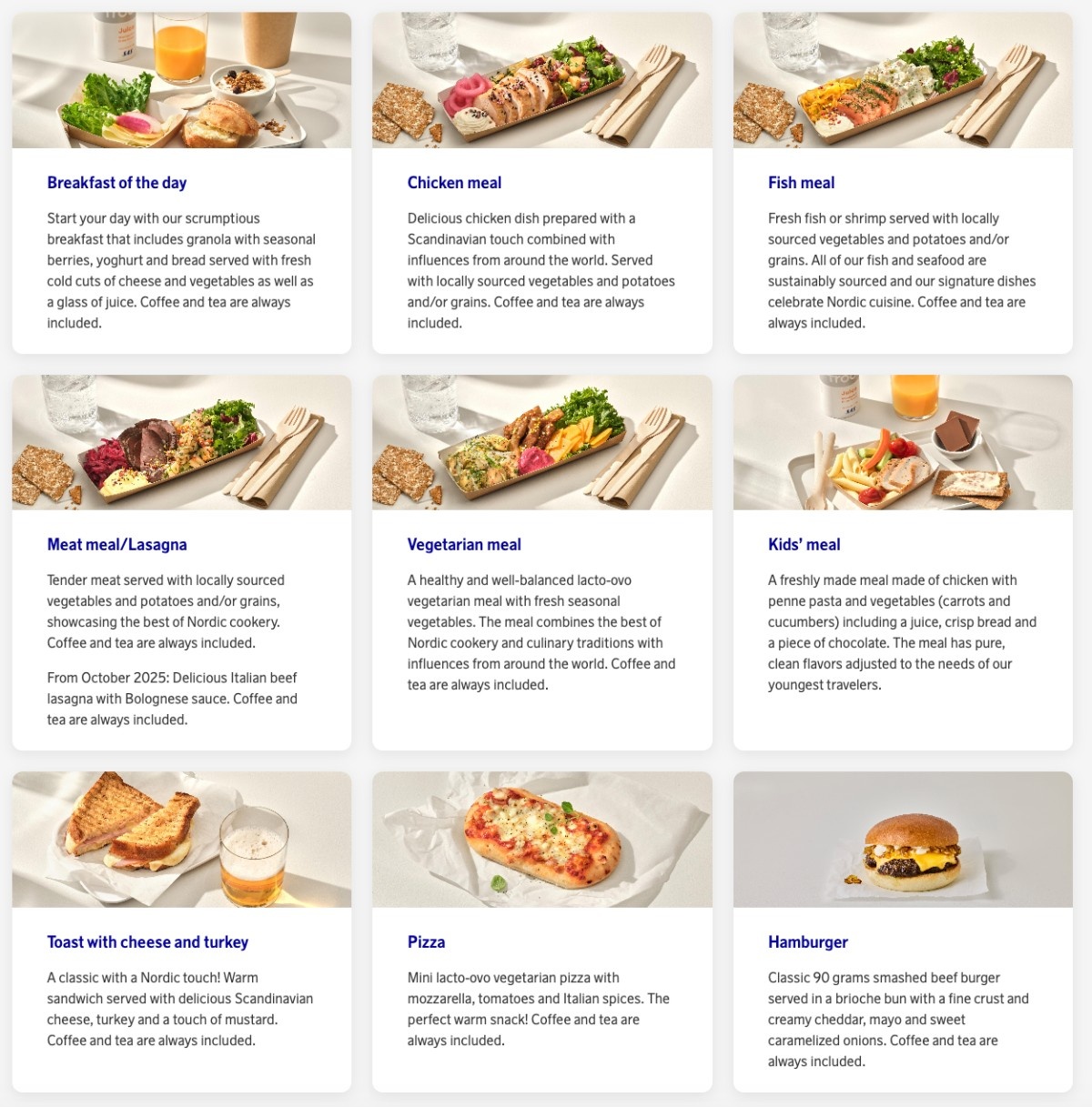
Getting to MAN:
I got on the 07:43 train from Nottingham for my 12:55 departure. A change at Manchester Piccadilly Station was required and I should had arrived Manchester Airport at 10:25. However, the station's information screen were showing "delayed" for all trains. I thought it was just a minor delay originally as it was quite common to see train delays in the U.K.
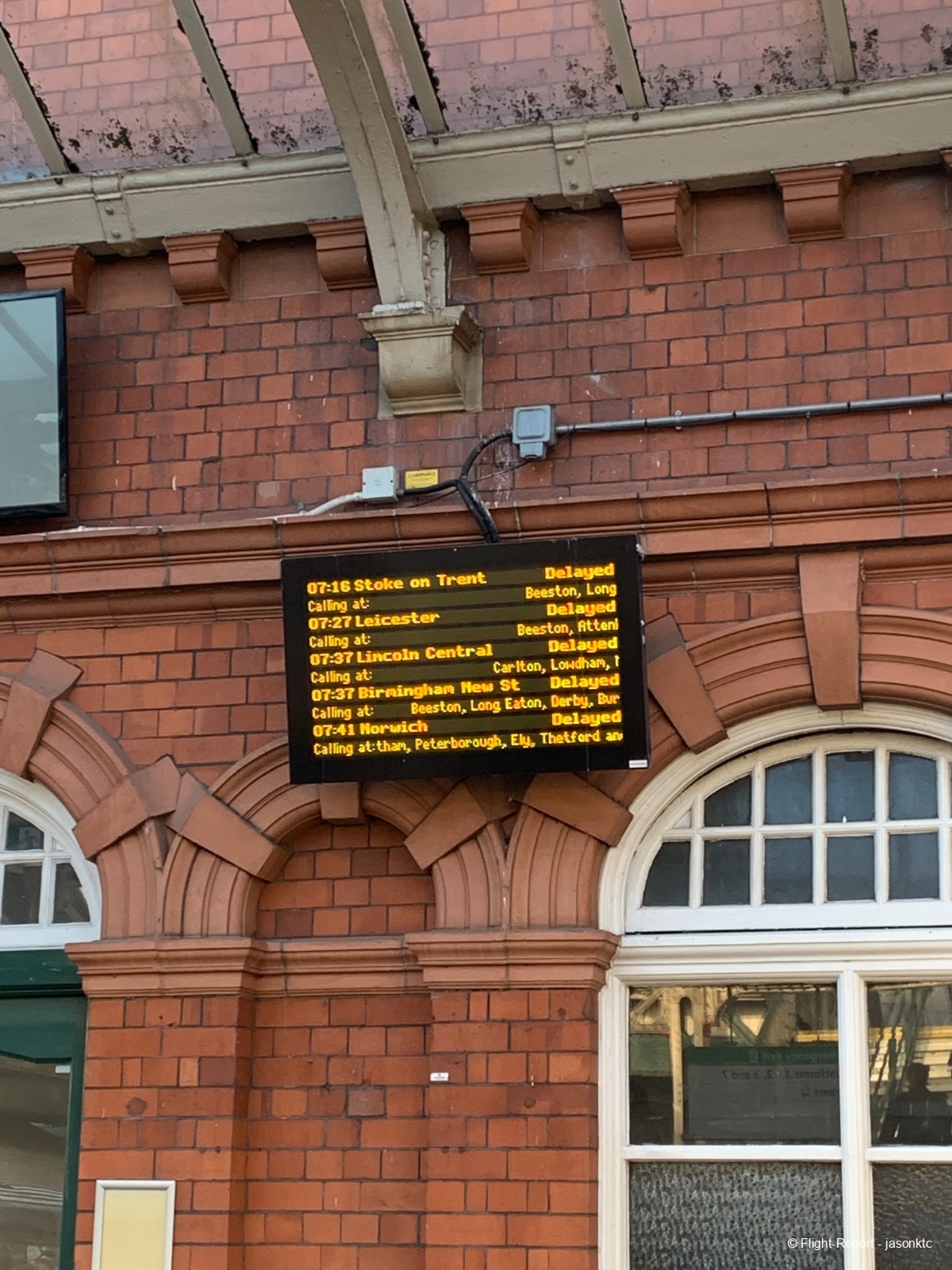
I then received an SMS informing me that my train to Manchester was also delayed. It turned out the delay was caused by an signal failure at Nottingham station.
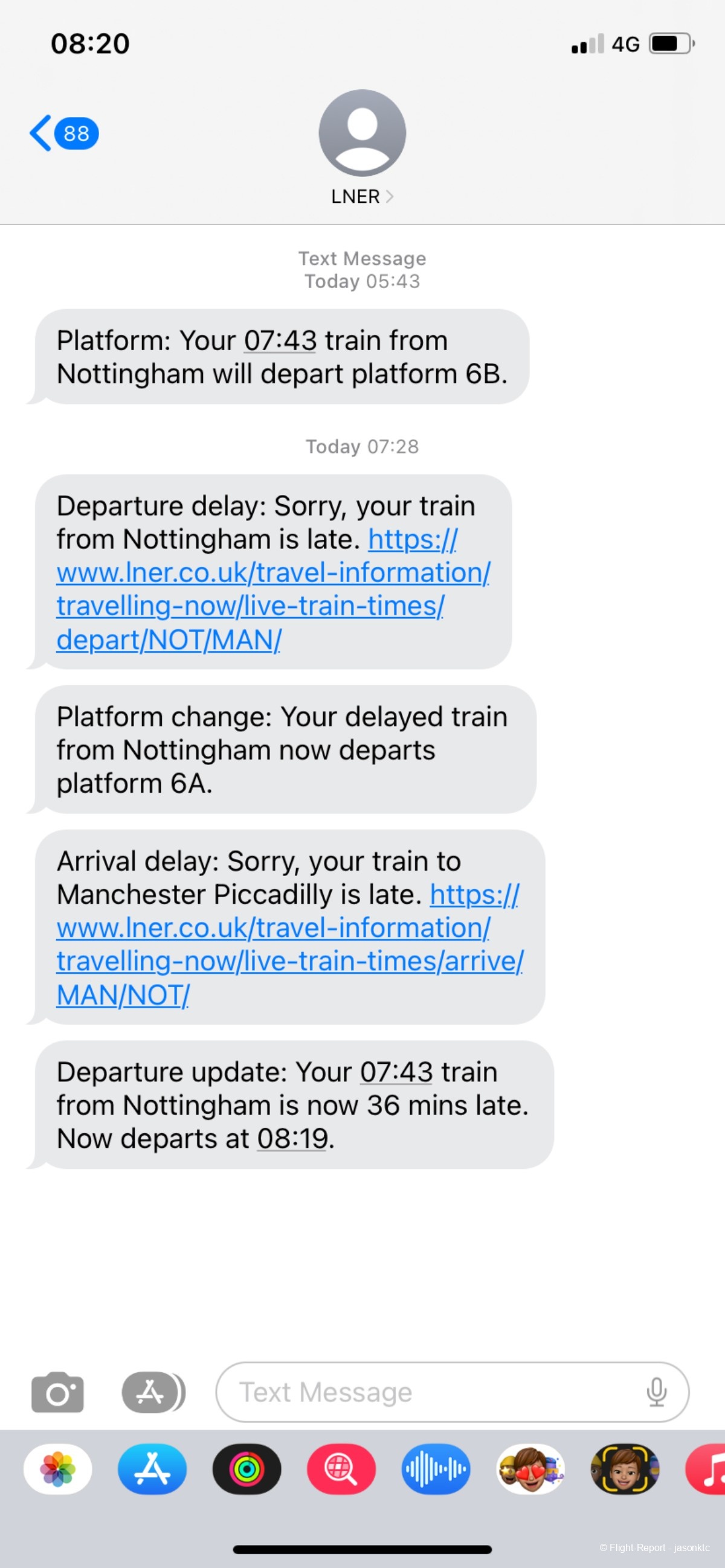
I was nervous that I would miss my flight as time passed. Eventually, a train showed up on another platform and it turned out to be my Manchester train. I was quite surprised that there was no PA announcement to inform the change. The conductor on our train also announced that the train would not stop a station ahead to catch up some time. Albeit the mess at the station, I could get a glimpse of the beautiful Peak District as the train ran through the Hope Valley Line. I had also submitted a delay compensation form afterwards.
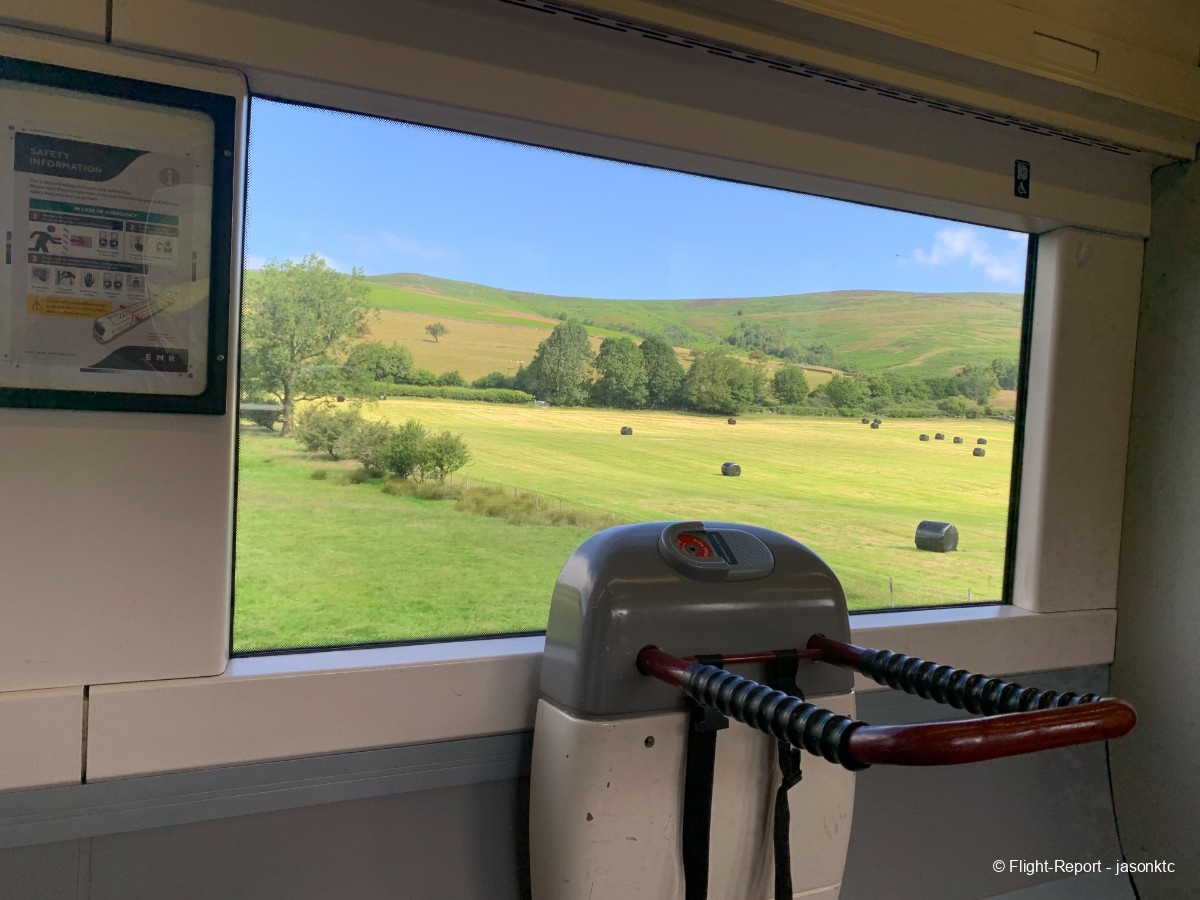
I arrived at the airport at around 10:40. Unfortunately, the mess went on. SAS departs from MAN Terminal 1, and getting to the check-in area from the train station required one to take three to four journeys of escalator/lift. There were only few lifts and they were slow and small. Often there was no space left when it reached your floor. The worst part was the check-in area at T1 is separated between Hall A and B split in two floors. But there was no clear signage showing which airlines located at which hall, so it was a guessing game and made the lift journey even more unpleasant. I realise T1 is soon to be closed for renewal, but a clear signage system to aid passengers' wayfinding should be a basic thing in an airport.
Check-in at MAN T1:
The check-in desk for SAS is located at a quieter side of Terminal 1, away from the busy Easyjet counters. Although I had already checked-in online and received my digital boarding pass, I had to drop off my baggage. There were three staffed counters and only a handful of passengers waiting in line at the time.
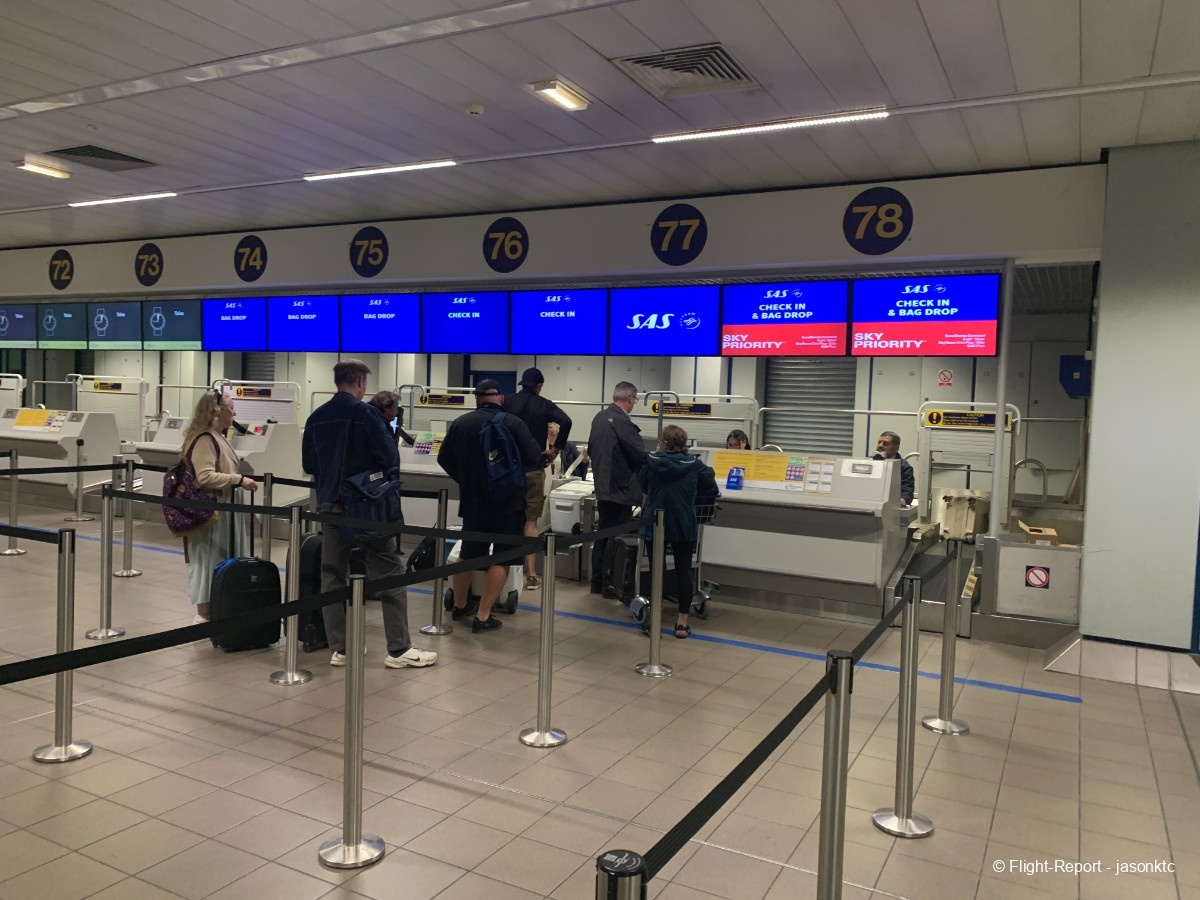
Within five minutes, I had dropped off my baggage and received a physical boarding pass. I was quite disappointed when I noticed the boarding pass was printed on a flimsy, recipe-like thermal paper in black-and-white. I certainly miss those old boarding passes which had colourful branding and images.
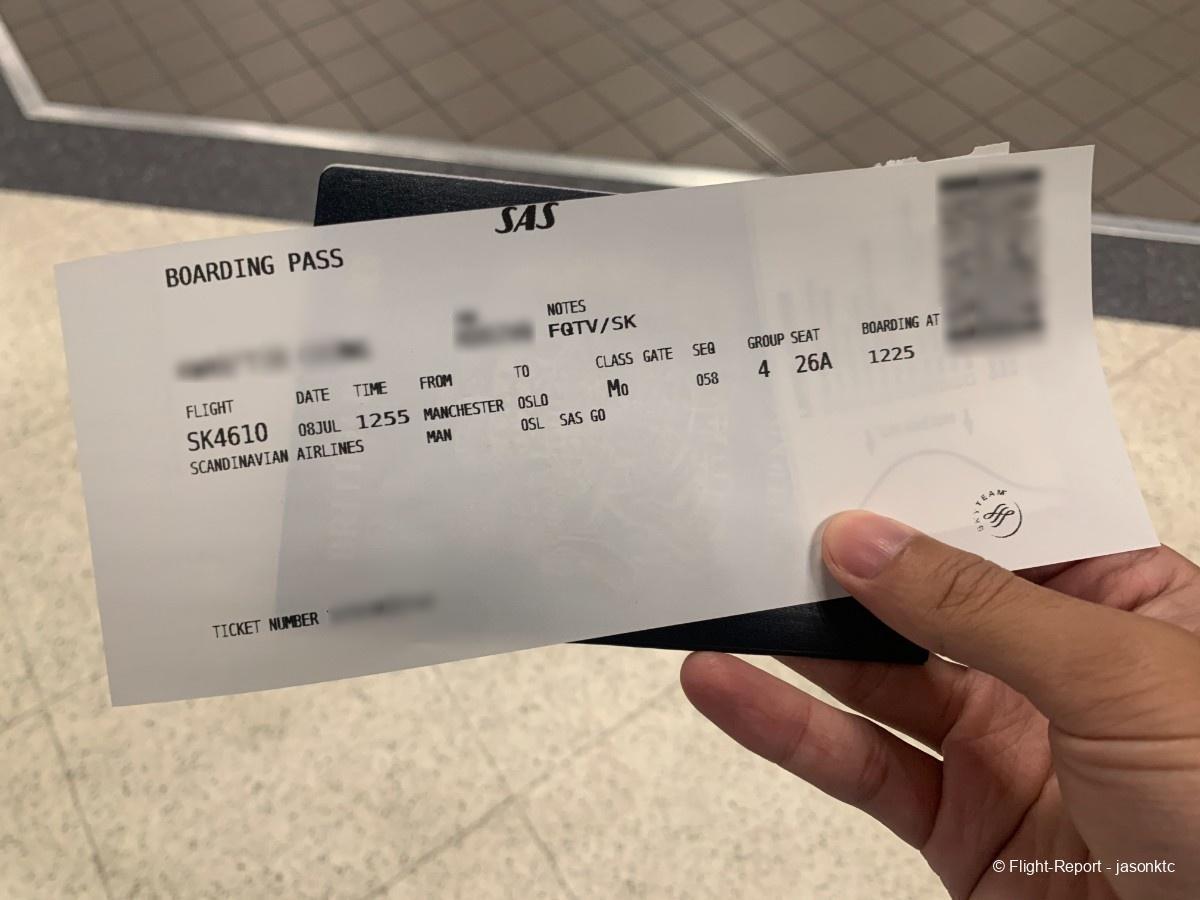
Departure Hall of MAN T1:
I headed to security area afterwards. The immigration part went smoothly but the security check area was quite packed. Manchester airport has installed the newer x-ray/CT scan machines that are also being introduced in different airports across the U.K. The officers were quite overwhelmed as quite a lot of carry-on baggages required re-scan or additional hand-search, and many flights were departing at that time. The passengers waiting for their belongings had made the small space even more crowded.
After passing security and duty-free, there are fair amounts of seating in the departure hall. There are handful of coffee shops, bars and restaurants, plus a WHSmith and a Boots pharmacy. I managed to grab a table in Starbucks which has a nice view over the apron of T1.
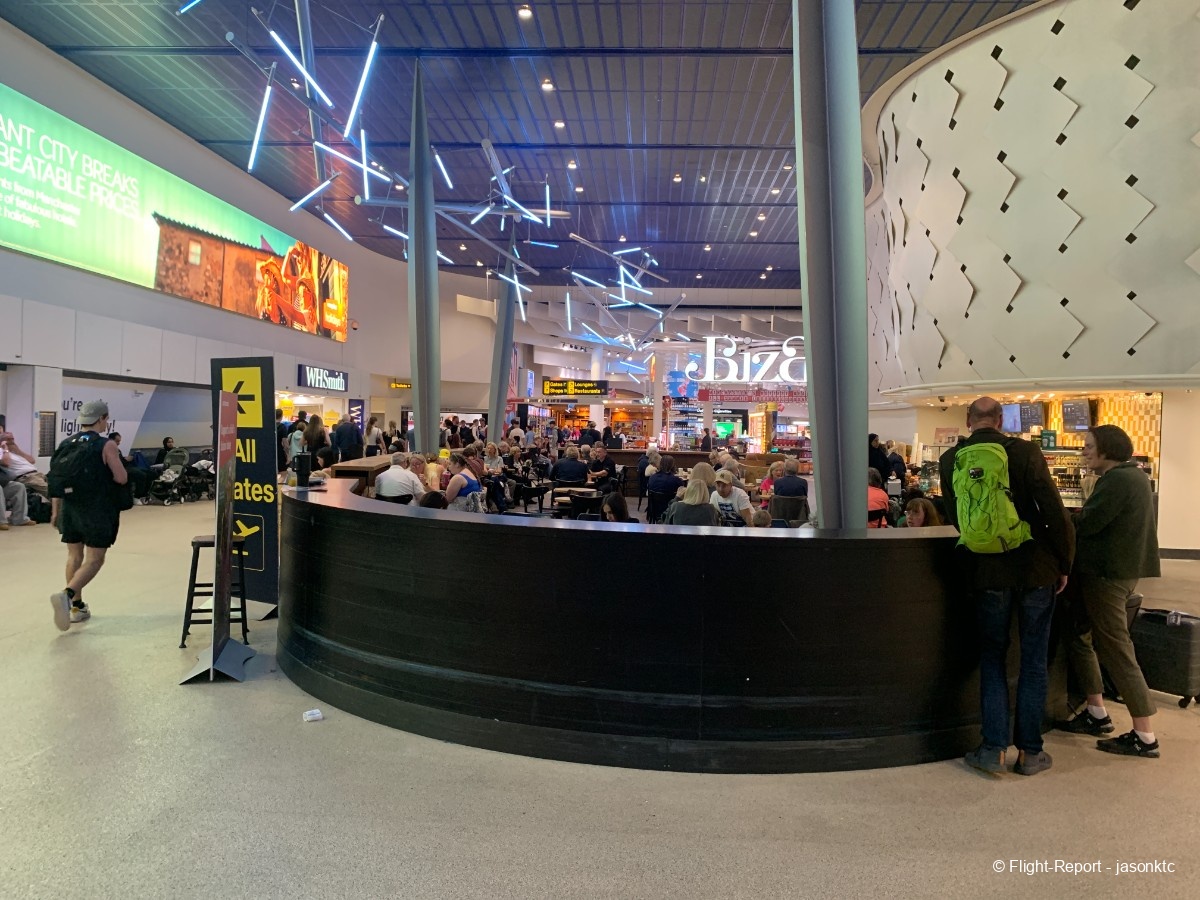
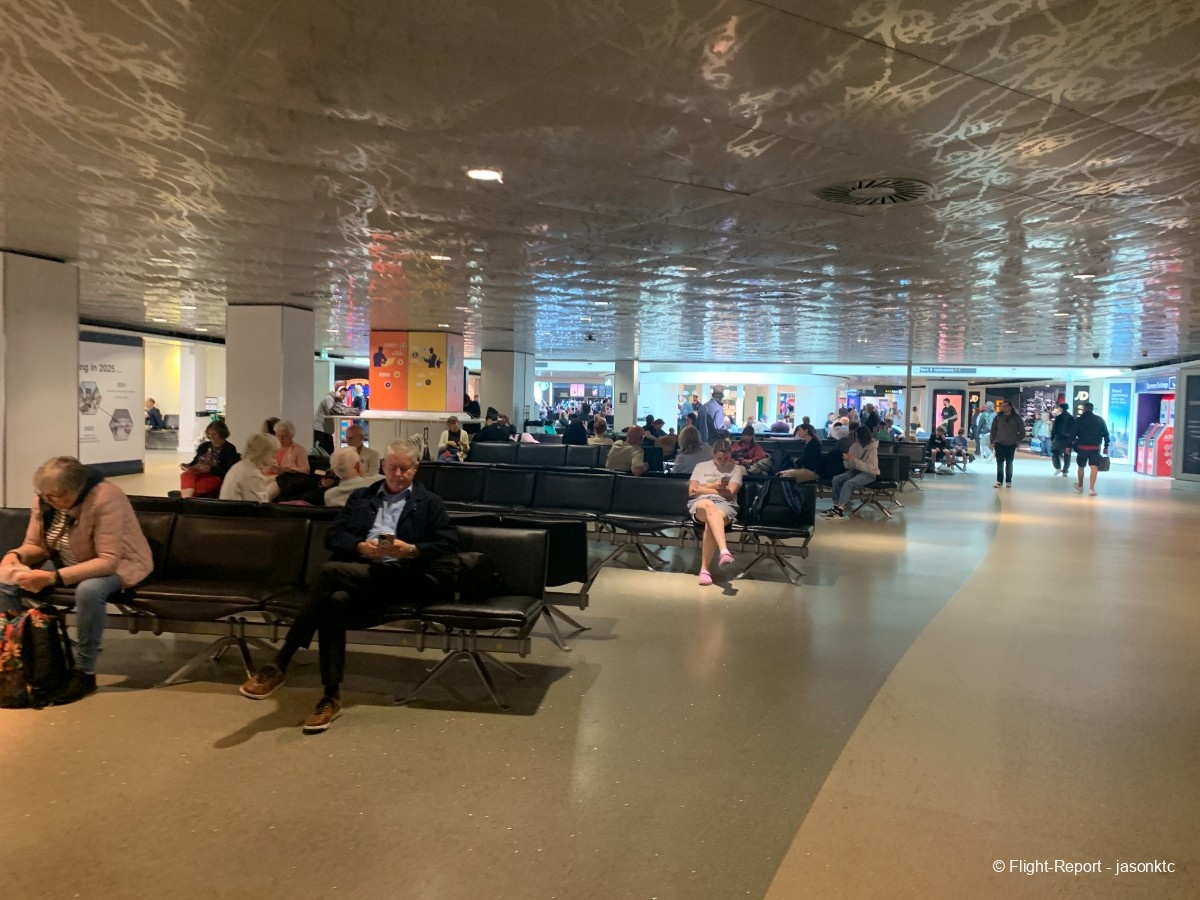
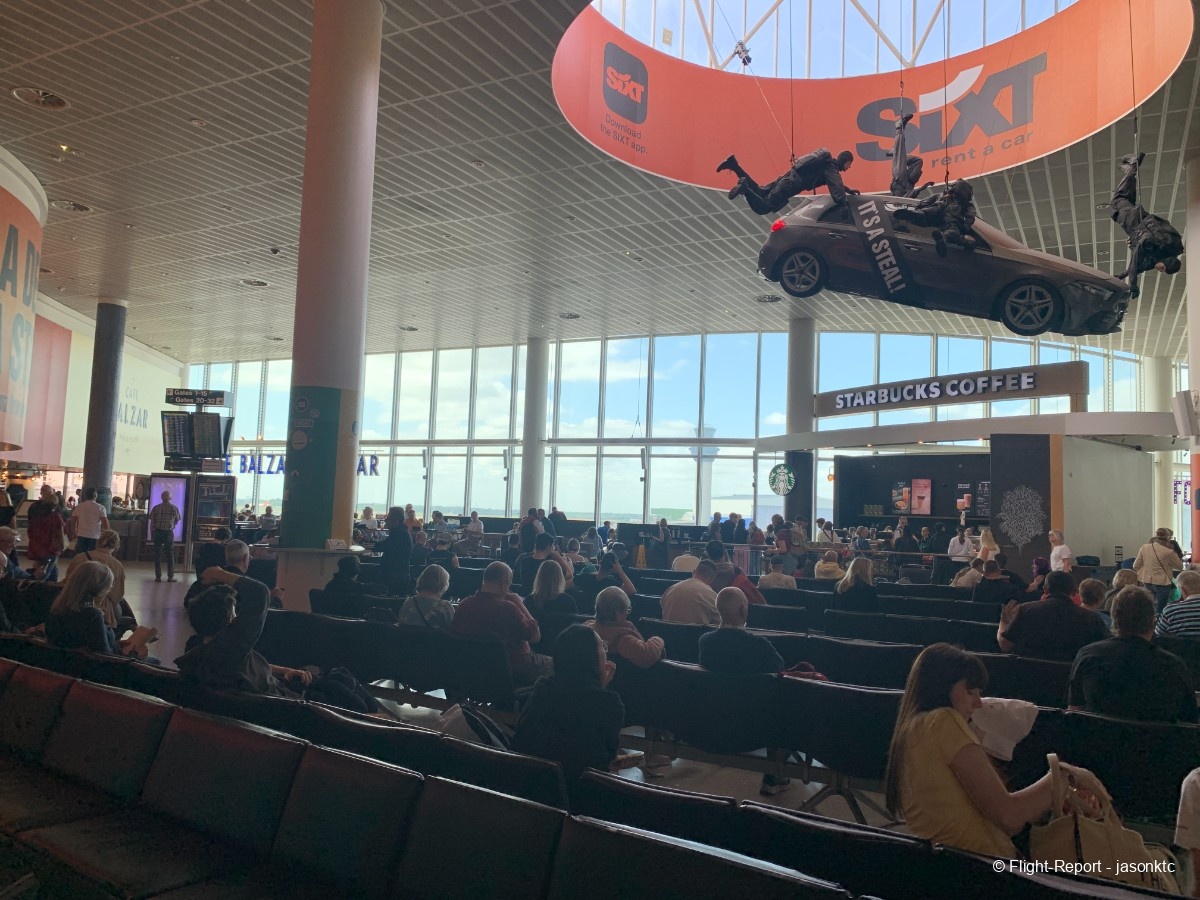
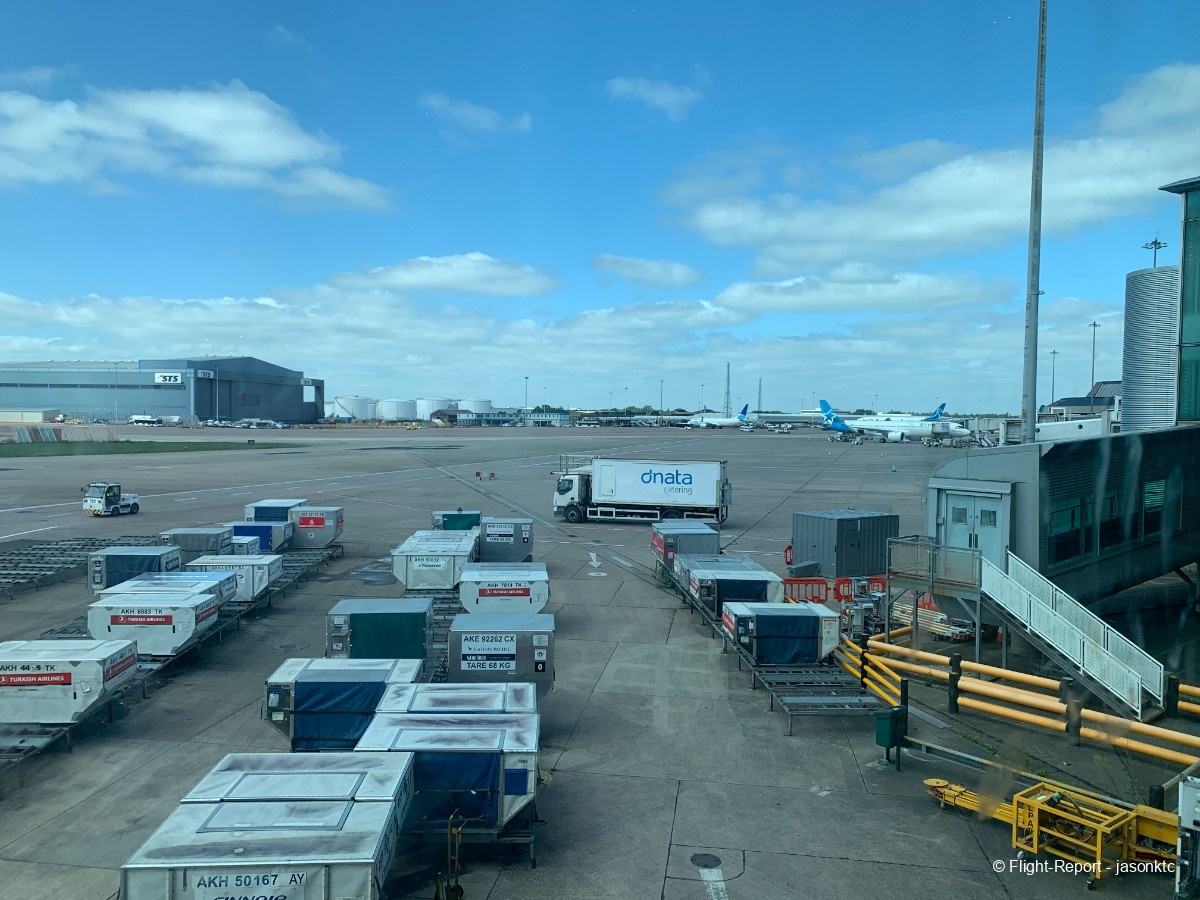
I did some casual plane-spotting while having my beverage. I managed to spot a Cathay Pacific A359 which operates daily between HKG, an Icelandair B38M with "Boreal Blue" tail, an Aer Lingus A333, a KLM A21N and a Virgin Atlantic A359.
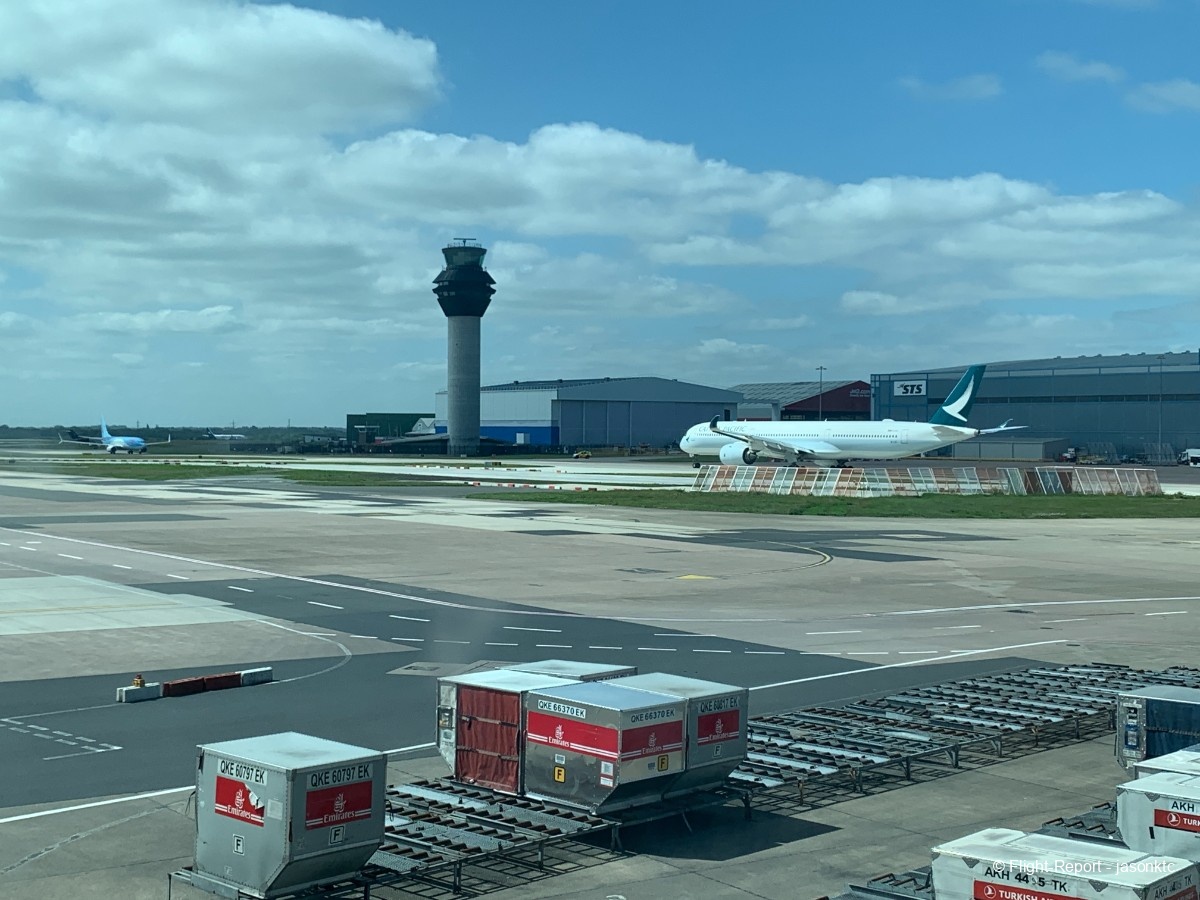
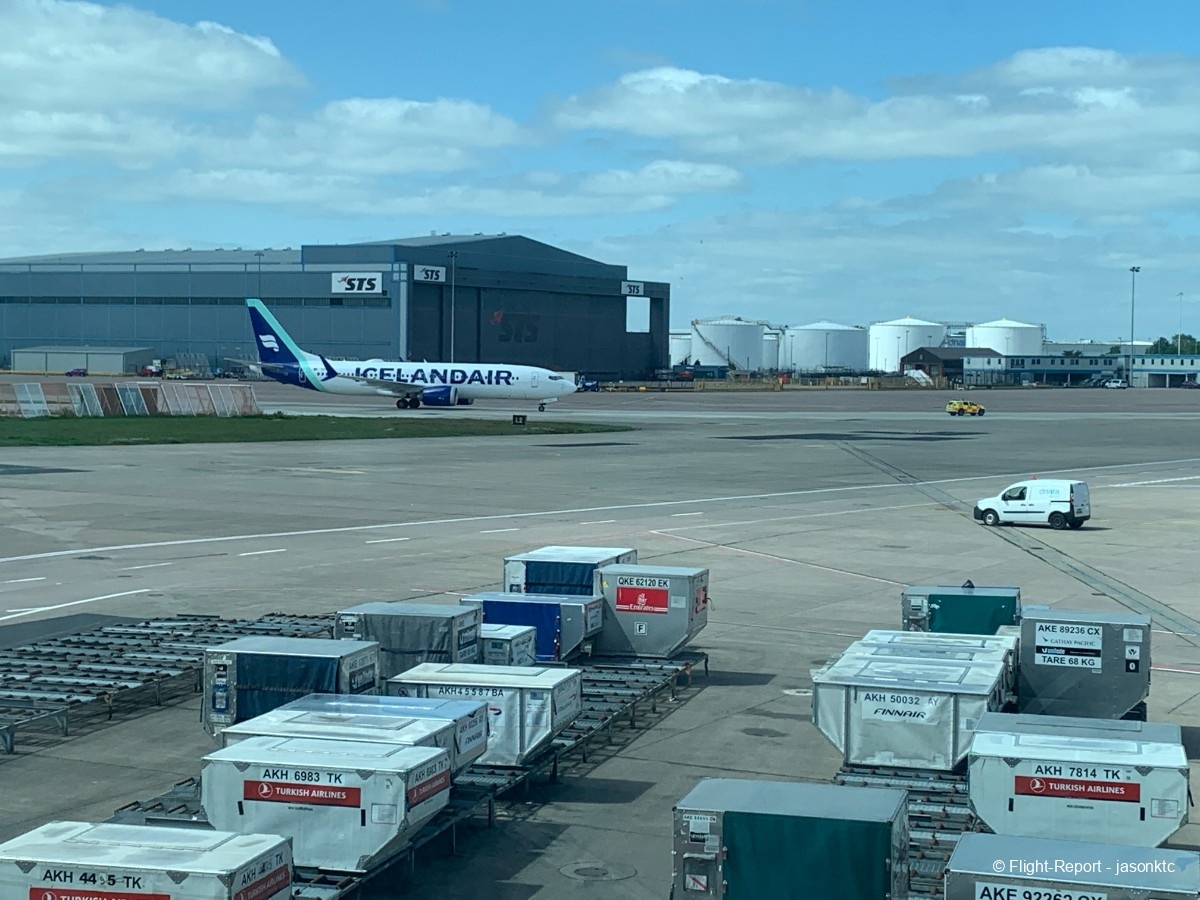
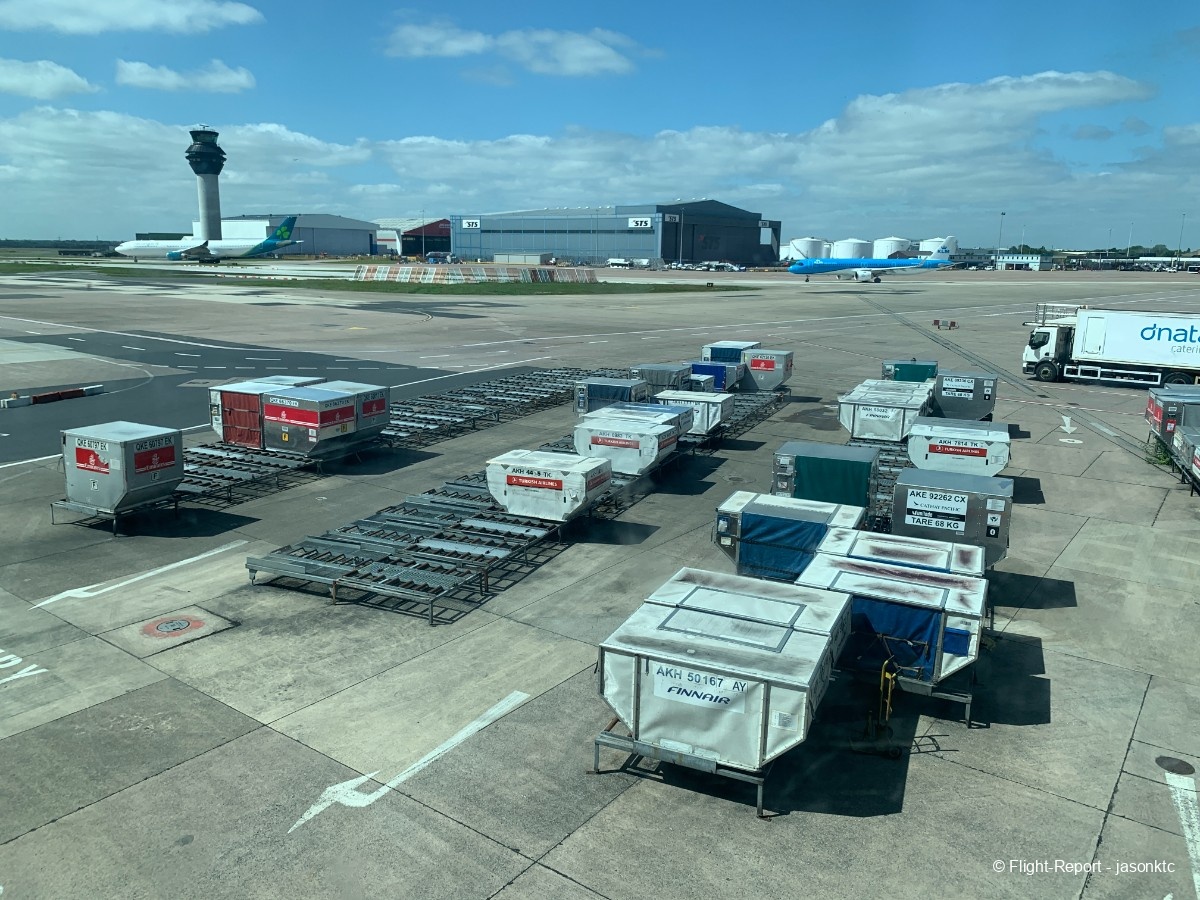
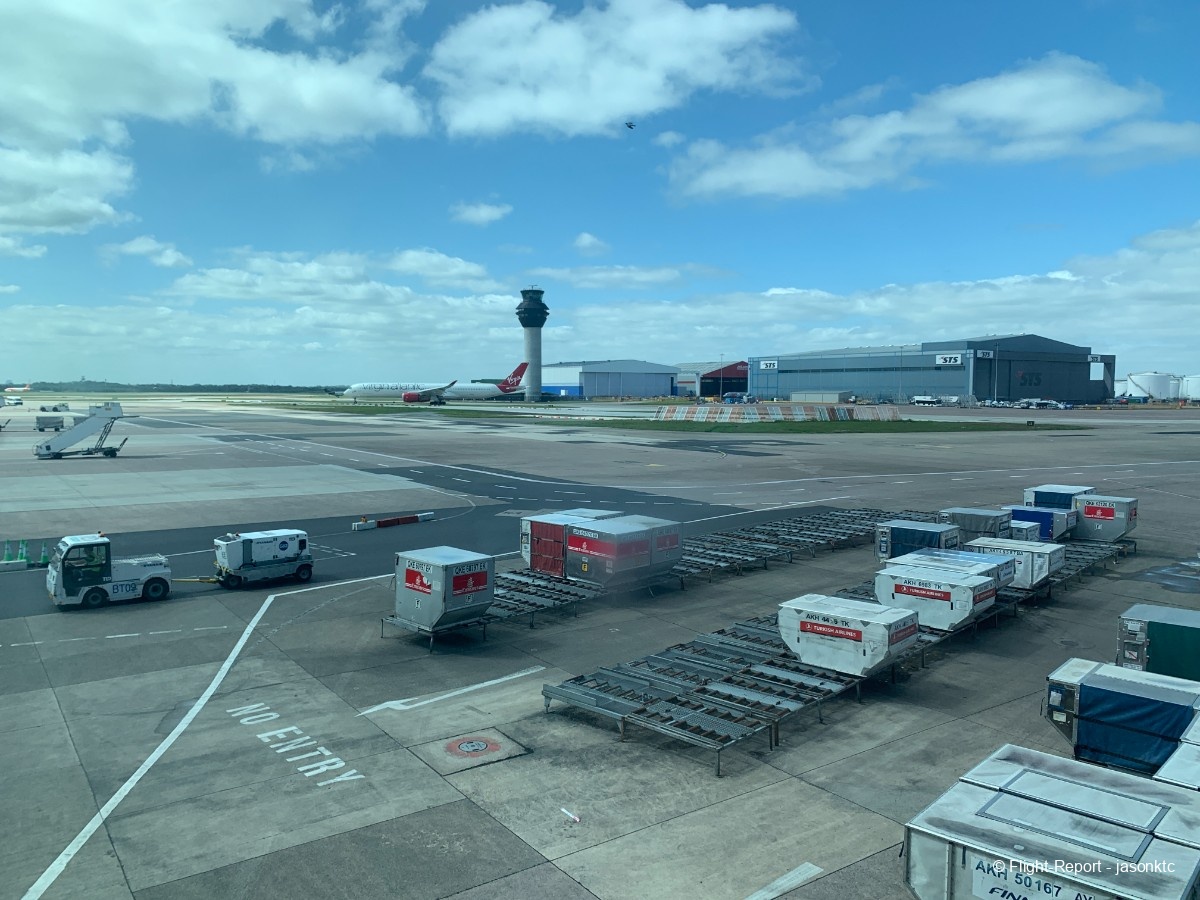
Finally, the plane that I would take this afternoon showed up at the apron. It came from Oslo as SK4607 and landed at approximately 11:50 according to Flightradar24. I was expecting the plane to be an A320neo belongs to SAS' subsidiary SAS Connect and painted with the new SAS livery and "EI-" Irish registration since it was marketed as a SAS Connect flight. Instead, an A320-200 from SAS mainline that still carries the old livery entered my camera lens.
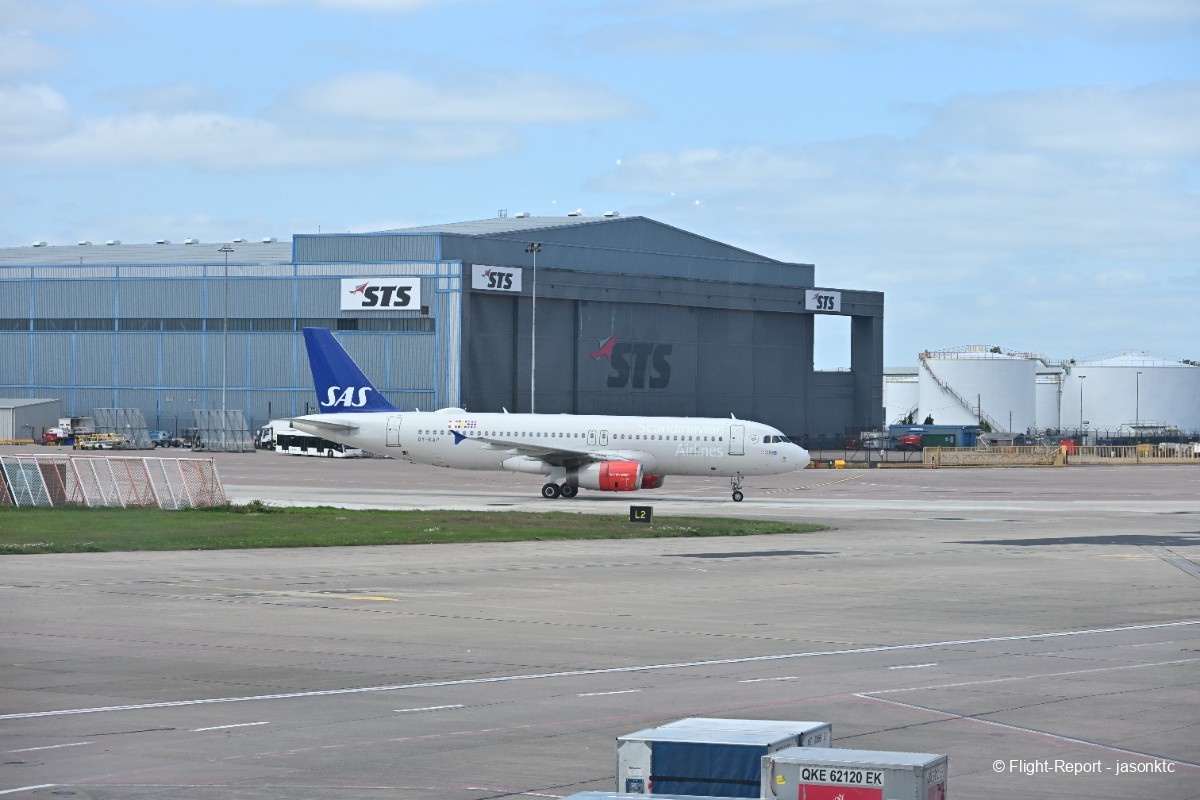
Gate Area of MAN T1:
The flight was departing from Gate 22. The area is separated into two sides by a partitioned walkway in the middle, which is dedicated for arrival passengers. Departure passengers are directed to the left hand side of the gate area where all the odd number gates are located. Weirdly, passengers like me heading to even number gates have to walk through a narrow tunnel via staircases to cross the partitioned walkway above. The tunnel is also where the lavatories are located. I find this design quite unwelcoming for elderly and disabled passengers and odd from an ambiance, design and way-finding perspective.
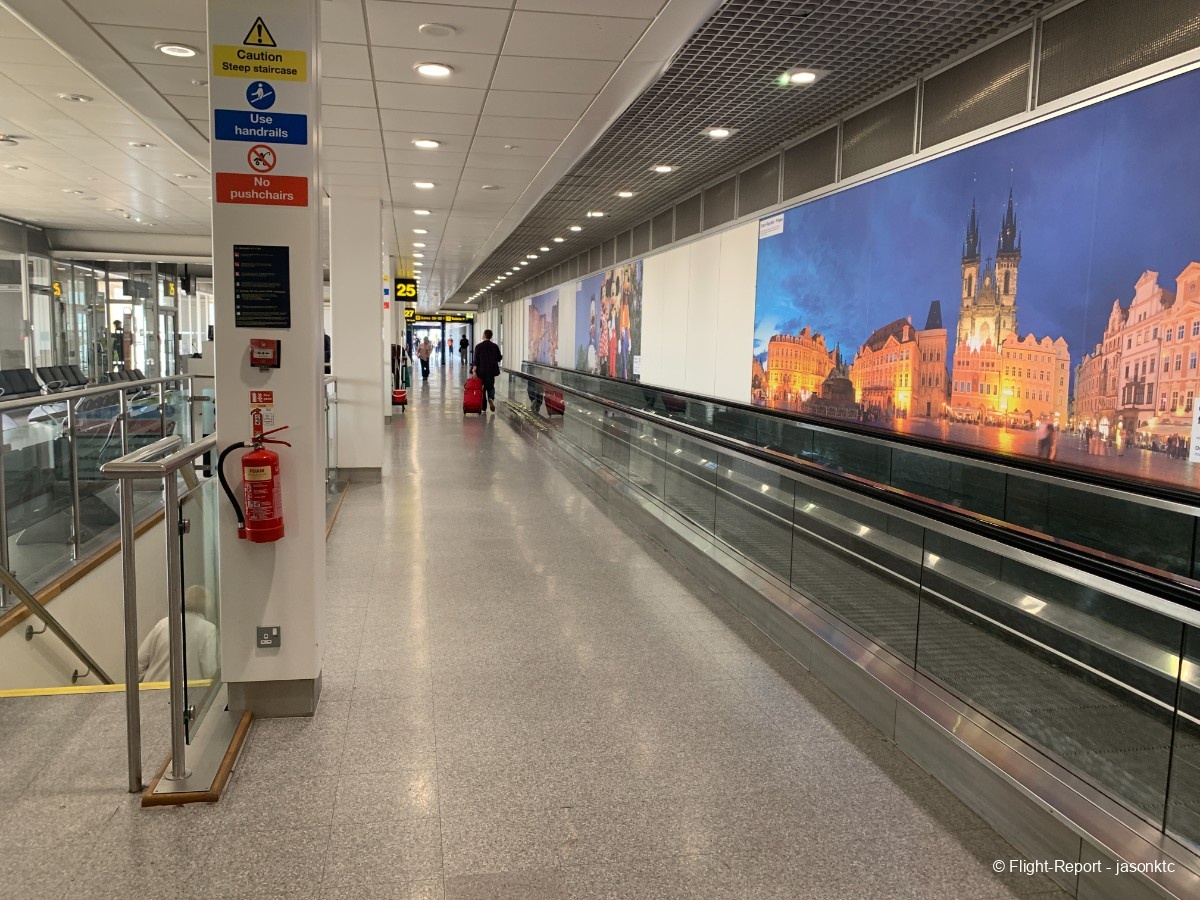
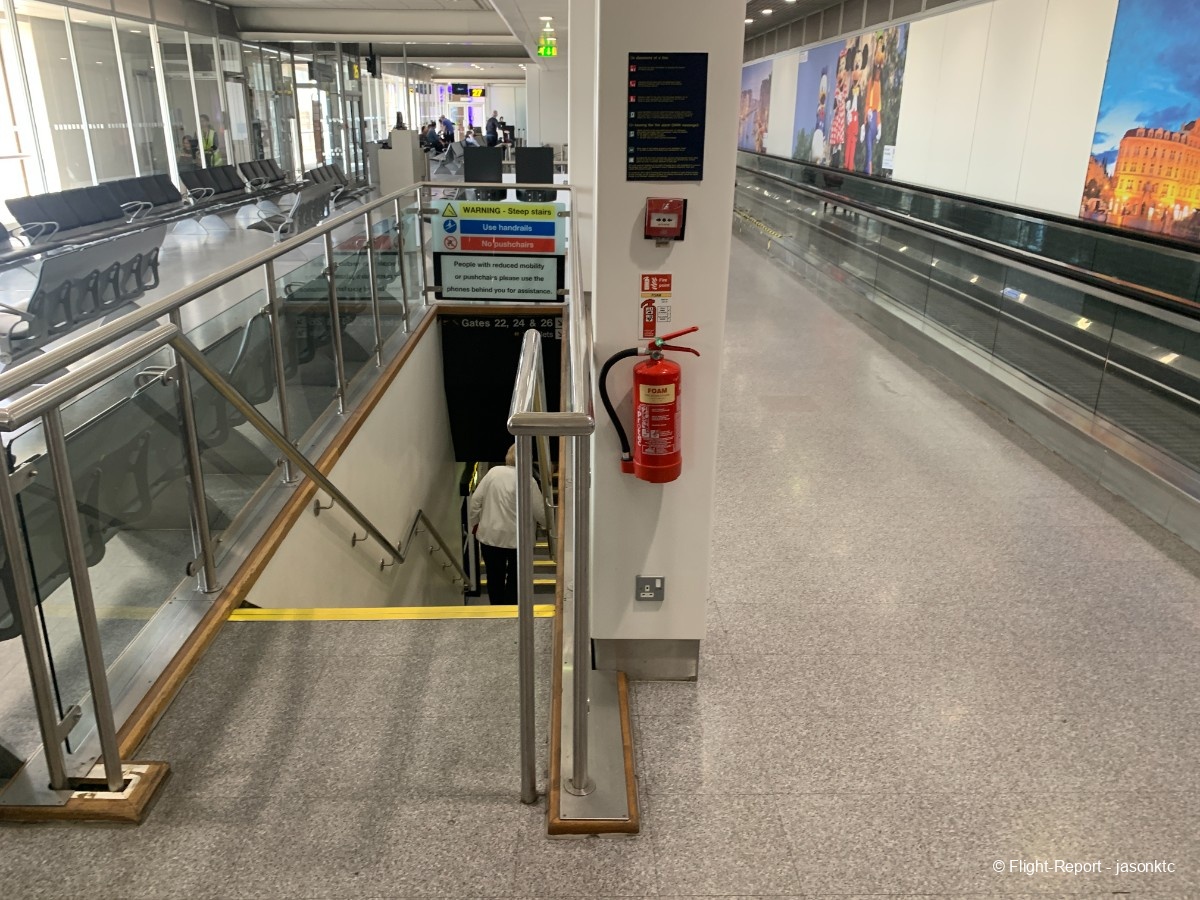
Aircraft and Flight Information:
The plane that operated today's SK4610 flight was OY-KAP, a 18.3 years old A320-232 belong to SAS mainline and registered in Denmark. It had its first flight on 13 March 2007, and delivered to India's IndiGo. It joined SAS on 19 April 2013. Hence, it is one of the oldest planes in the whole SAS Group. It still carries the old SAS livery with the signature blue tail, red engines and white fuselage. I particularly like the dotted design that represents the flag of the three Scandinavian countries which have SAS as their national airline: Norway, Sweden and Denmark. Although it still has the old livery, the Star Alliance logo has already been replaced by the Sky Team logo.
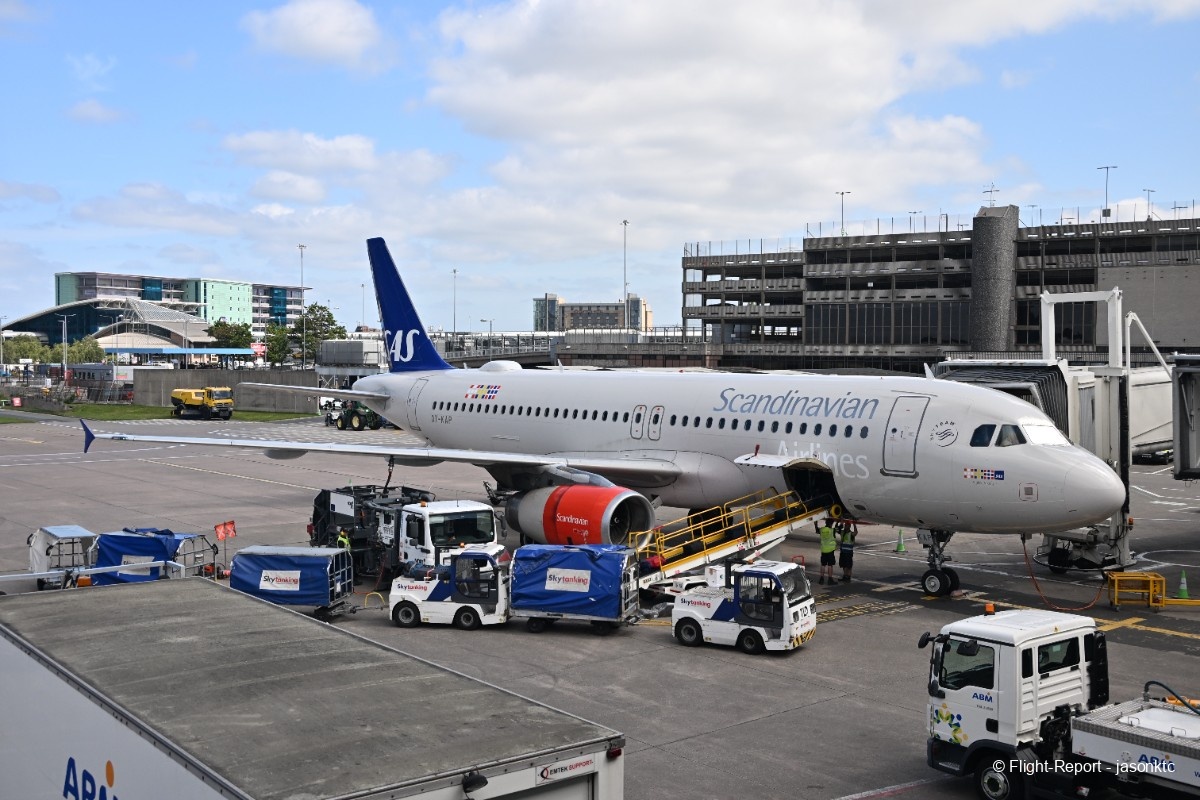
Date: 8 July, 2025
Flight: SAS Scandinavian Airlines SK4610
Route: Manchester (MAN) - Oslo Gardermoen (OSL)
Aircraft Type: Airbus A320-232
Aircraft Registration: OY-KAP (Y168)
Seat: 26A
Scheduled Time of Boarding: 12:25 BST
Actual Time of Boarding: 12:24
Scheduled Time of Departure: 12:55
Push Back: 12:50
Takeoff: 13:02
Scheduled Time of Arrival: 15:55 CEST
Landing: 15:37
At Gate: 15:40
Passenger Load: 85-90%
Boarding of SK4610:
Boarding began one minute before stated time. Passengers were boarded in groups. My seat was 26A and was assigned in Group 4. The whole boarding process was organised and orderly thanks to the gate staff and the cooperation of fellow passengers.
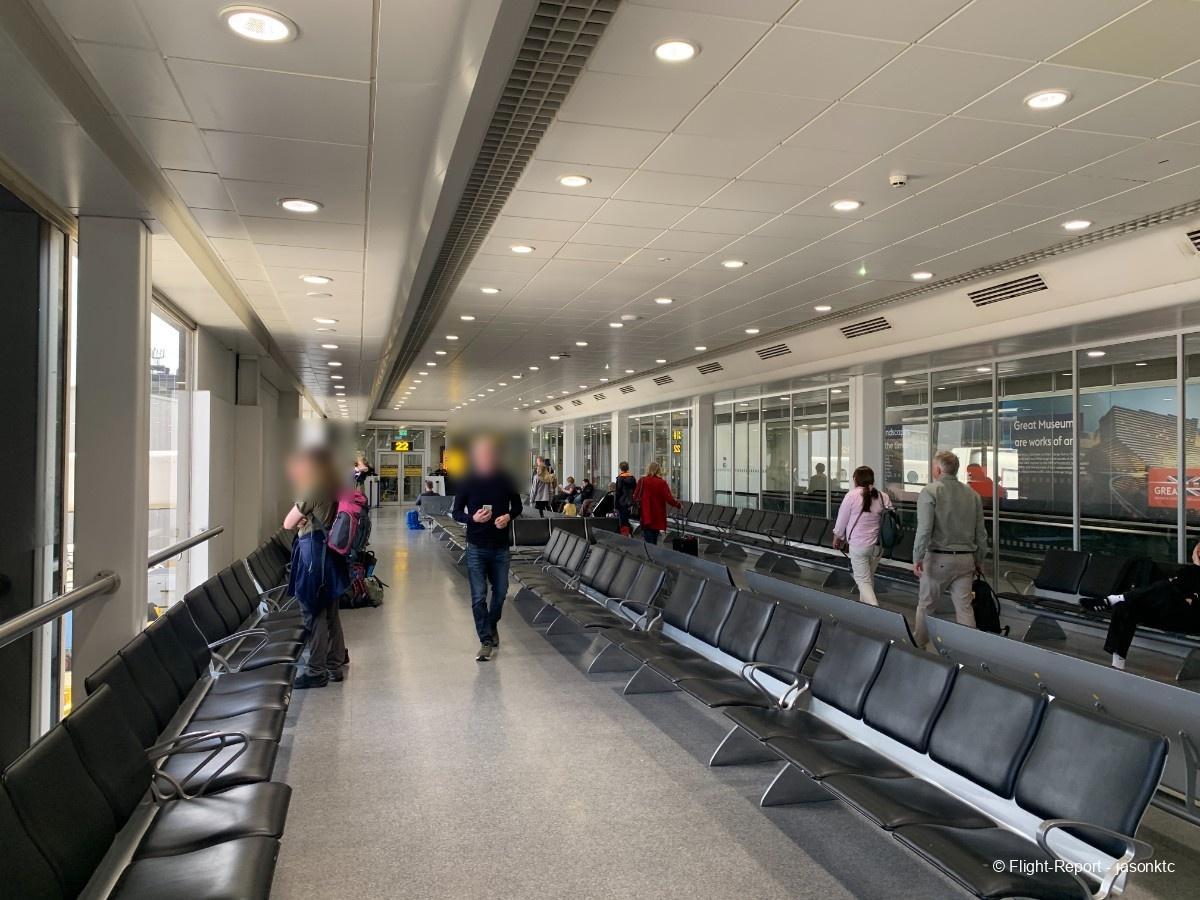
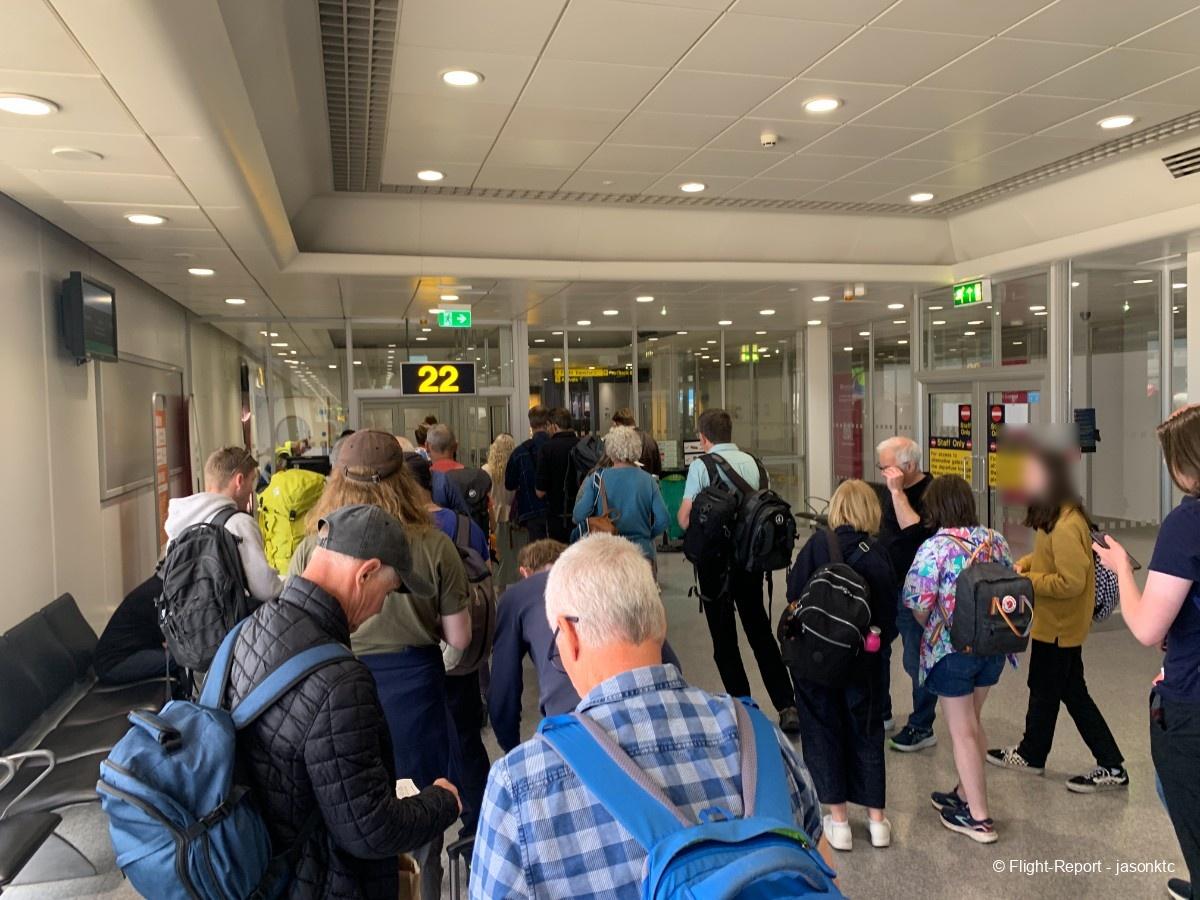
Cabin and Seats of OY-KAP:
SAS' A320-200s have 168 seats spread across 28 rows in a 3-3 configuration. There is no real difference in seat design between Business and Economy class. They are not separated by curtains or partitions, either. The only way to distinguish the two classes is by looking at the headrest cover. Most of the seats have 30" seat pitch (except emergency exit row 11 and 12), slightly better than the newer A320neos in SAS Group's fleet which have 180 seats and 28-30" seat pitch. SAS has configured the plane with dark grey seat upholstery, seatback and carpet, plus white panel, blue curtains and wooden textured bulkhead. The front-right bulkhead also has a blue SAS logo on it.
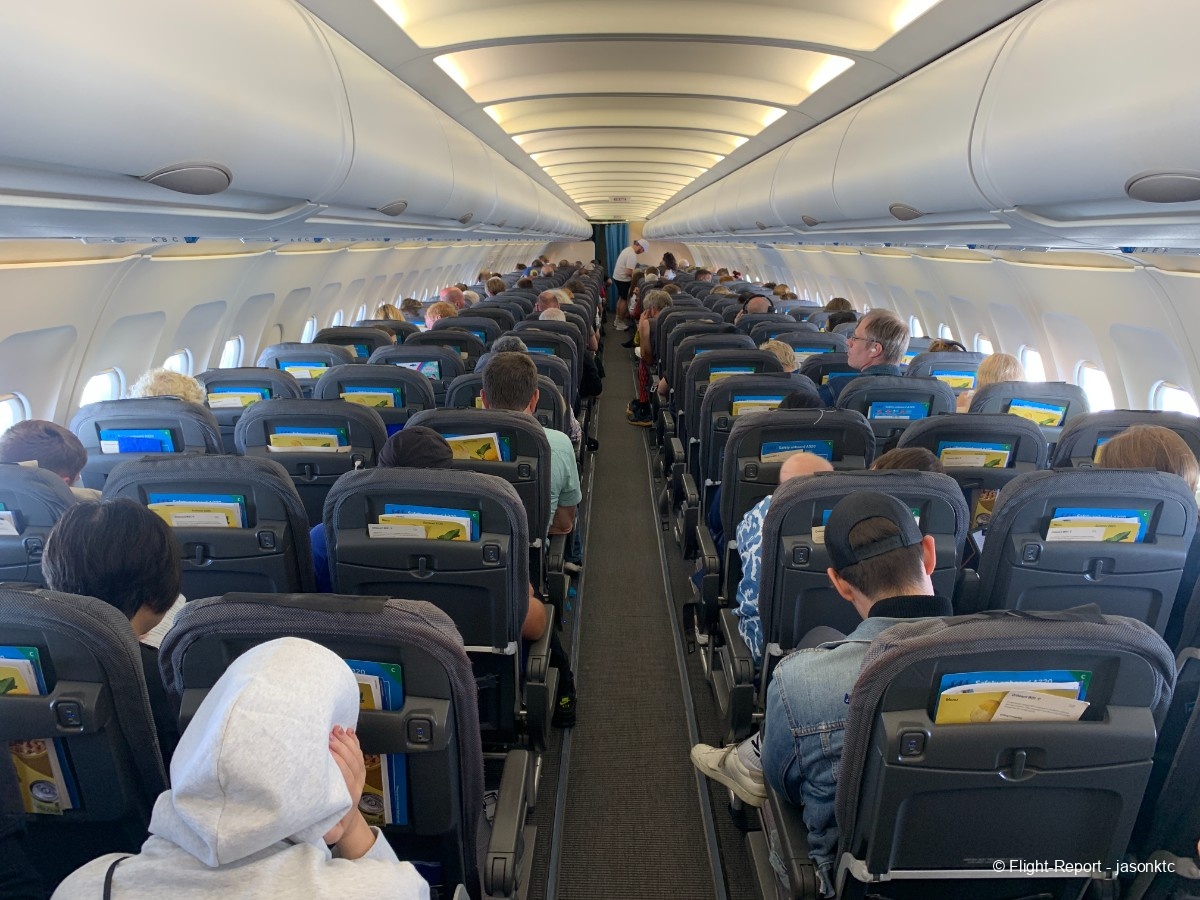
SAS has installed Recaro BL3520 slimline seats on all of their A319s, A320s and A320neos, which is a common product that is installed on many narrow-bodies in LCCs and European airlines. The seats are covered in a grey/charcoal-coloured cloth with tiny square pattern and cobalt blue stitching. There is also a small SAS blue flags stitched on the side of each seat. There is no headrest but only a dark grey headrest cover on each seat. Overall, the cabin design is neat but not exciting or memorable.
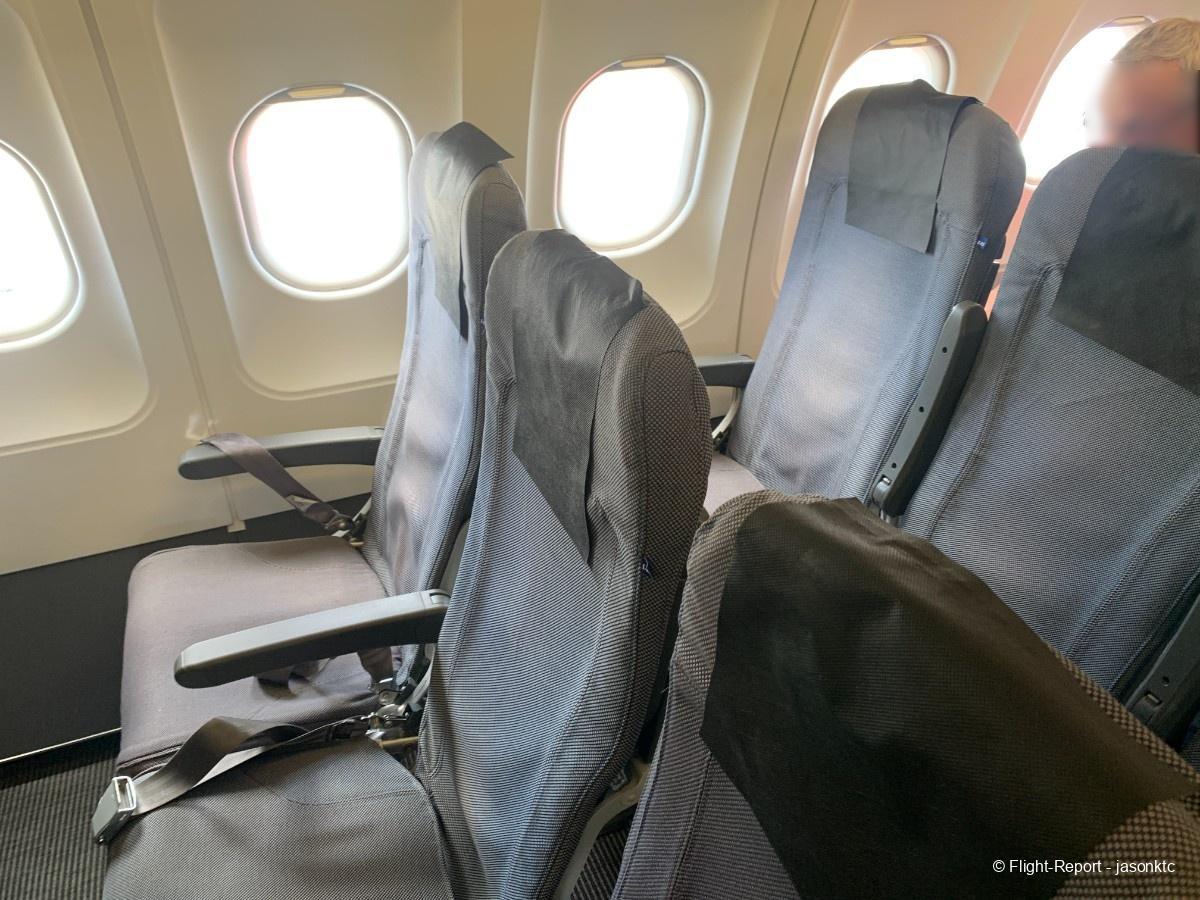
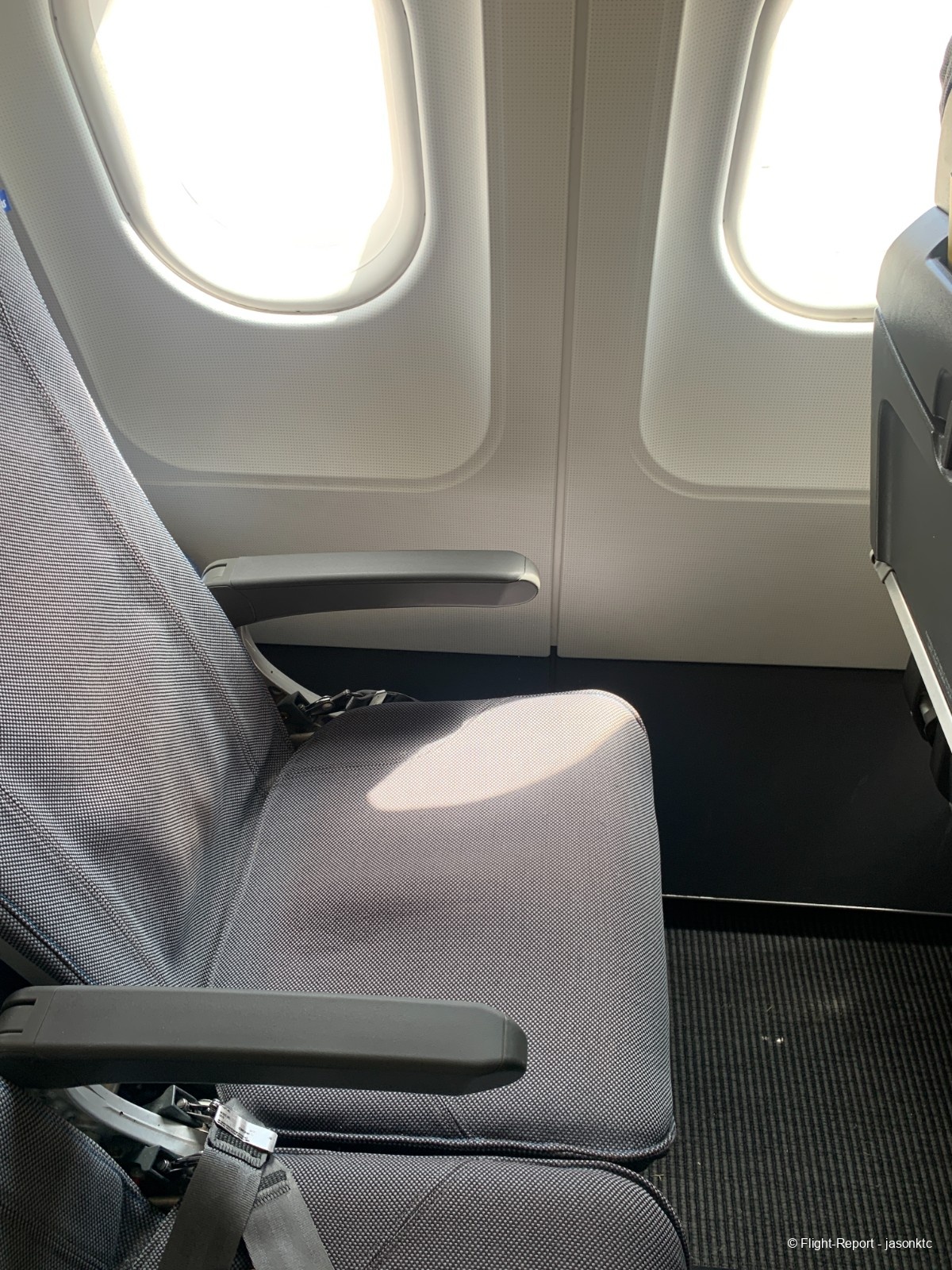
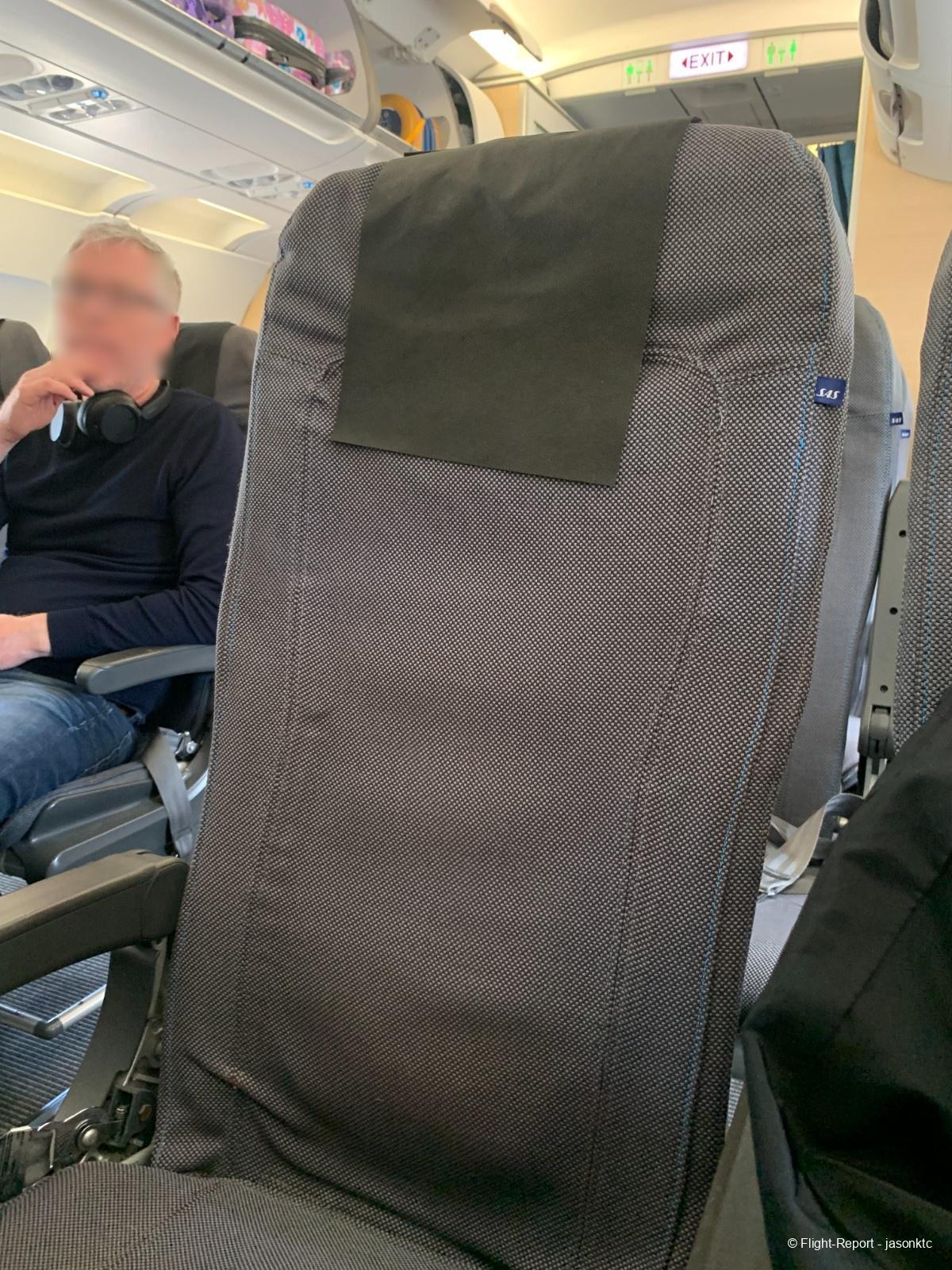
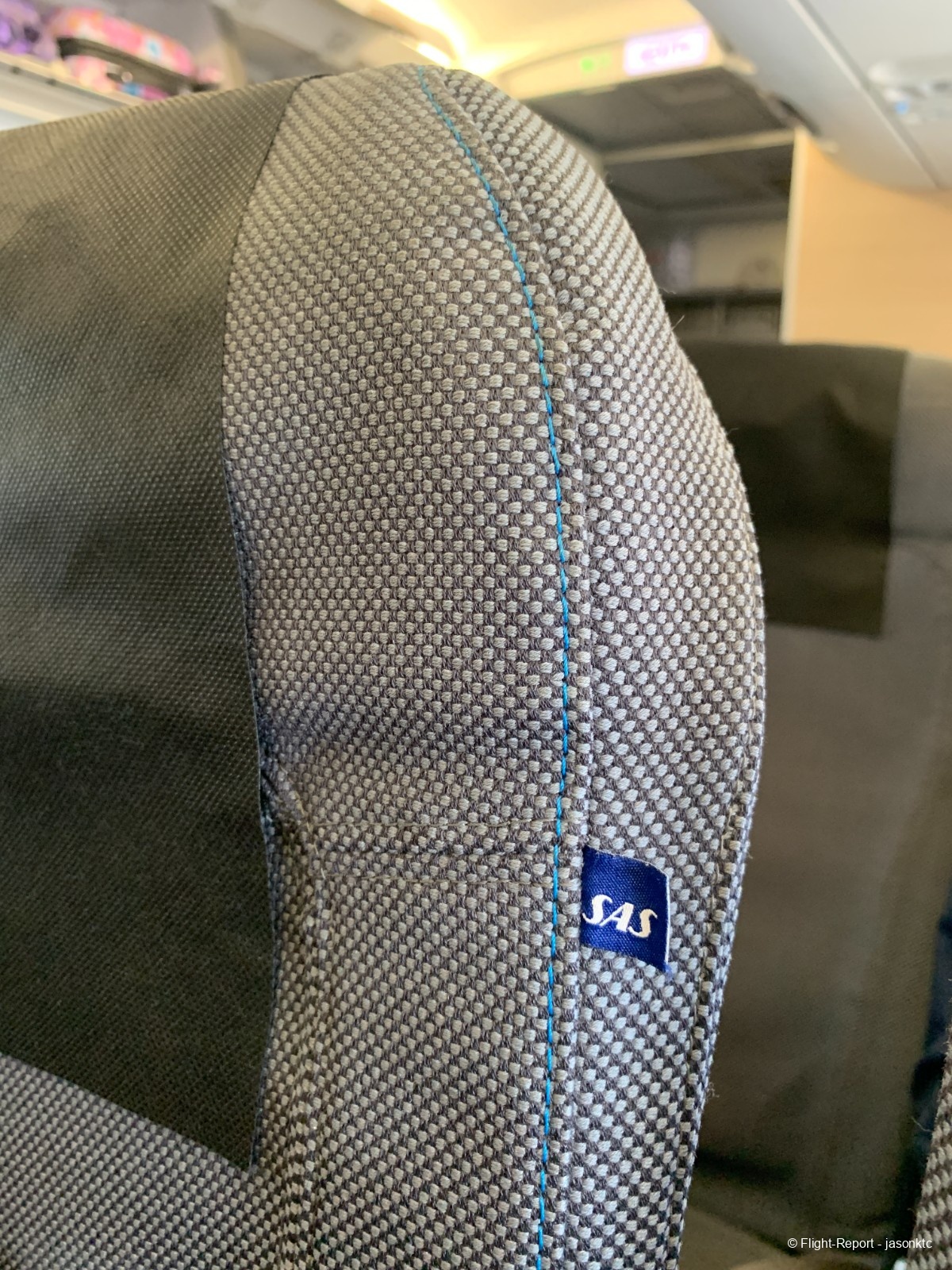
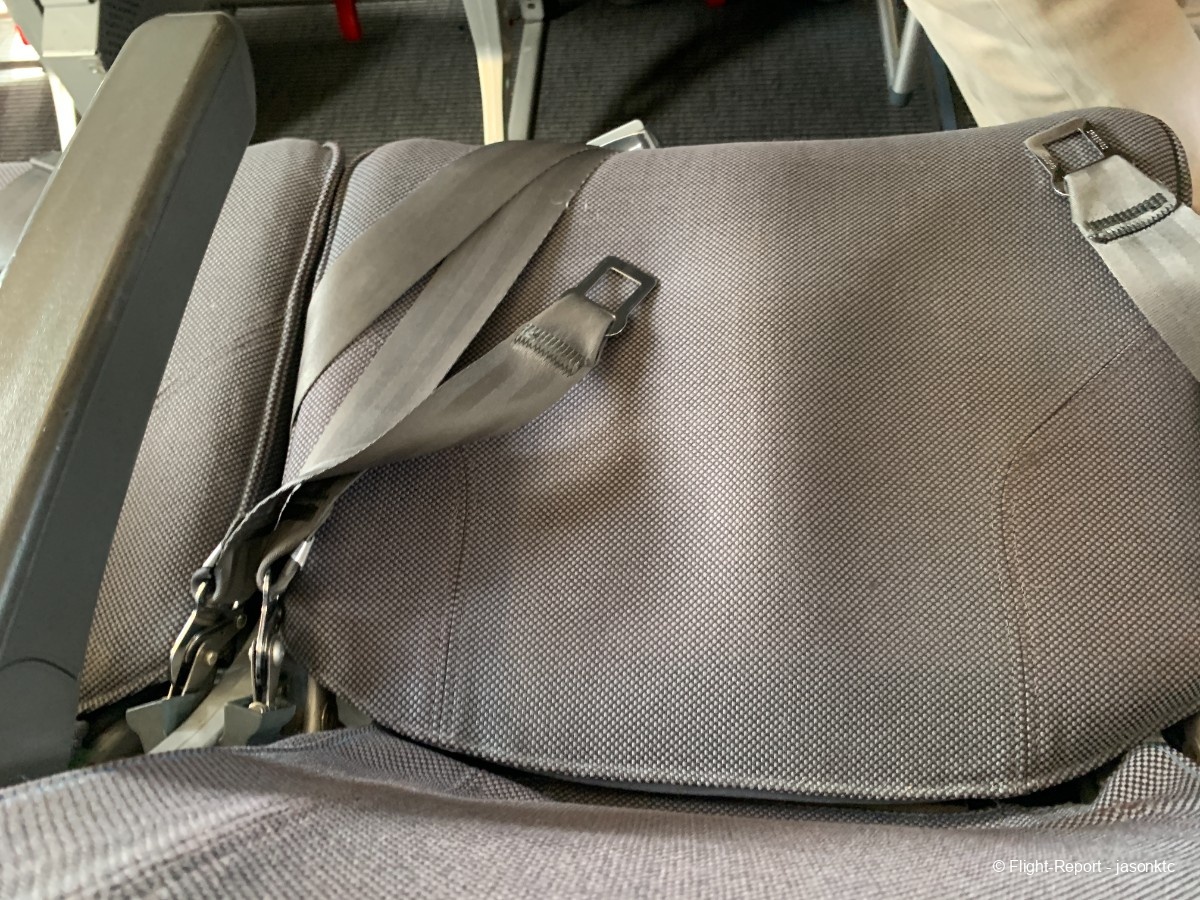
The overhead panel is of older design. But I am glad there are individual air nozzles.
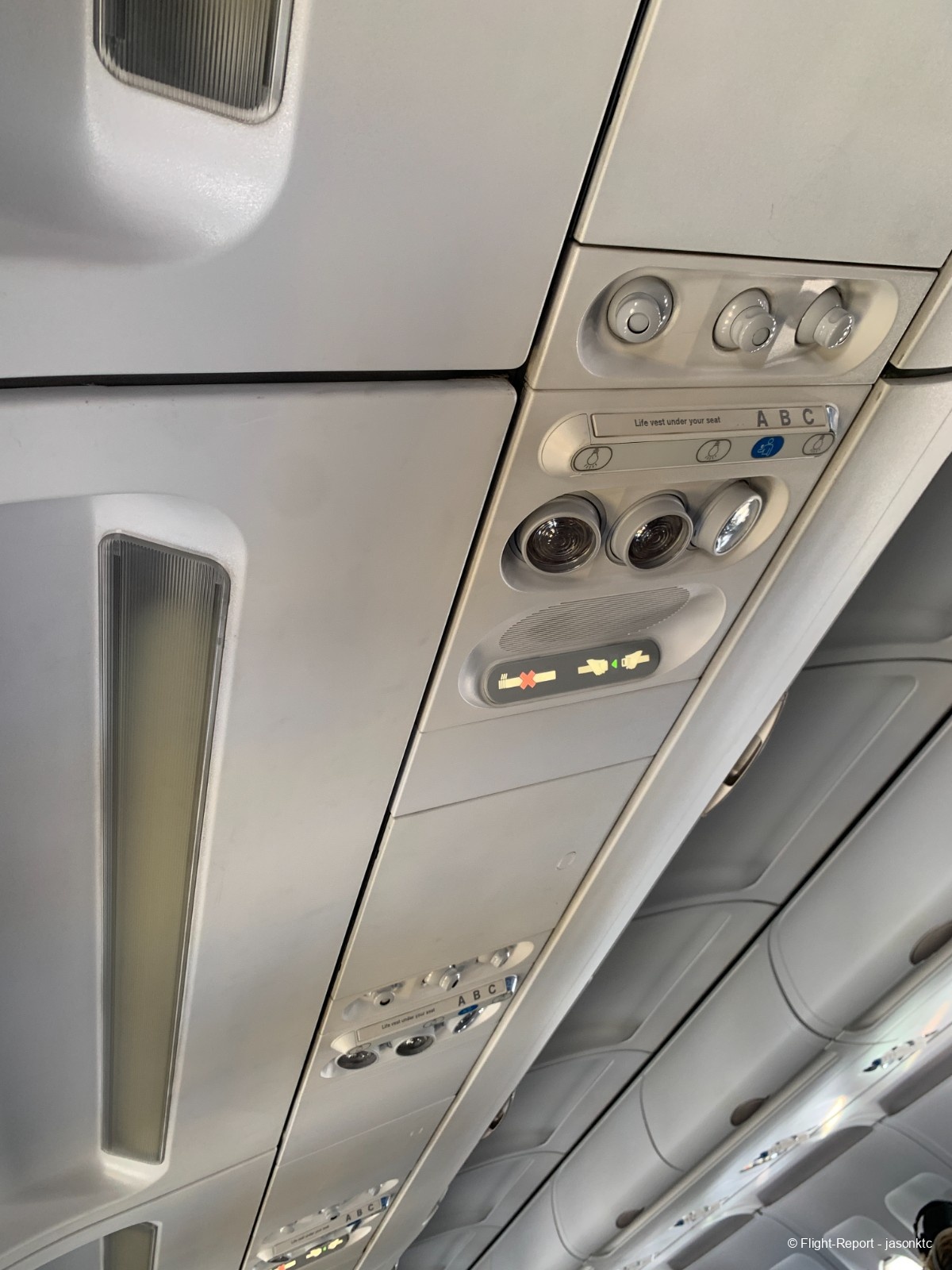
I assigned myself seat 26A. Like most slimline seats on narrow-bodies, the seatback is divided into three parts. The literature pocket at the top, tray table in the middle and small-sized seat pocket at the bottom. There is also a USB-A charging port on each seat but has no socket. I am 175cm tall, and I found the legroom to be quite generous when sitting upright. The padding is average given the slimline design but totally acceptable for a two-hour flight to Oslo. The only thing I dislike about these Recaro BL3520 seats is the lack of proper headrest.
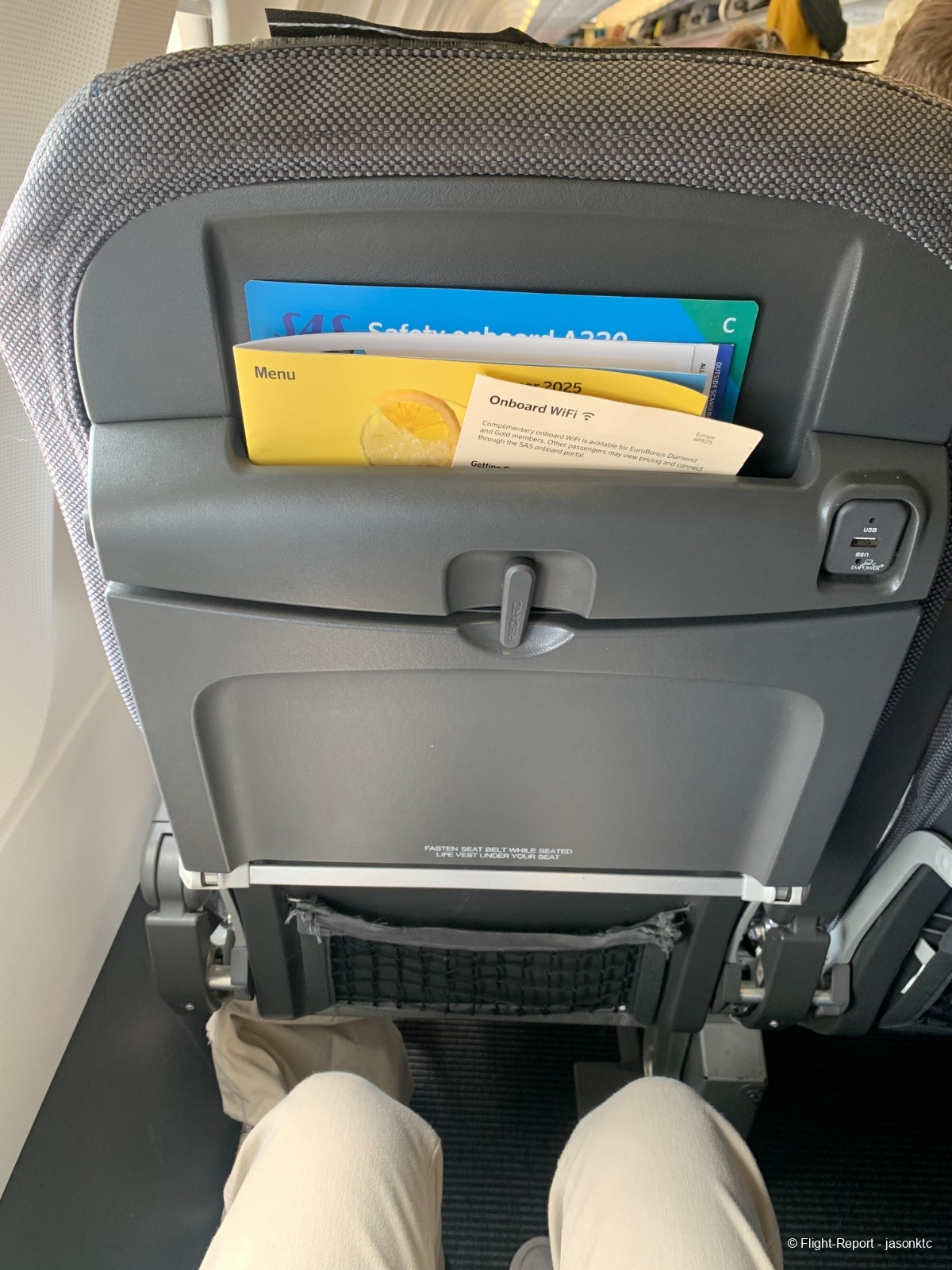
The tray table when opened. The size is decent but it does not have a folding design. The cleanliness of my seat definitely had some room for improvement, as there was some gums sticking inside the literature pocket and on the air sickness bag. The seat pocket at the bottom is also showing some wear and tear.
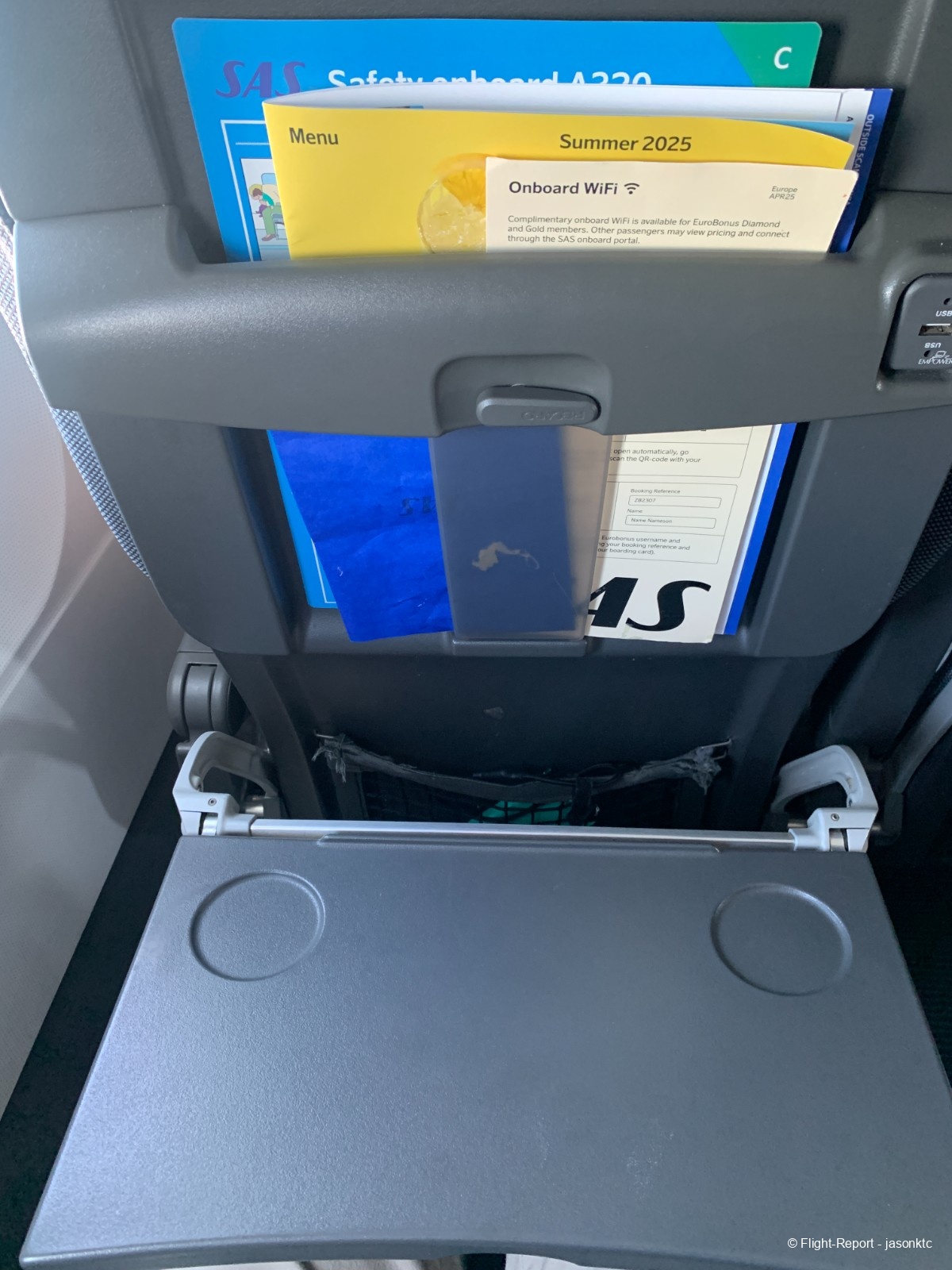
Departure from MAN:
Although the flight was relatively full, we managed to pushback five minutes ahead of schedule at 12:50. I saw two A321neos that belong to Turkish Airlines and Air Transat during taxi.

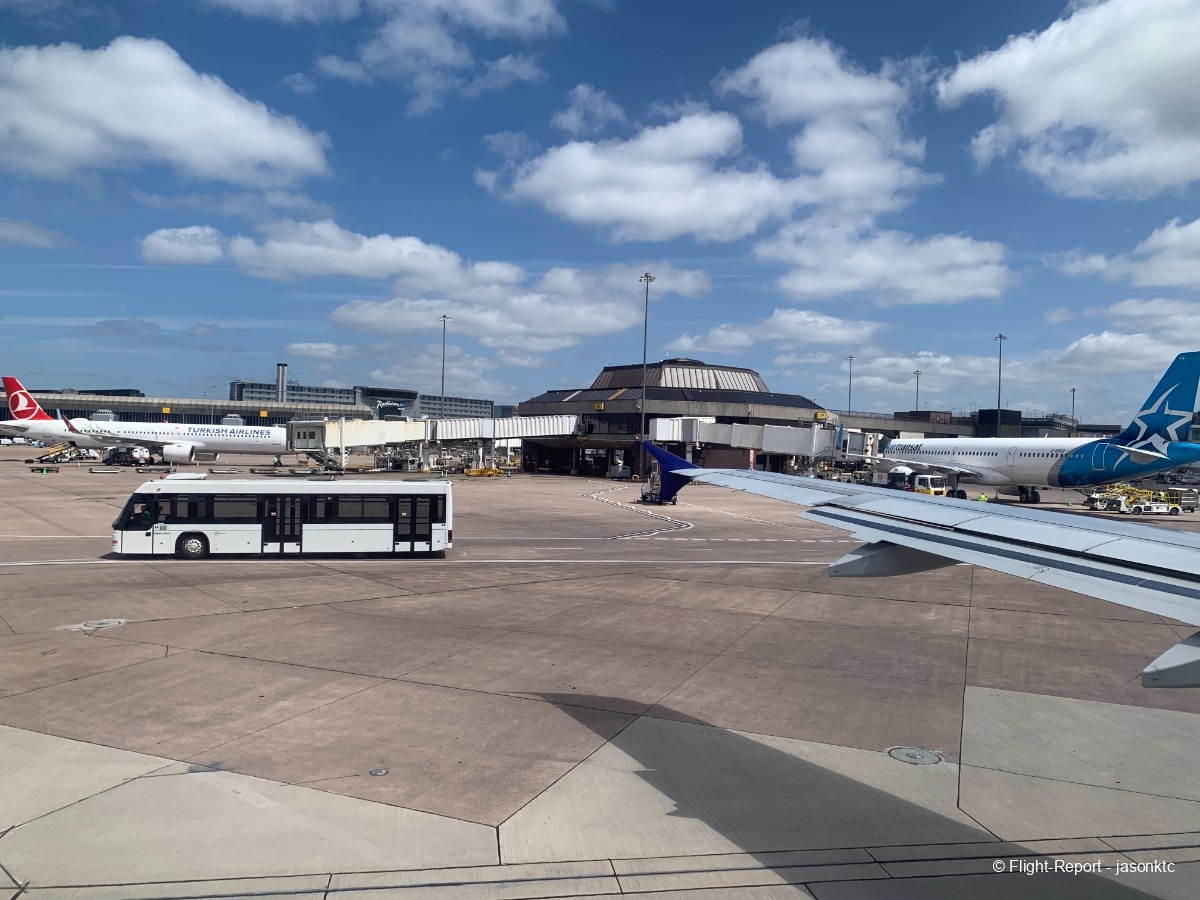
Taxiing took around 10 minutes and we took off from runway 23L at 13:02. Departing from runway 23L also meant that we can wave to the plane-spotters at MAN's southside viewing area located on a slope next to the start of the runway. Can you spot them?
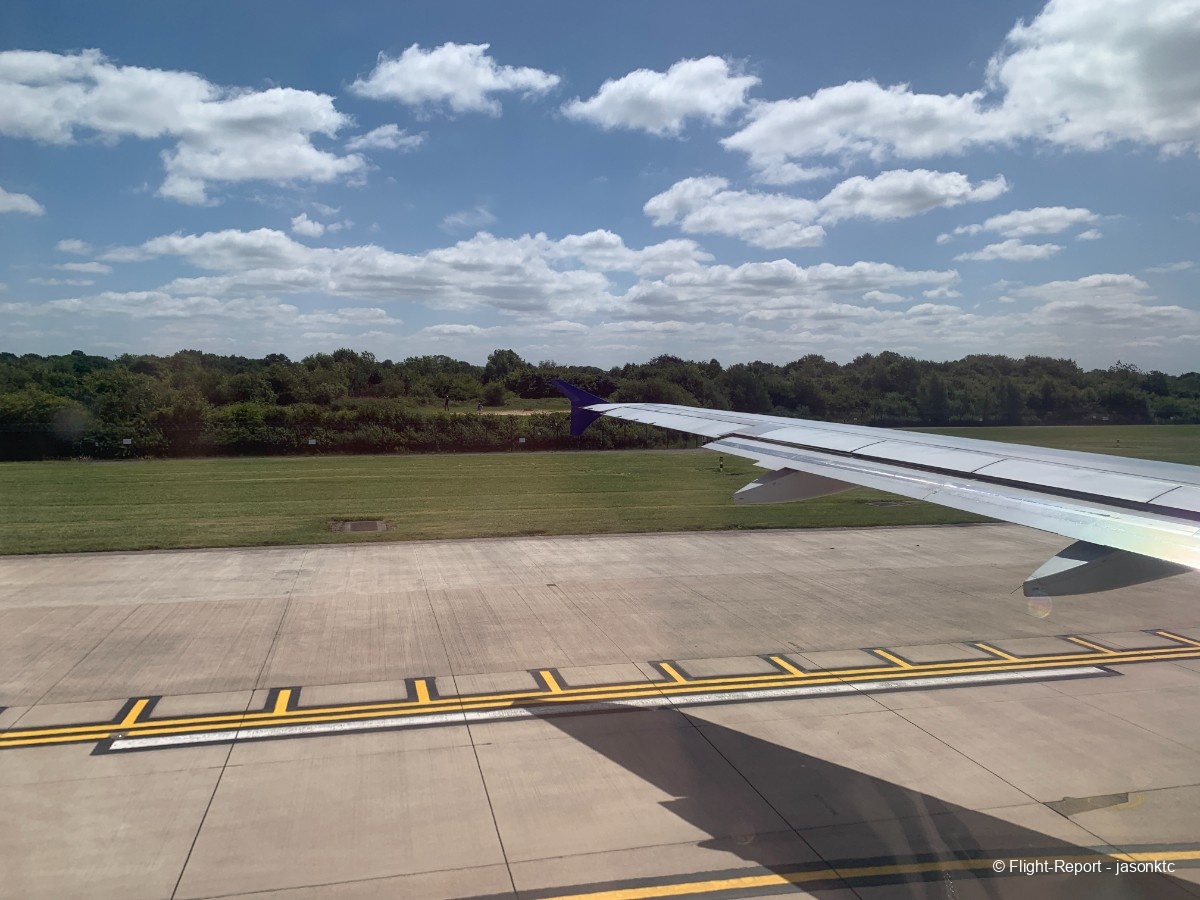
I was at this exact spot few months before my trip to Norway. It was probably one of the closest viewing spot to a runway in the world. You could even see the pilots of wide-body planes waving at us with your naked eyes. The roaring engine sound, especially from the A330s, when they rolled for takeoff was extremely loud. It was one kind of an experience and I highly recommend anyone to go there for some close-up plane-spotting or even a picnic. Below is a photo I took when I was there: a SAS Connect A320neo (EI-SIV) that was also bound for Oslo. The focal length that I used for this photo is 135-150mm.
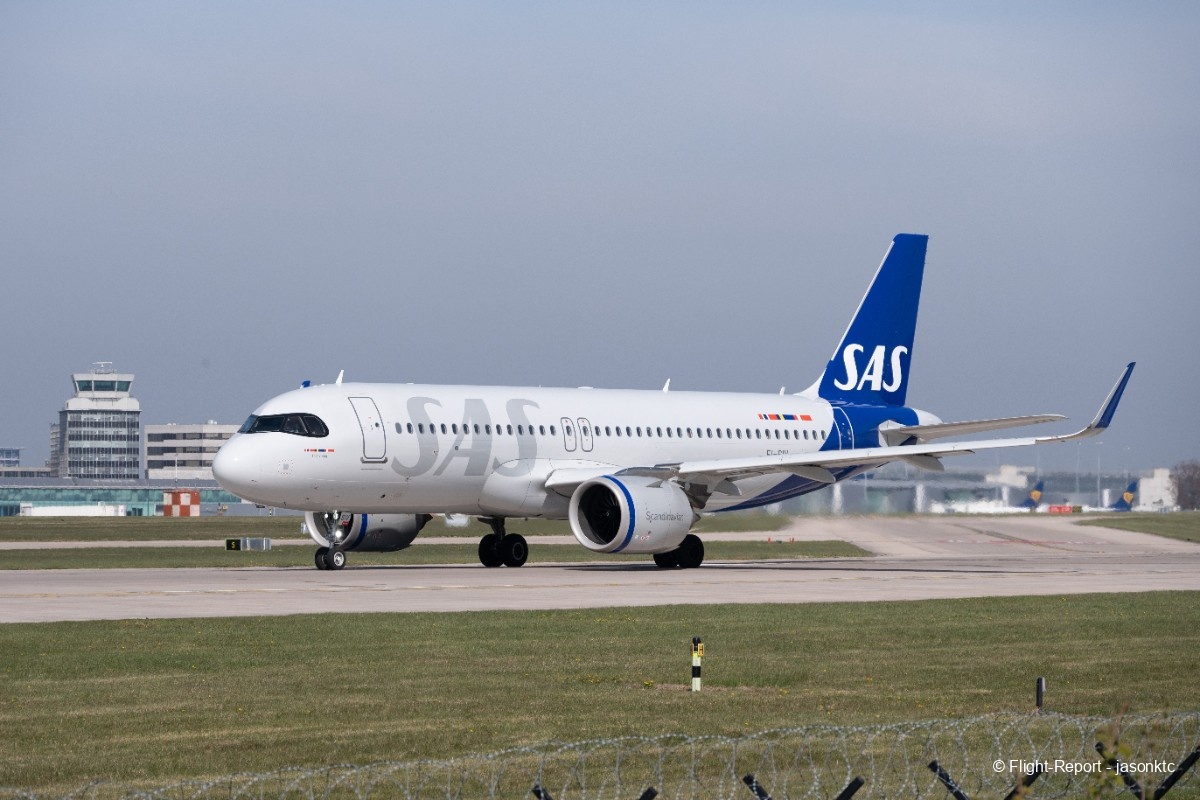
The pair of IAE-V2500 engines took OY-KAP to the air towards southwest with their distinctive buzzsaw sound. The weather was quite calm with some scattered clouds, which gave us a smooth climb and a nice view of Greater Manchester area and Northwest of England after turning to fly towards northeast.

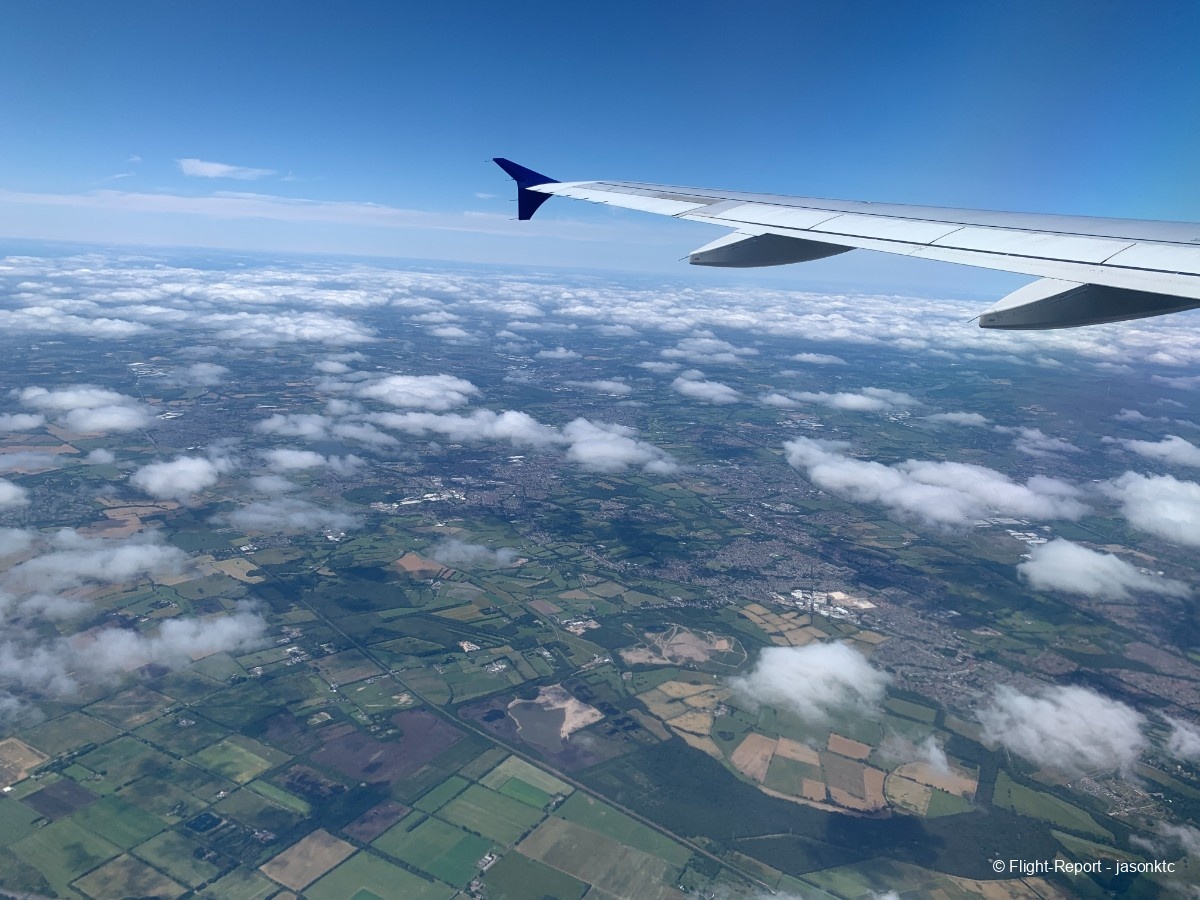
Literature Materials and Wifi Service:
Once airborne, I took a look at what was inside the literature pocket.

There was a safety card, a blue air sickness bag with SAS branding and a card about the onboard wifi service. The wifi service is only complimentary for EuroBonus (SAS's frequent flyer programme) Diamond and Gold members. I wonder will EuroBonus be replaced by Air France-KLM Group's Flying Blue programme after the Group's acquisition.
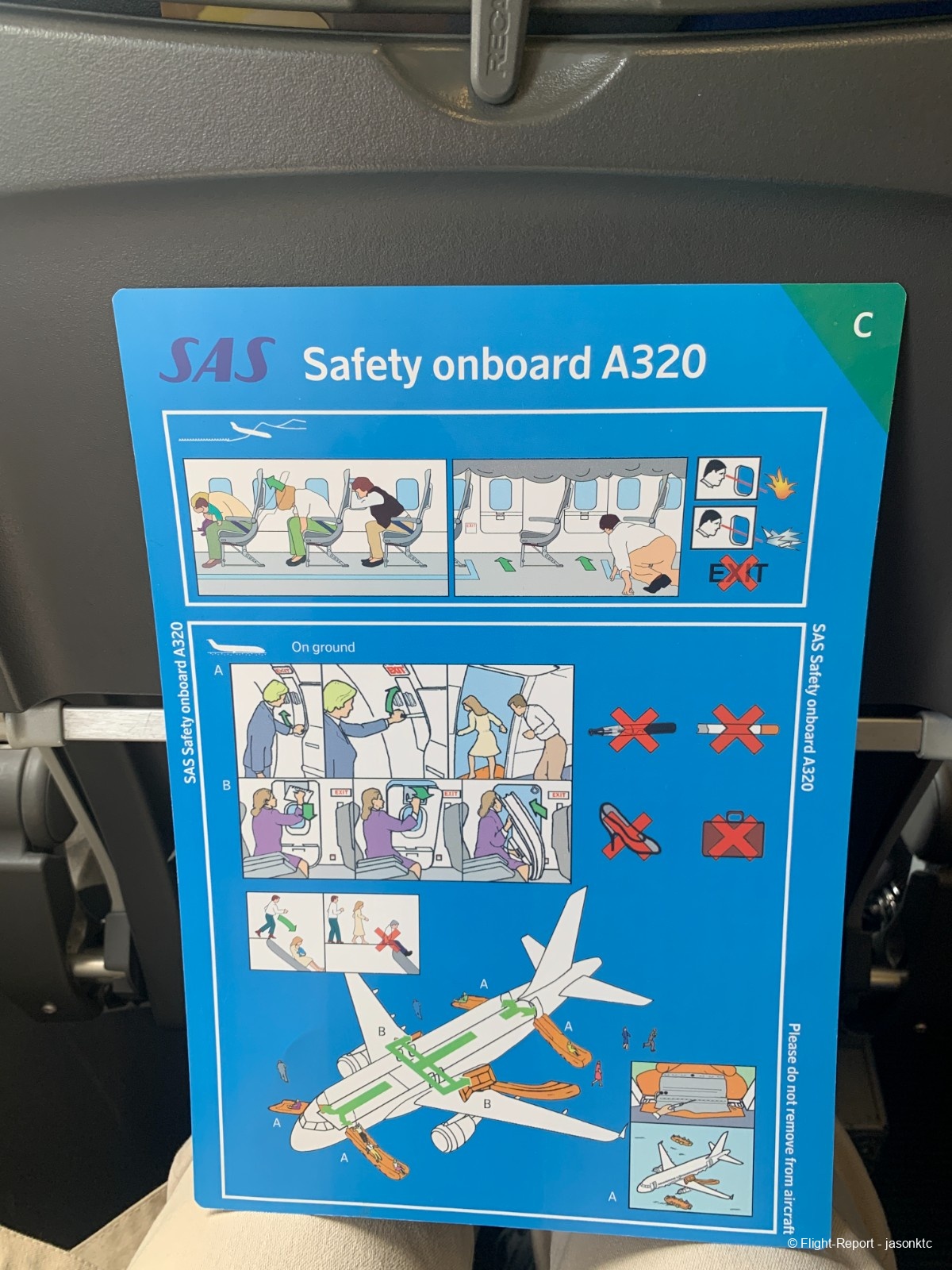

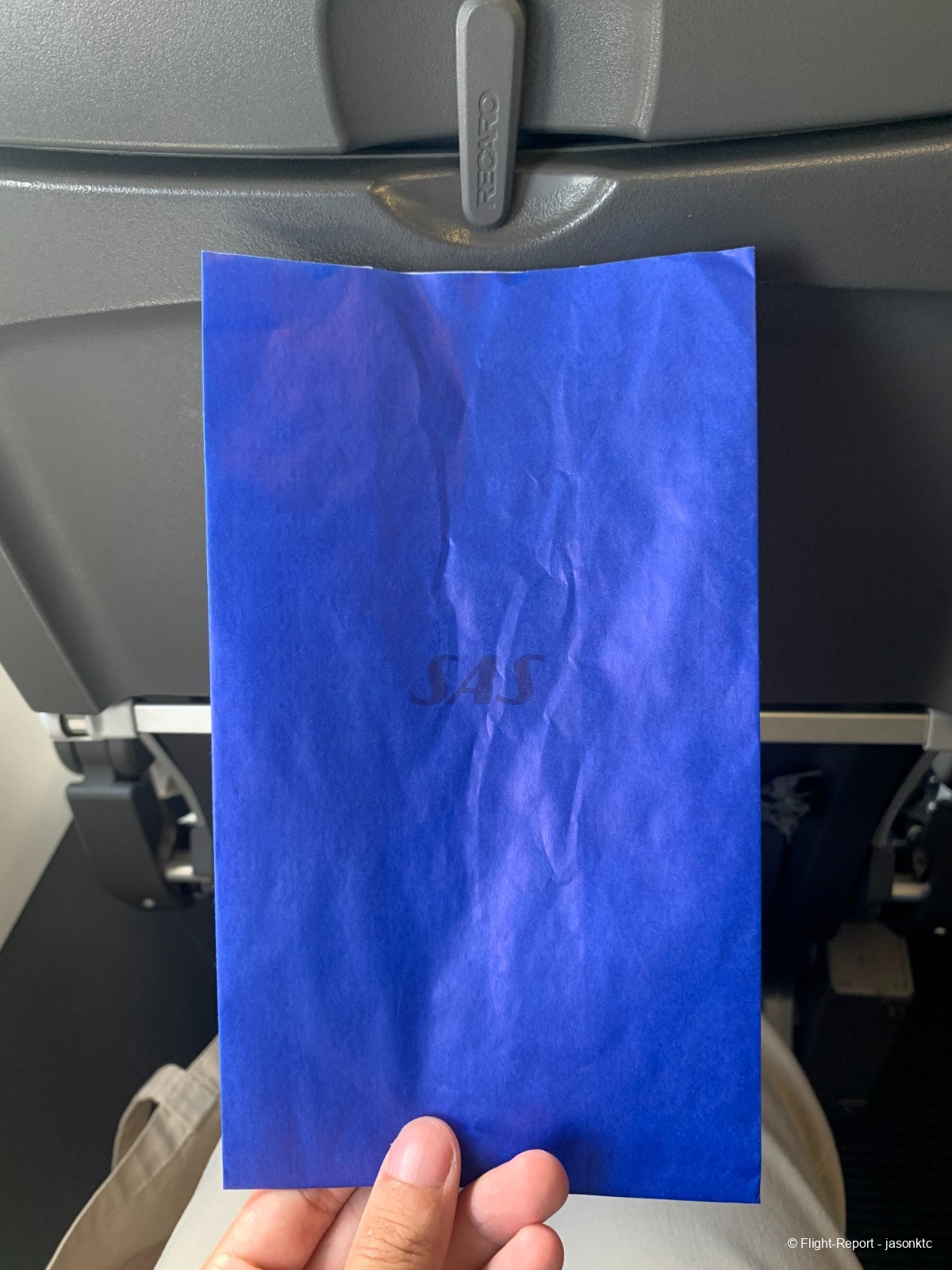
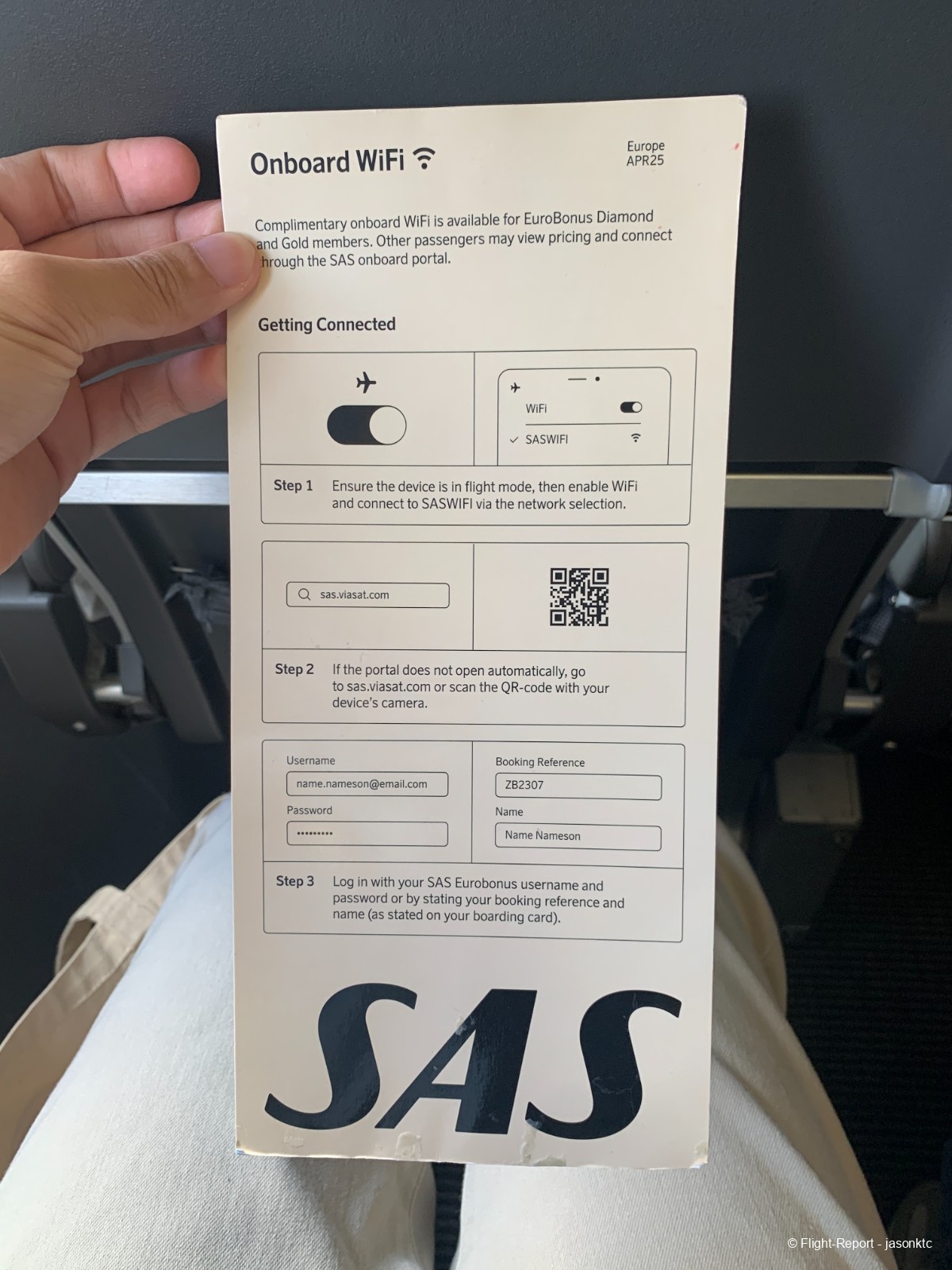
And of course there was the inflight menu with a selection of snacks, light meals and both alcoholic and non-alcoholic beverages, in case passengers did not pre-order any meals.
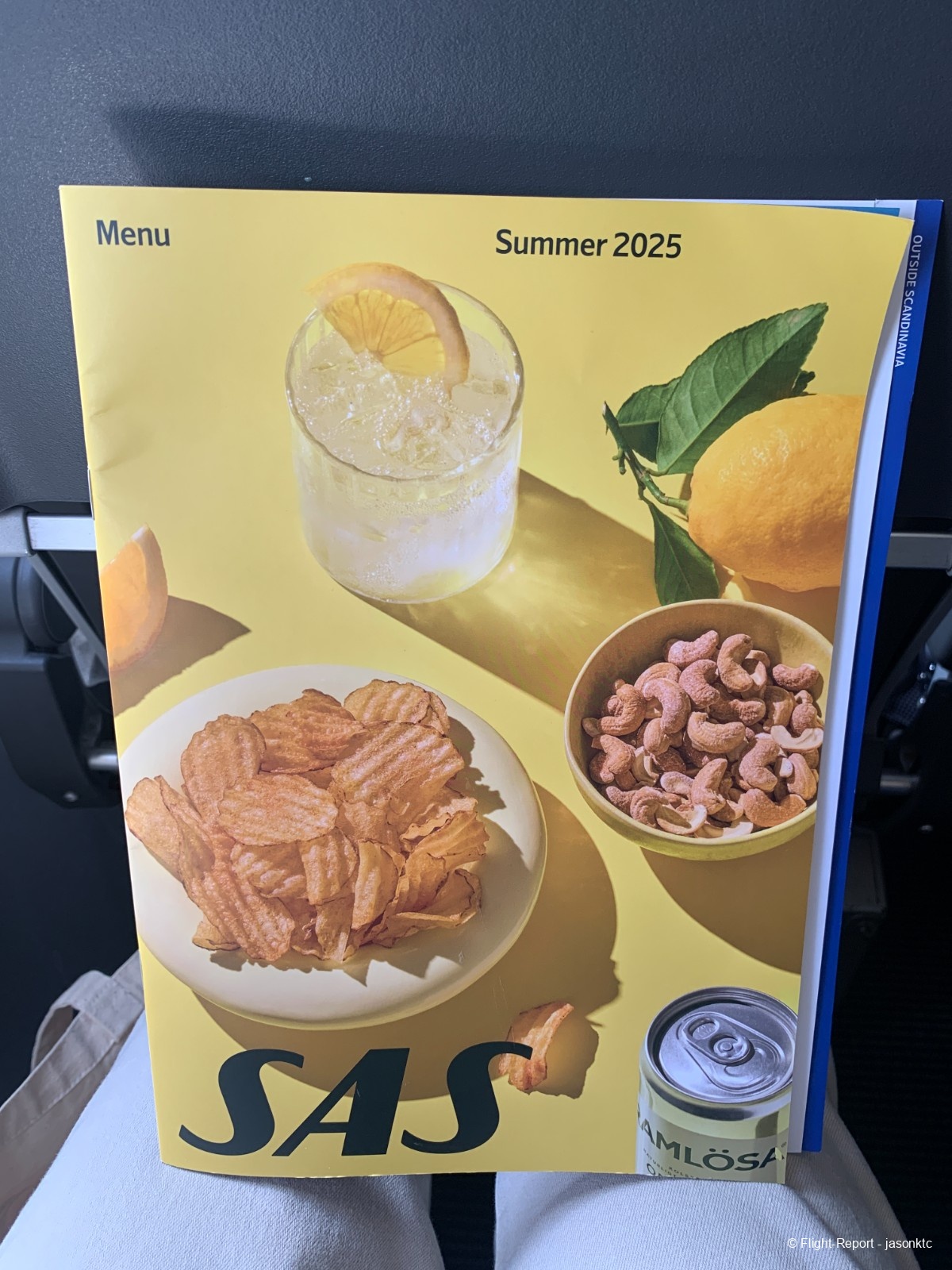
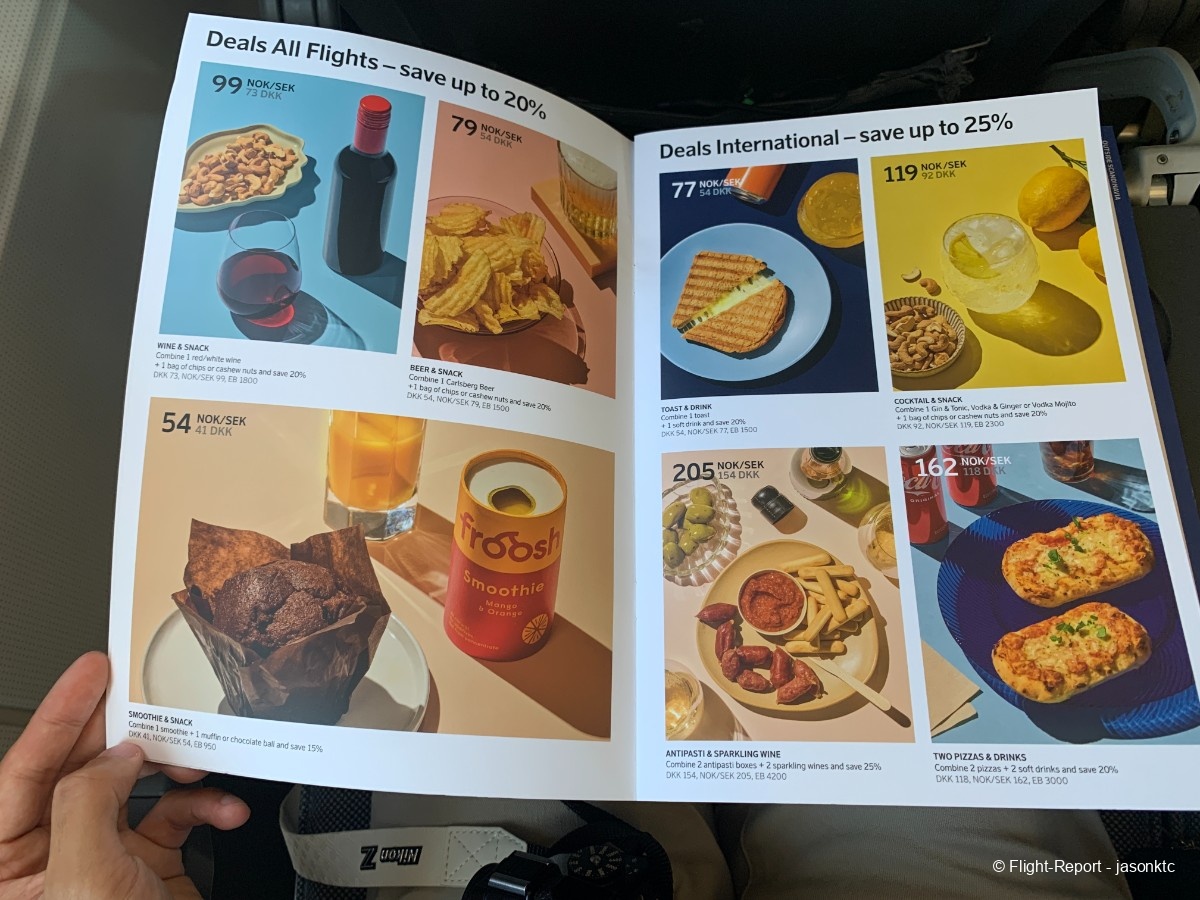
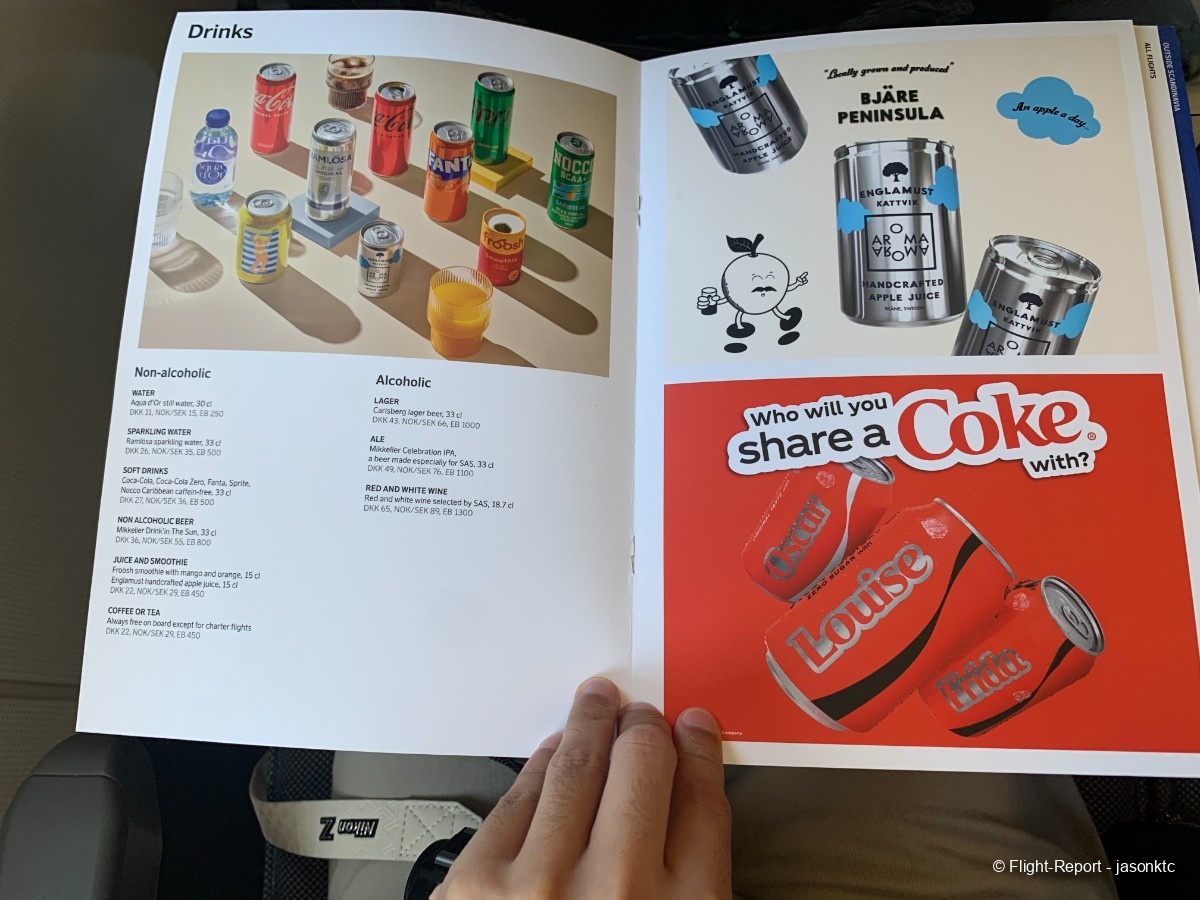
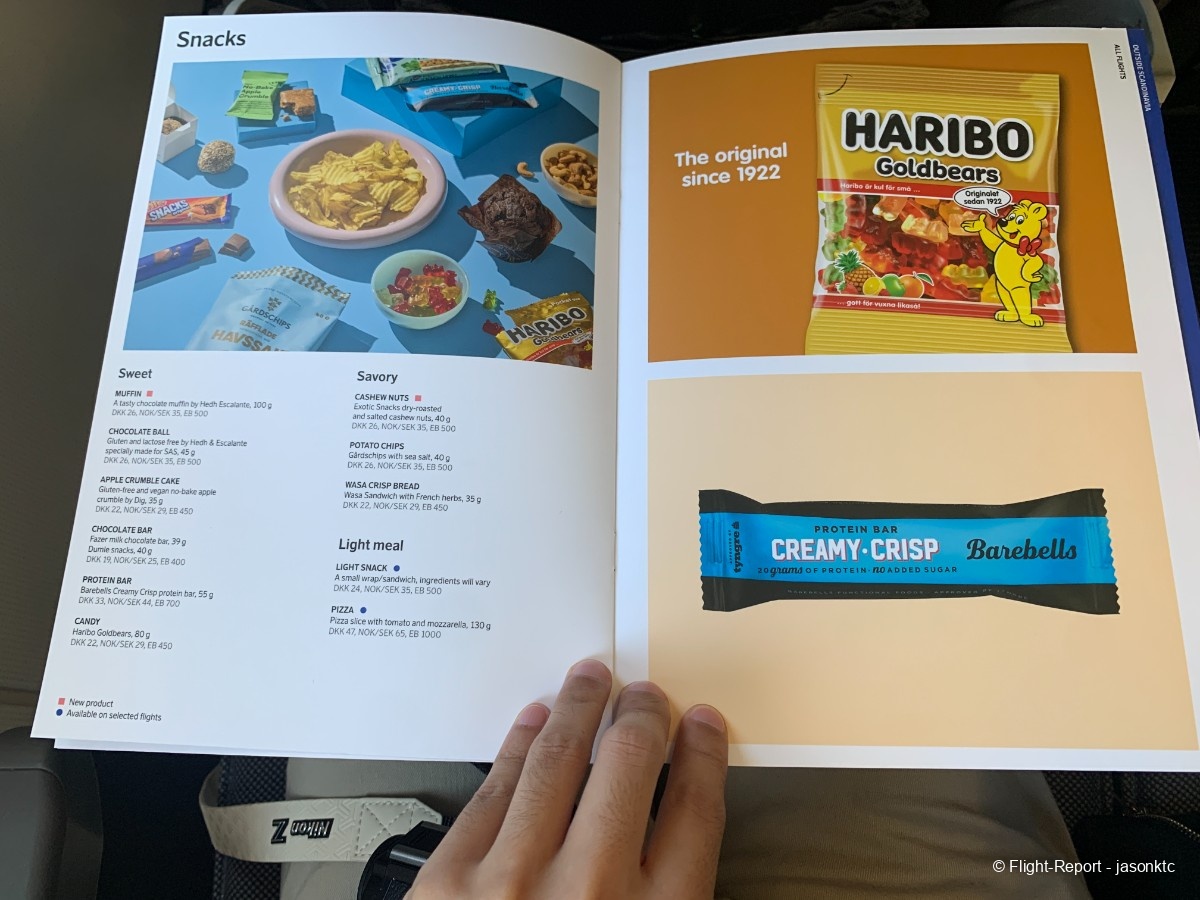
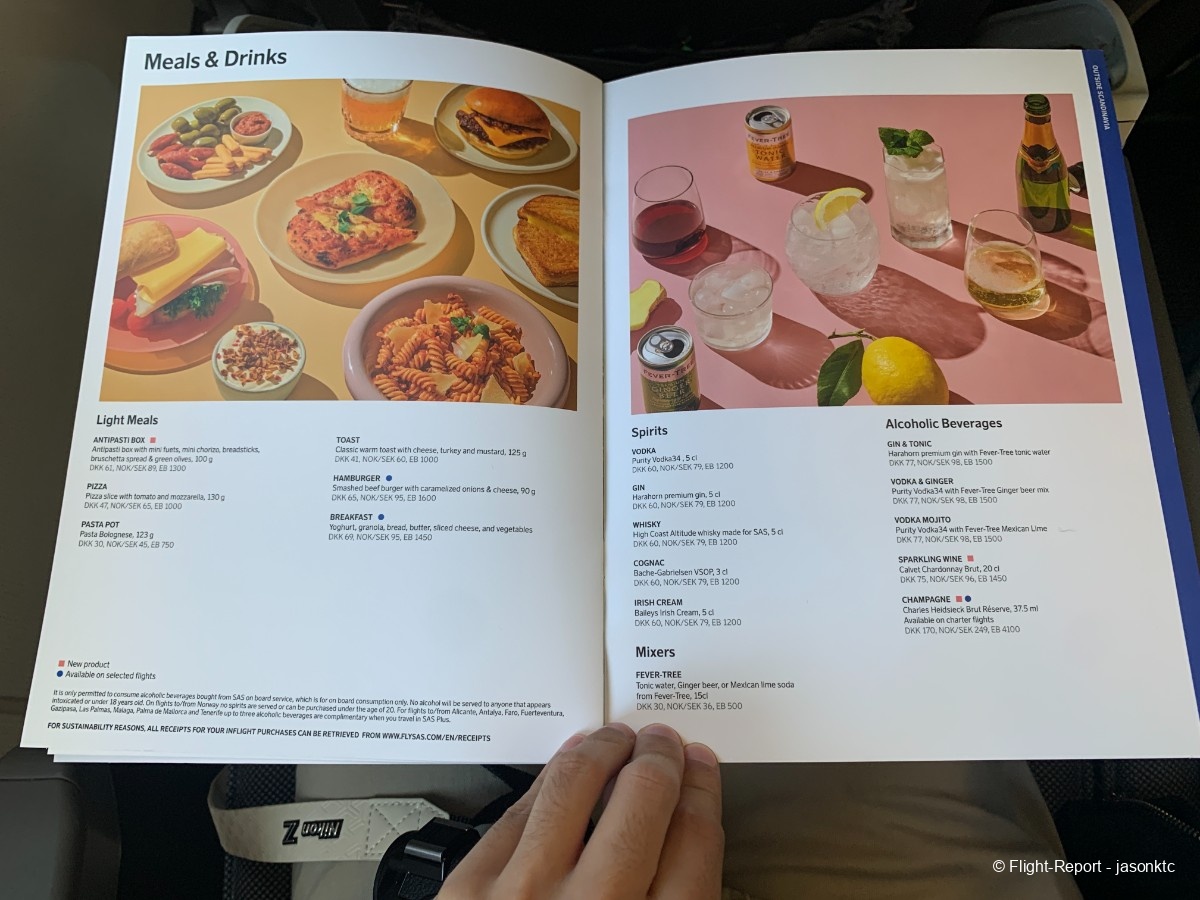
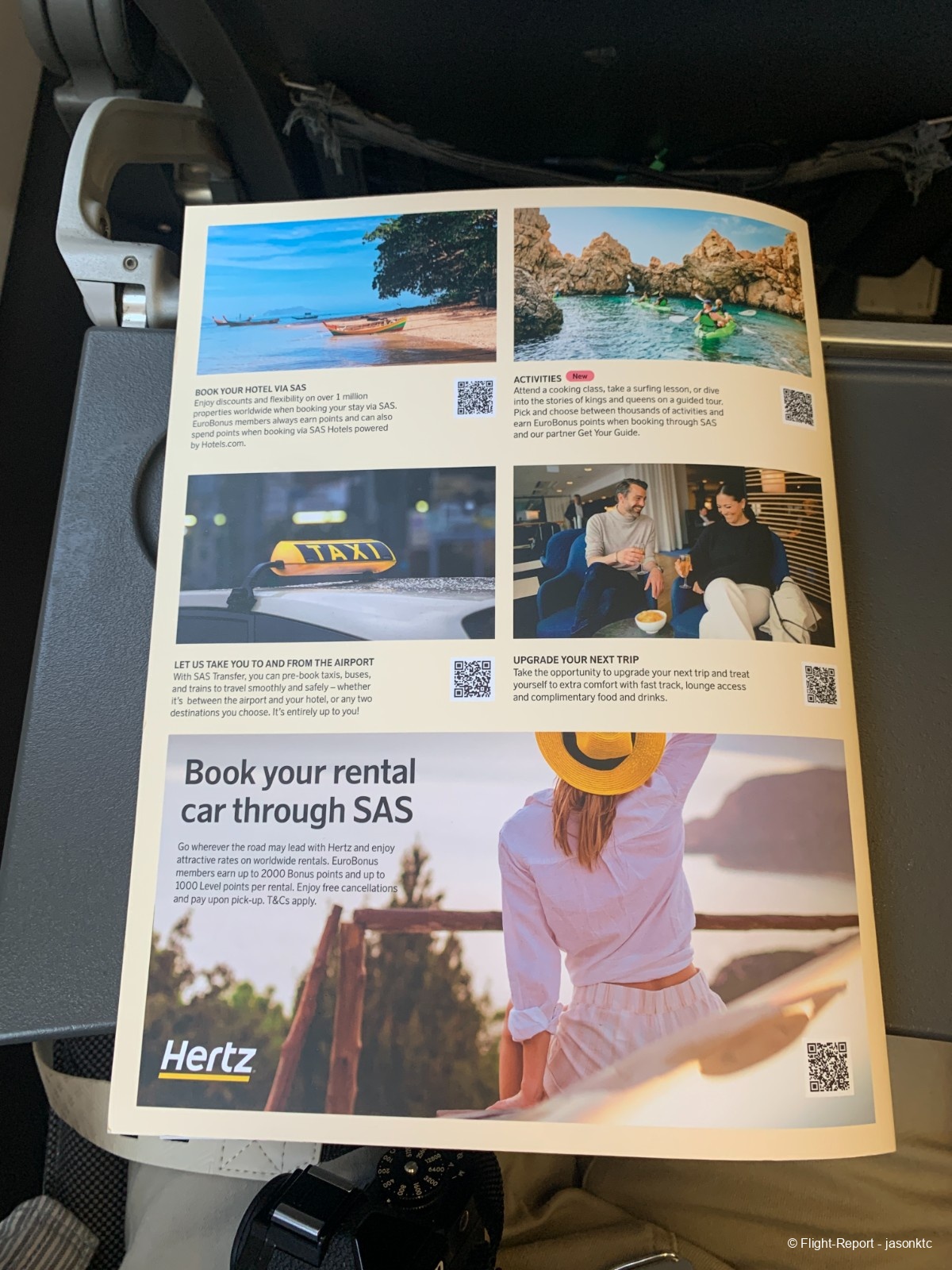
Meal Service:
The seat belt sign was switched off about 7-10 minutes after takeoff. Then, a complementary tea/coffee/water service was served by the flight attendants. I ordered a cup of tea and it was served in a light pink, SAS-branded paper cup. Afterwards, my pre-ordered chicken meal was efficiently handed over by one of the flight attendant 17 minutes after takeoff. You can also clearly notice how excited I was about travelling to Norway!

The meal was inside a cardboard box. On the box, there was a label that read "Grilled chicken breast with quinoa salad, celeriac and sultana raisin pickled cucumber and za'atar yogurt cream."
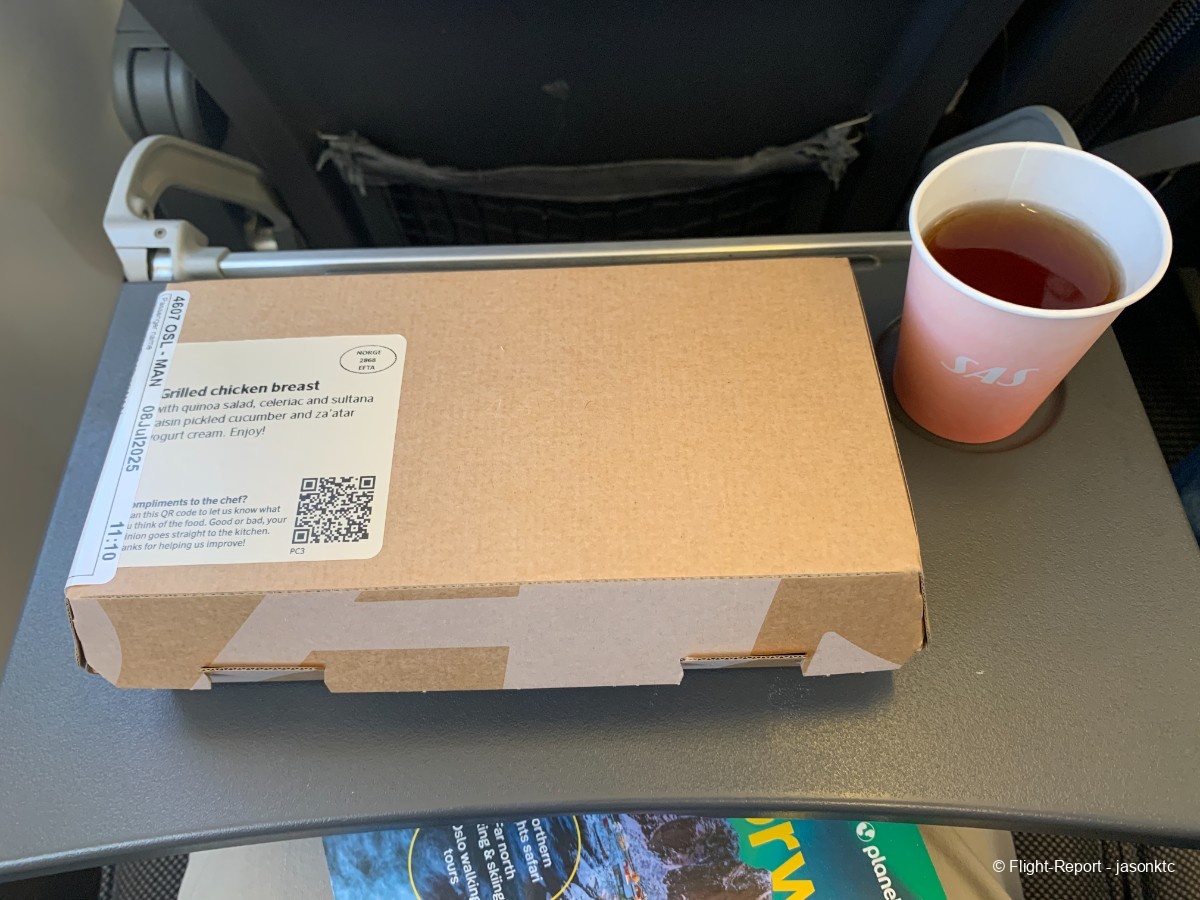
The dish was wrapped in a plastic packaging with a white cardboard container. There was also a pack of rågknäcke (rye crackers), a crispbread that is commonly eaten in Nordic countries.
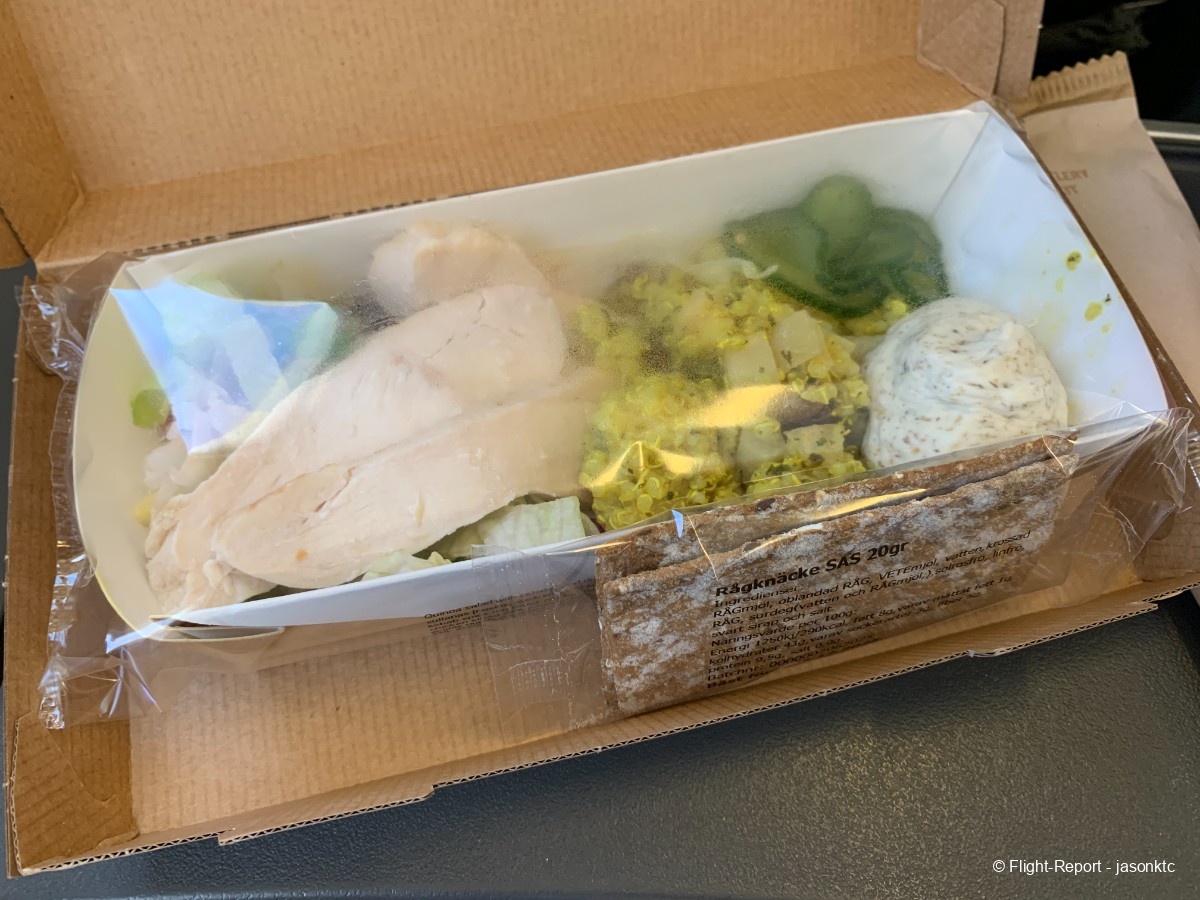
A closer look of the meal after removing the plastic packaging. I think the presentation was decent. The three pieces of chicken breast were quite tender and soft. The vegetables were fresh, too. But the best part of the meal had to be the yogurt dressing and the quinoa. They added some zing and flavours after mixing with other ingredients. Overall, the meal was savoury, delicious and balanced. The portion was totally sufficient for a short European flights. The price (GBP 12.1) was also not too bad for its flavour and portion.
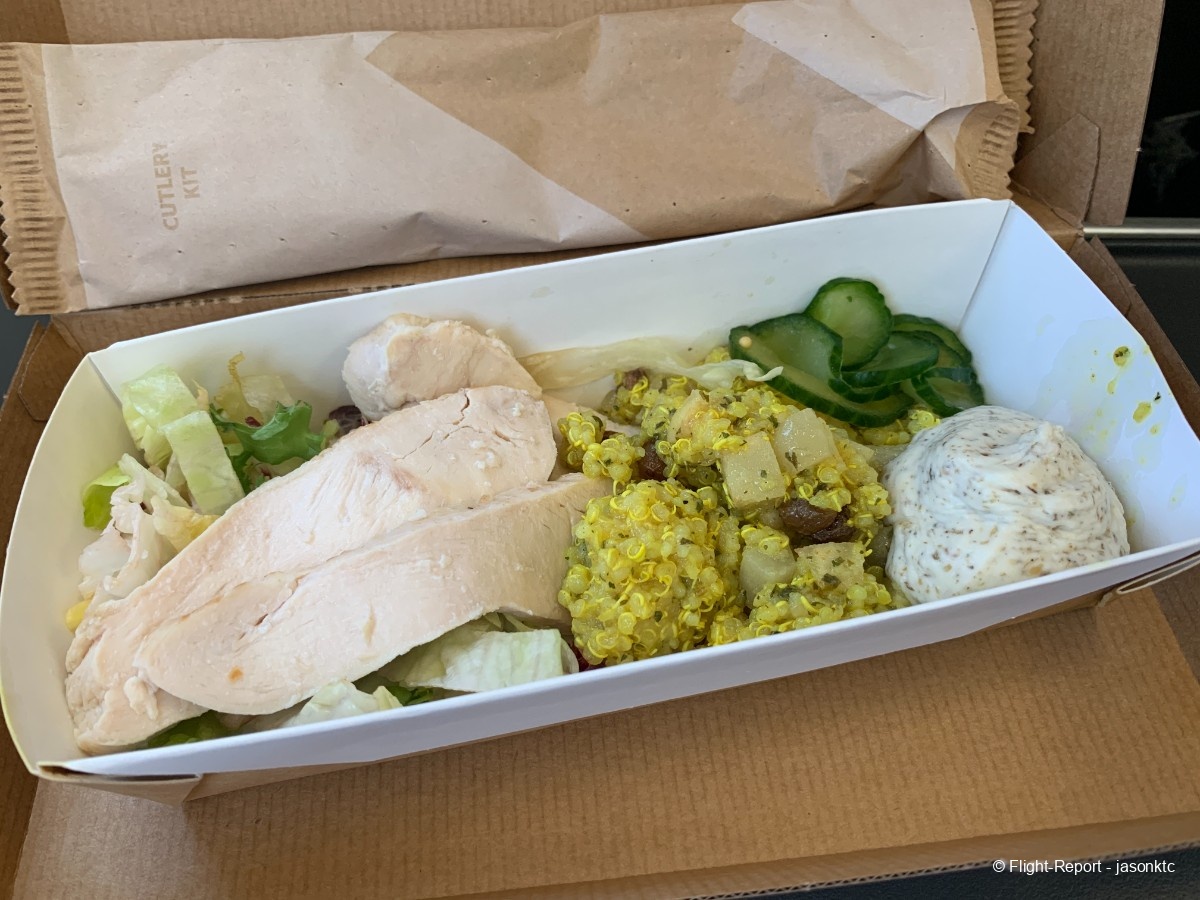
The cutleries were made by wood. I think it would be better to have metal cutleries as they look better in terms of presentation and more environmentally-friendly, too.
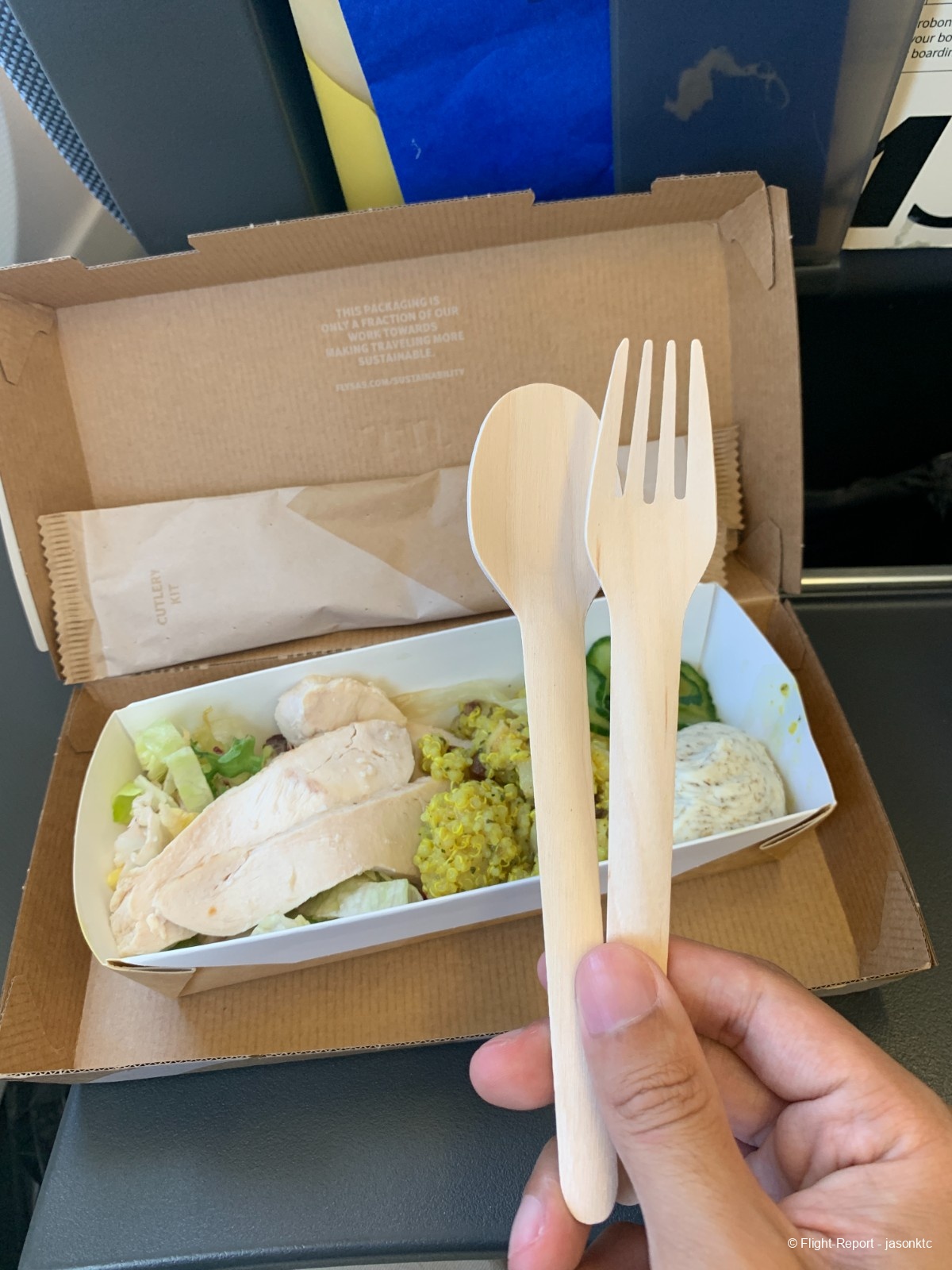
I have always enjoyed and felt grateful about inflight meals on planes. Having a meal in 30,000 feet is surreal and I always appreciate the people, the logistic and the technology that involved in making meal.
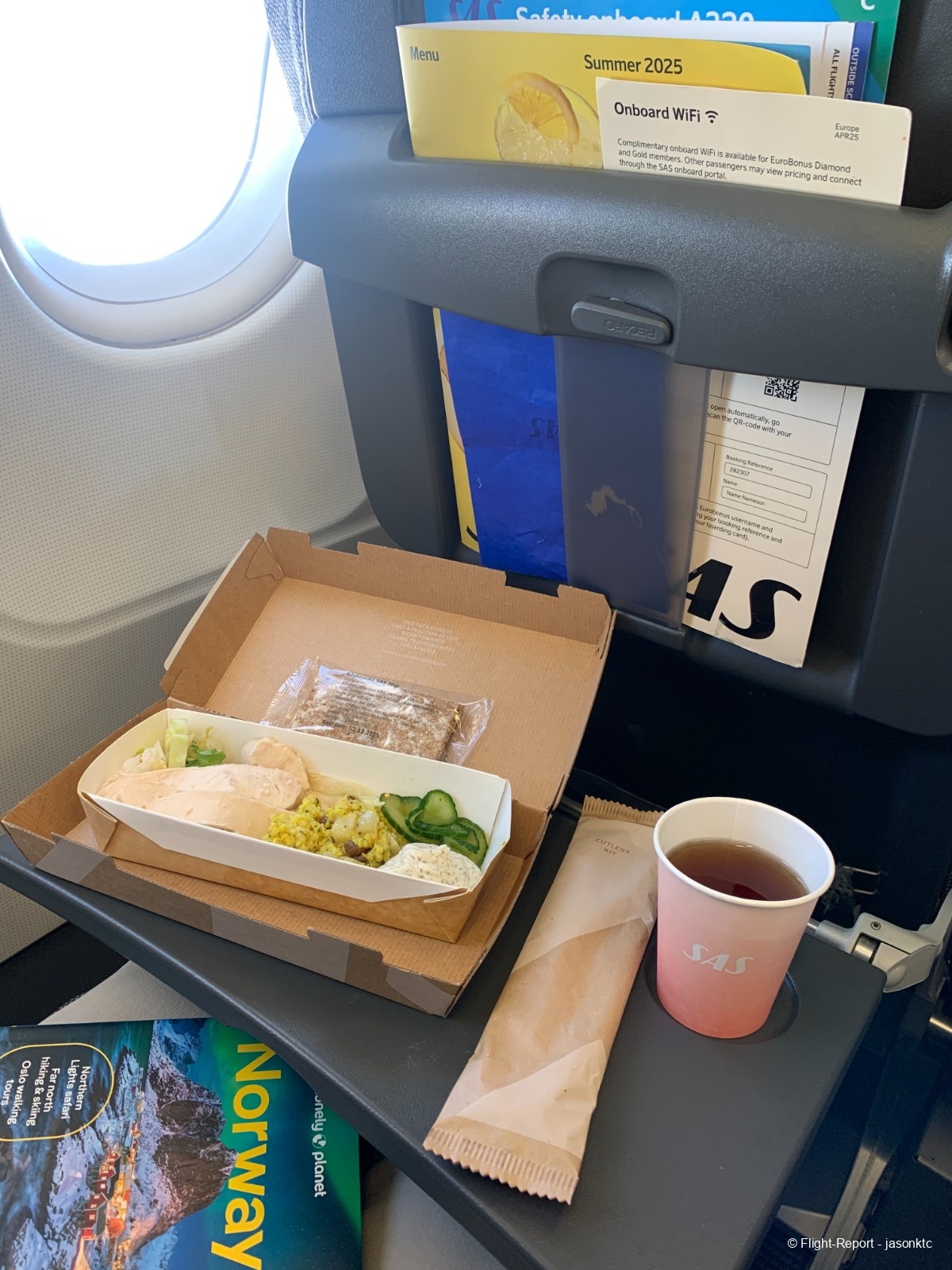
I also ordered a Celebration IPA, a session IPA made specifically for SAS by the famous Danish craft brewery Mikkeller. A SAS-branded plastic cup was also provided. The beer was flavourful, with tropical, citrusy, piney and grapefruity notes. However, the 330mL can cost NOK 76 (~ GBP 5.6), a first-hand experience of how expensive alcoholic beverages are in Norway. I paid for the beer with Mastercard via a card machine.
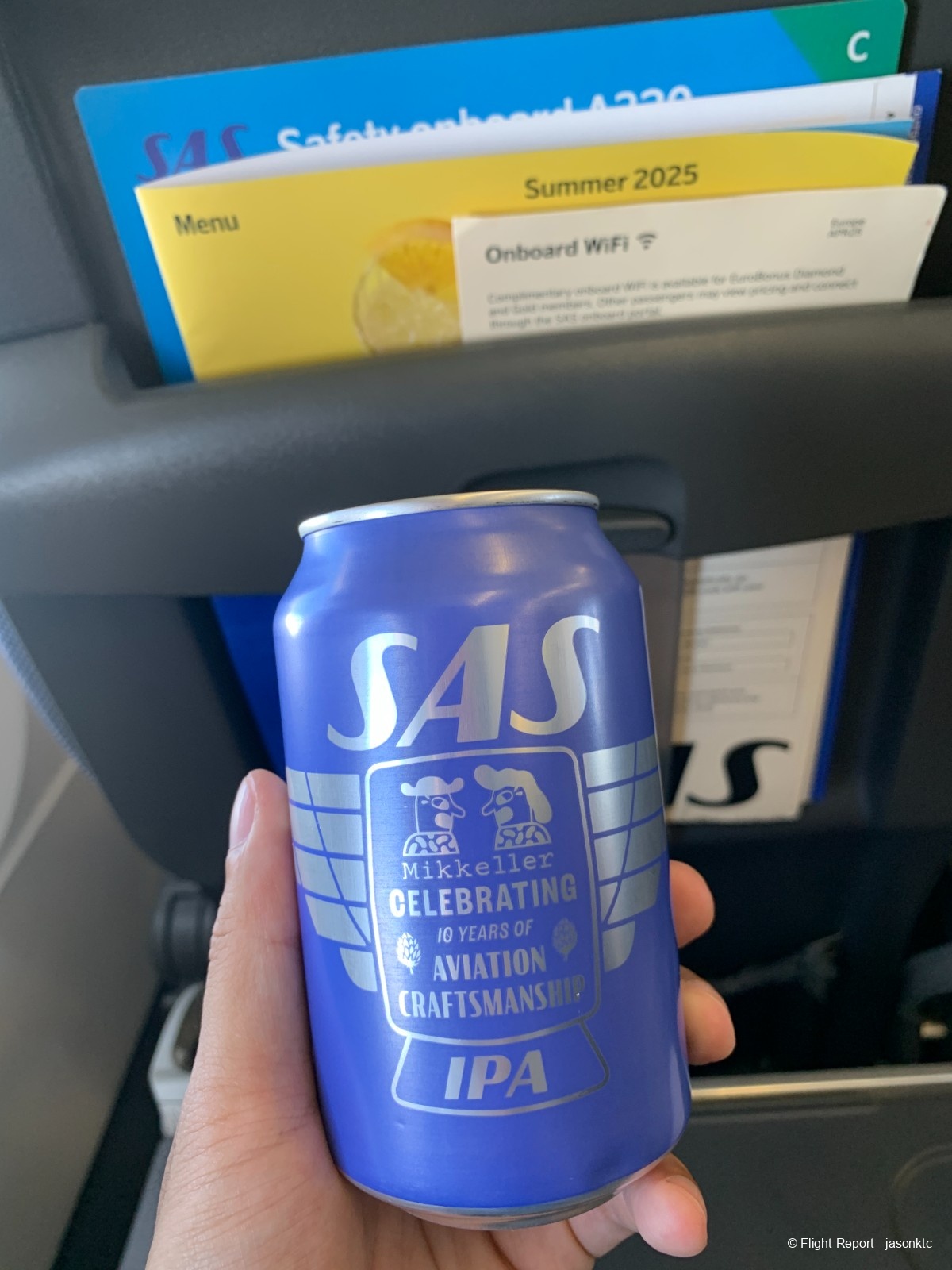
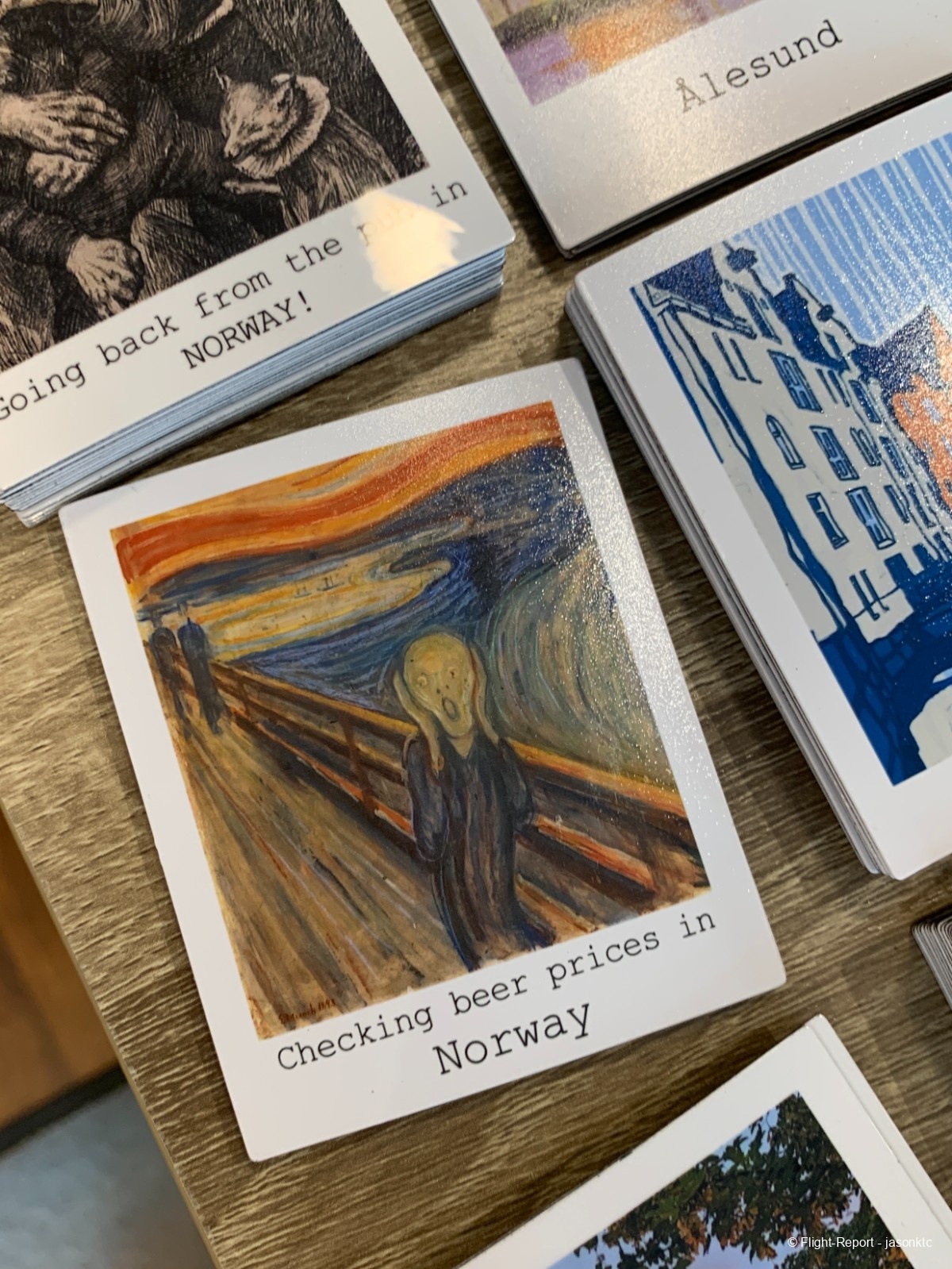
Lavatories on OY-KAP:
About one hour after takeoff, the plane approached the southwestern part of Norway. I had also finished my meal at that time and the flight attendants swiftly cleared it away. I then decided to check out the lavatories. This plane has three in total, with one at the front and two at the back. I went to the lavatory on the starboard at the back. The lavatory was quite clean and a bottle of hand-wash is provided. It had taller headroom and larger wash basin than those on newer A320neos.
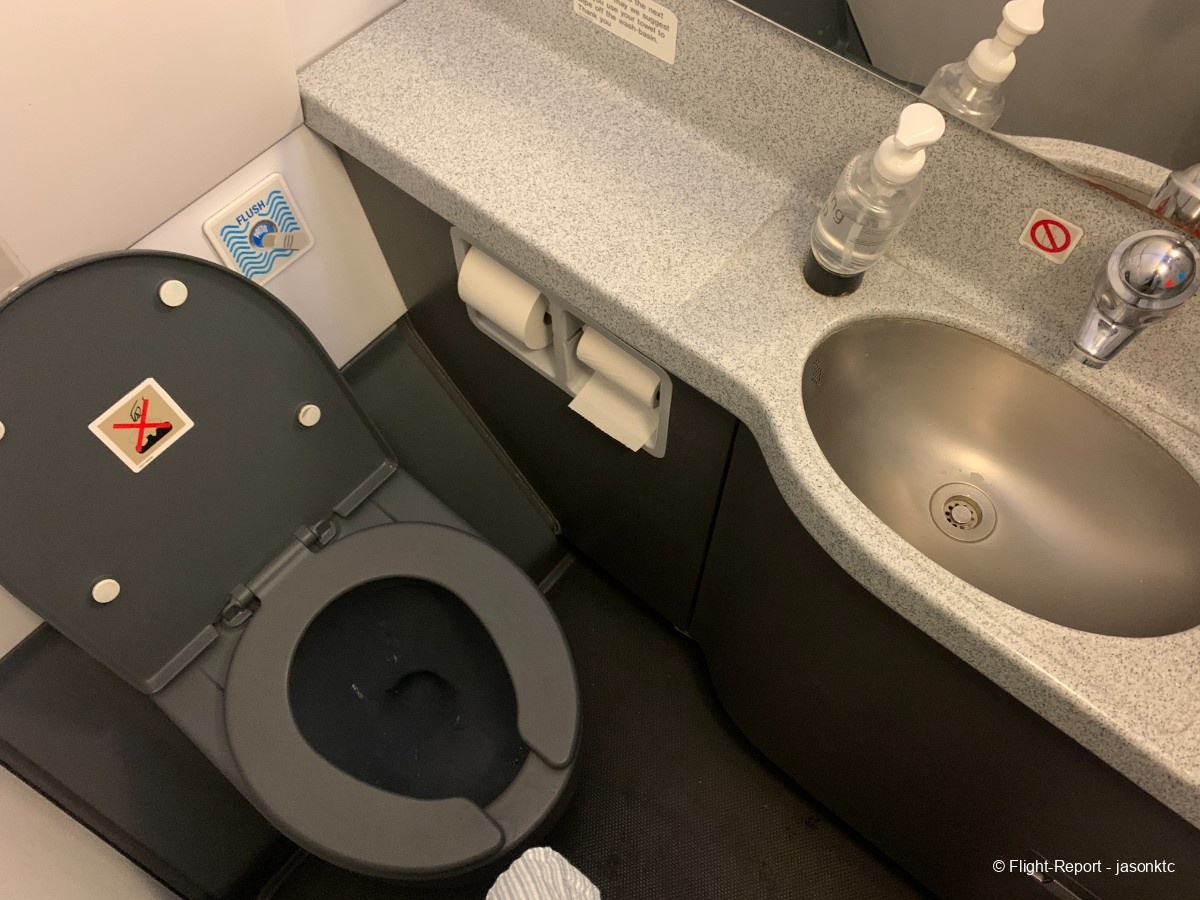
Cabin Crew and Service on SK4610:
The two-hour flight went smoothly and uneventful, which meant the cabin was mostly quiet during the journey. The flight attendants were polite and efficient. They were also attentive to satisfy passengers' needs, like those who ordered food and drinks from the inflight menu. They performed manual safety demonstration in English first, then followed by Norwegian during taxi. The rest of the announcement during flight were done in the other way around. I am unsure whether they are employed by SAS mainline or its subsidiary, SAS Connect with cheaper contracts since the flight was operated by SAS mainline's plane but marketed as "flight operated by SAS Connect" when purchasing the ticket.
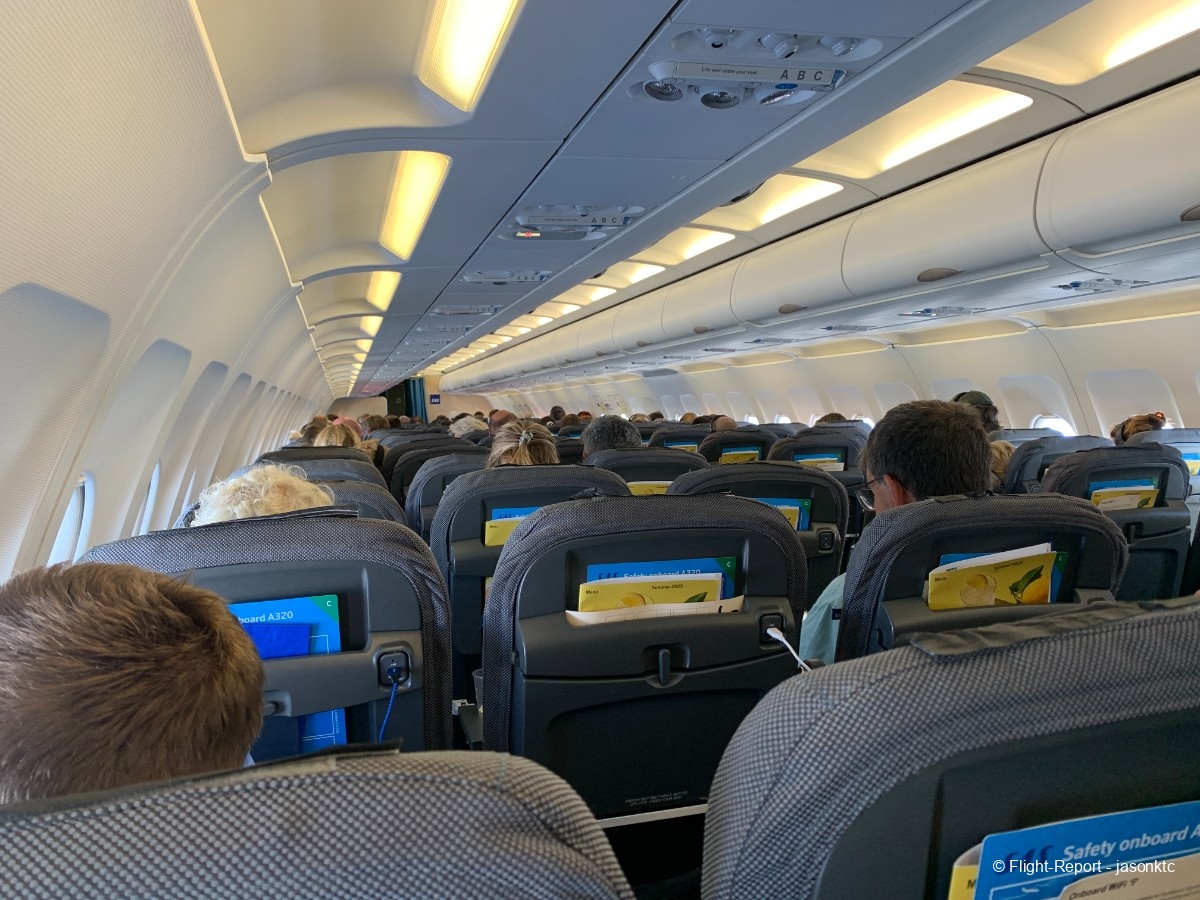
Descend towards OSL:
Back to my seat, and I started to see the abundance amount of lakes, fjords and rivers scattered across Norway.
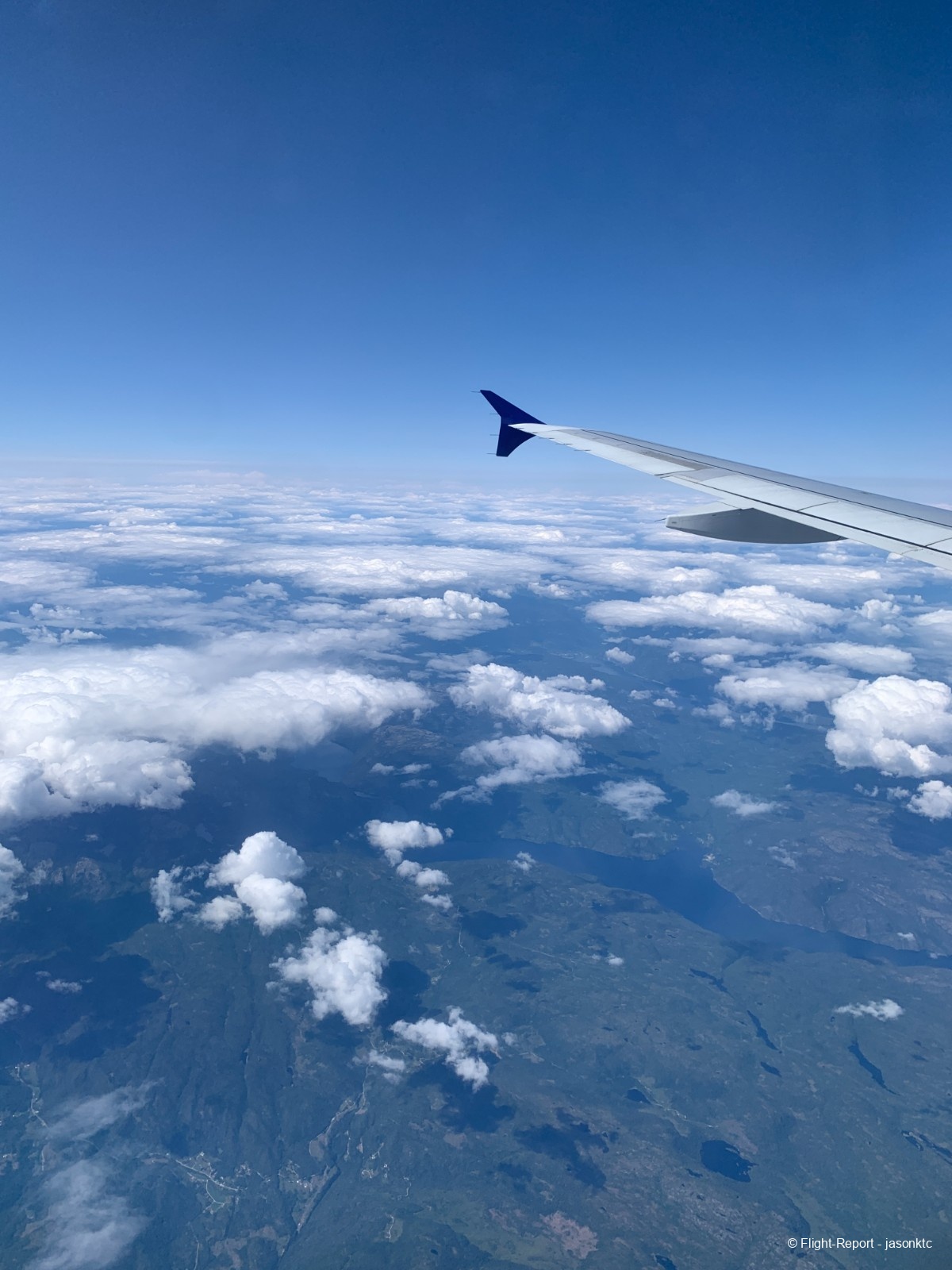
Soon, at 14:22 BST/ 15:22 CEST, two hours and twenty minutes after takeoff, the captain began his landing announcement. He informed us that the weather was fairly good and warm at Oslo, and anticipated some scattered clouds when approaching OSL. He expected to arrive 15 minutes ahead of schedule, too.
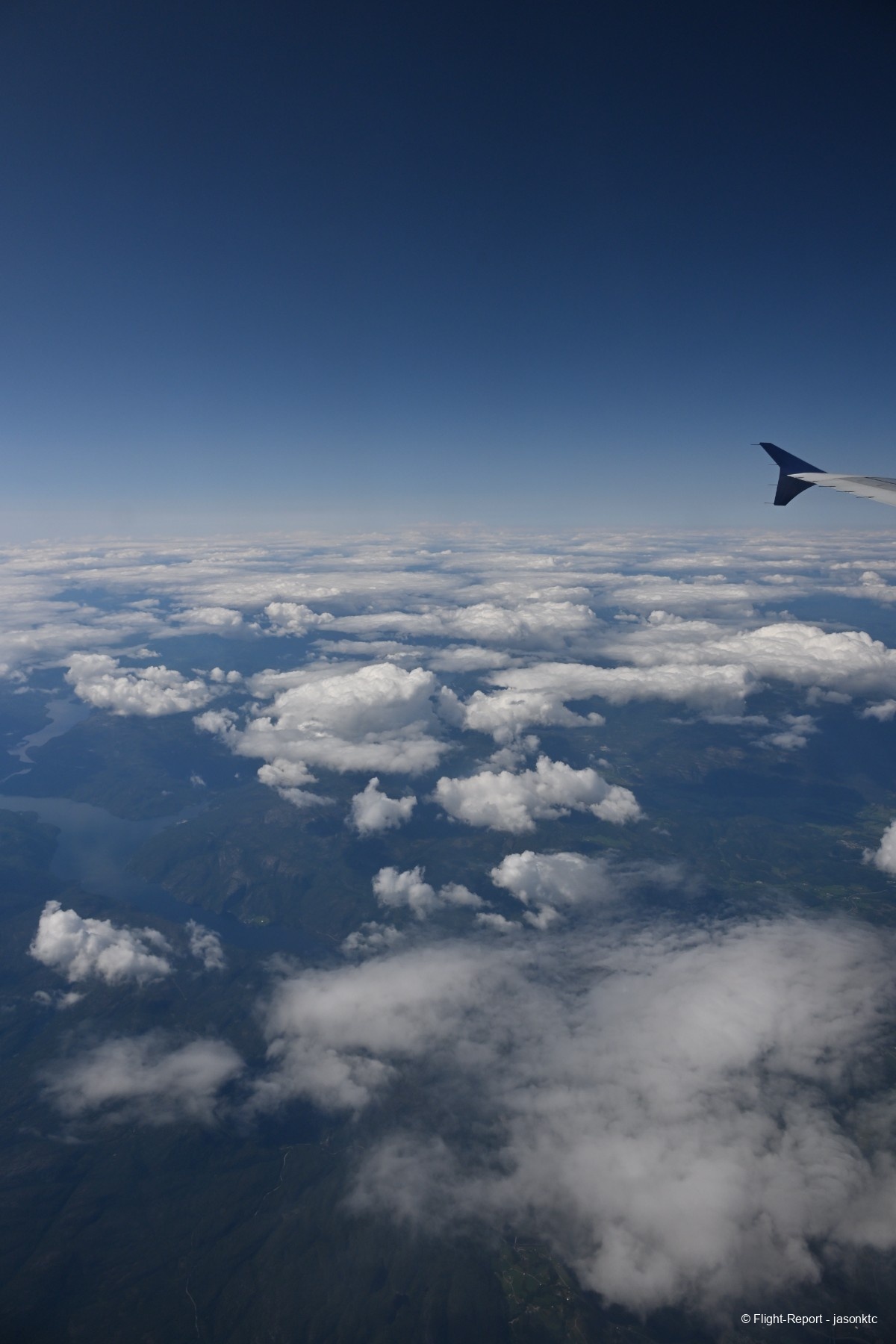
The plane descended towards northeast and we started to see the outskirt of Oslo and various islands that dotted around Oslofjord. The big, green island in the photo below is Bygdøy which is located at the southwestern side of Oslo and is famous for its beaches and museums that showcase Norwegian Viking and maritime history.

The plane flew directly across Oslo and we got an fantastic aerial view of the city's waterfront. Here we could see some of the major tourist attractions, such as the iceberg-like Oslo Opera House on the right, Akershus Fortress, Oslo City Hall and National Museum in the middle and Aker Brygge and Tjuvholmen neighbourhood to the left. The islands of Hovedøya, Lindøya and Bleikøya are also visible.
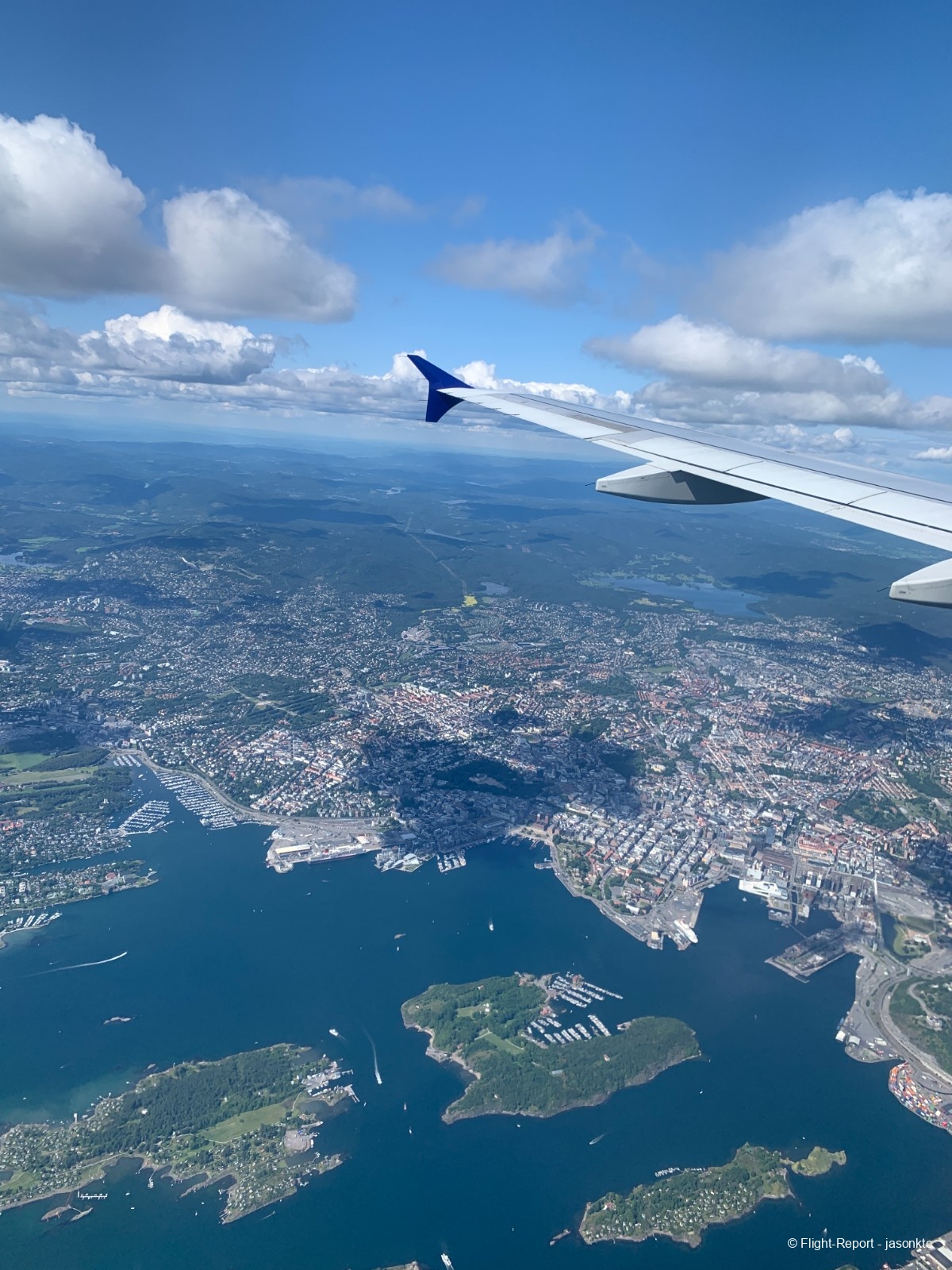
We were able to see the central and eastern part of Oslo as the plane continued its approach towards OSL. Bottom left is Ekebergparken. Oslo Central Station in the middle and Grünerløkka slightly further north.
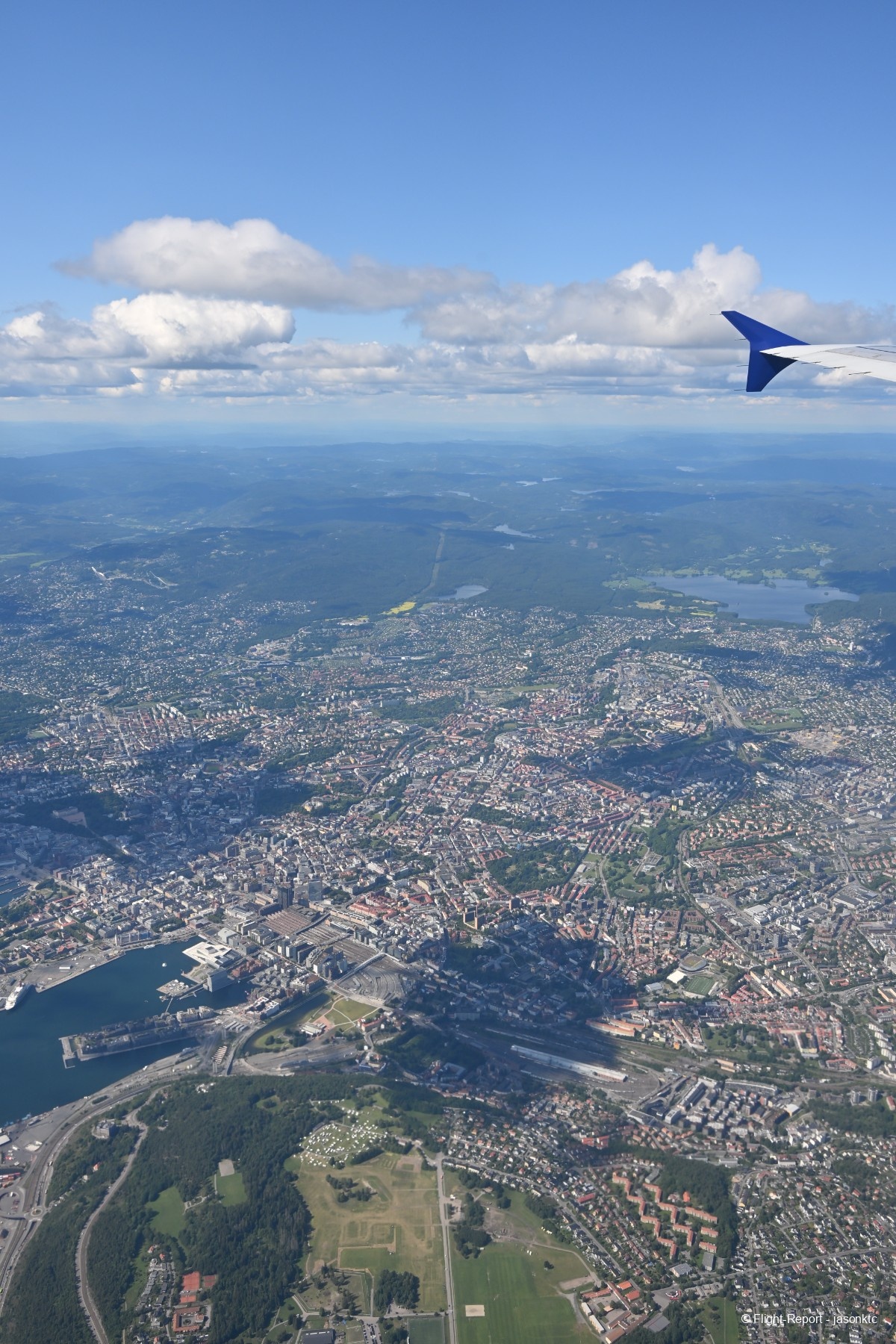
More trees and lakes. There was some minor turbulence as the plane flew closer to OSL.
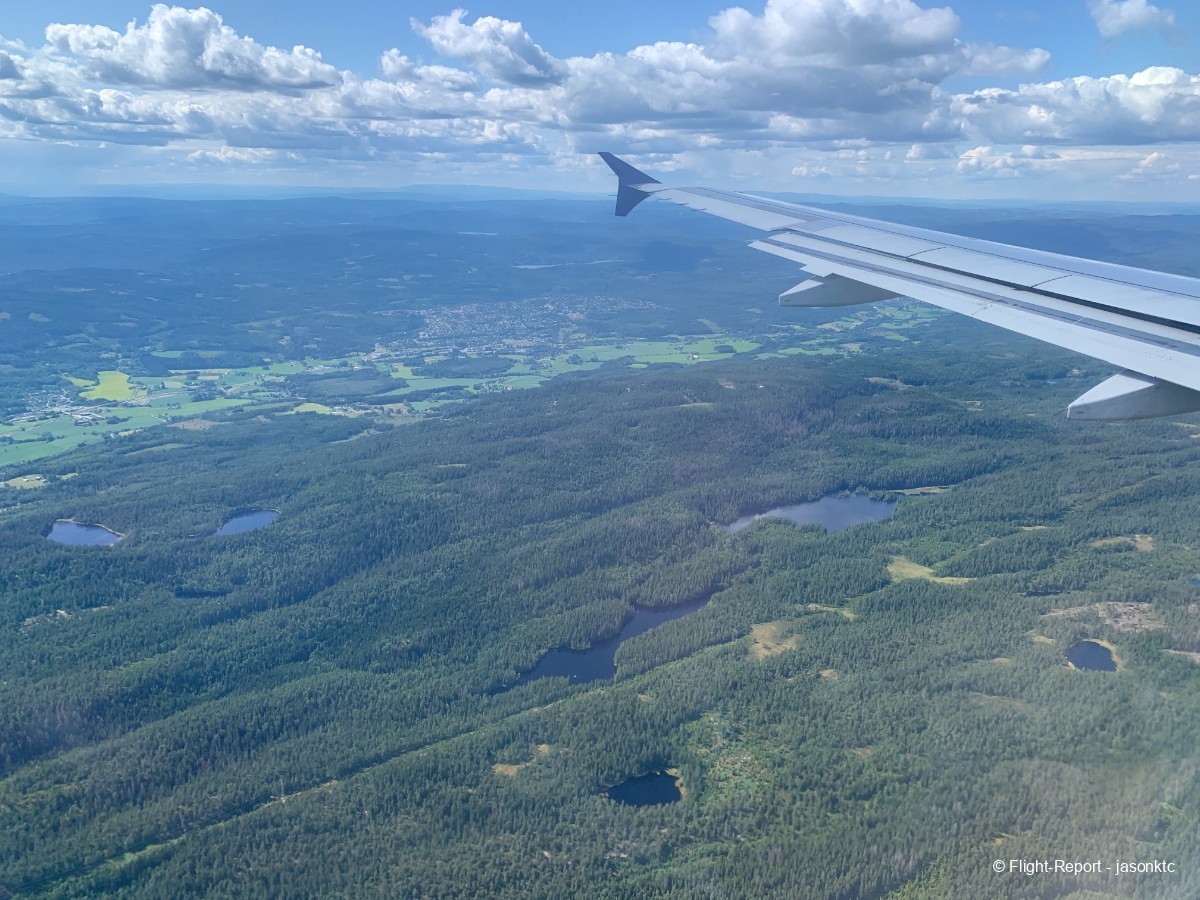
A screenshot showing the path of my flight which my girlfriend captured when she tracked the flight on Flightradar24 at Hong Kong.
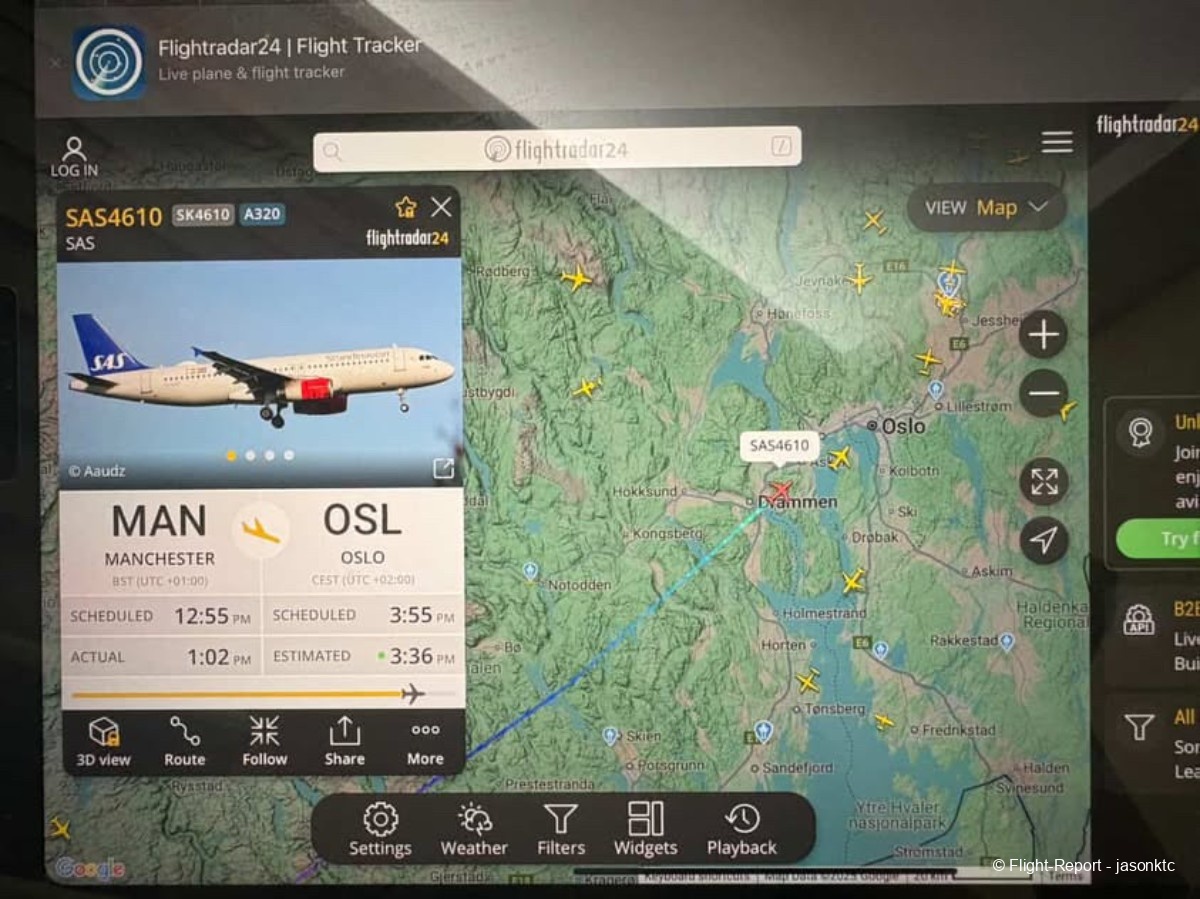
Landing at OSL:
The plane touched down on runway 01L at 15:37 local time.

The pilots performed a nice soft landing.
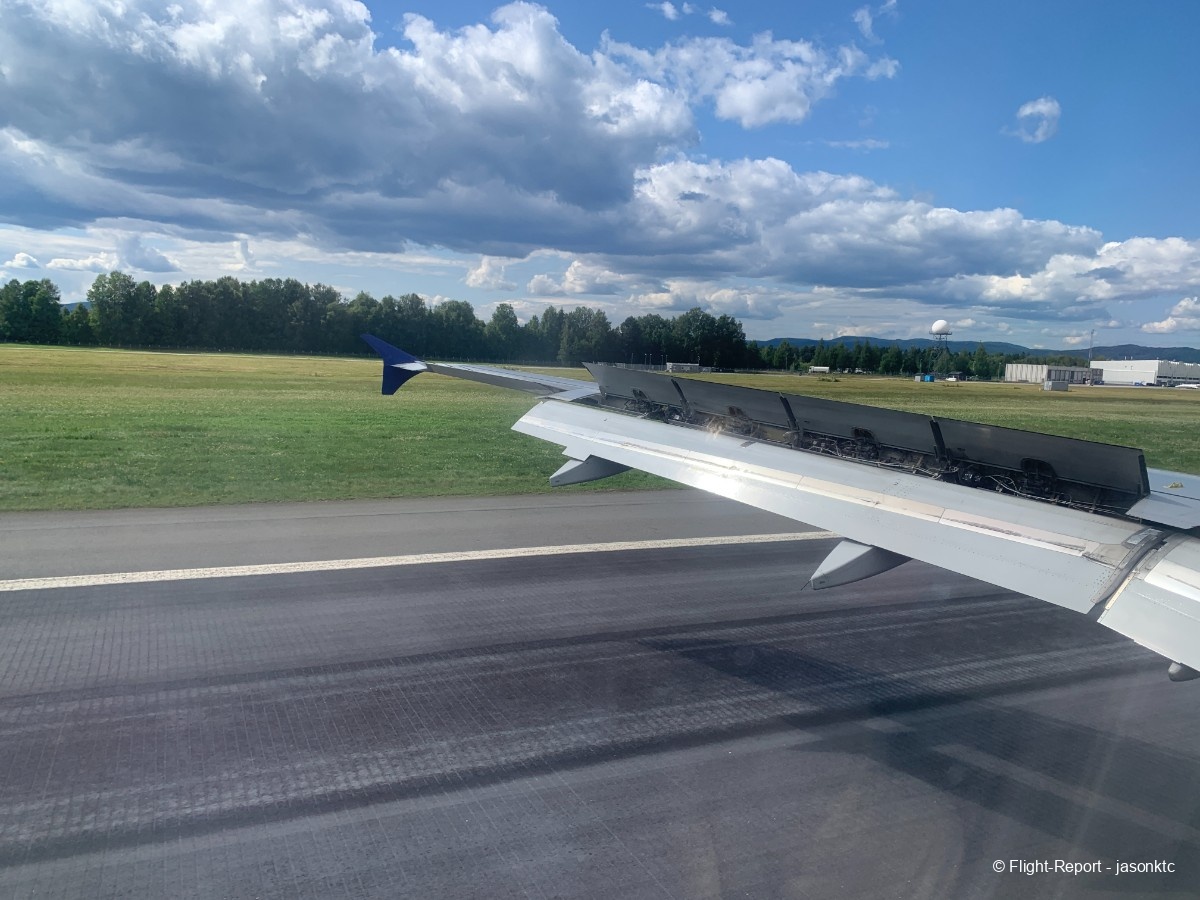
After a shot three-minute taxi, the plane arrived at gate A12 at 15:40 local time and parked next to a SAS A320neo that still wears the old livery just like ours.

Arrival in OSL:
Interestingly, the rear half of the passengers, including me who sat at 26A, were asked to disembark via stairs even though the plane was parked at a bridge-connected gate. An electric VDL shuttle bus then took us to the terminal.
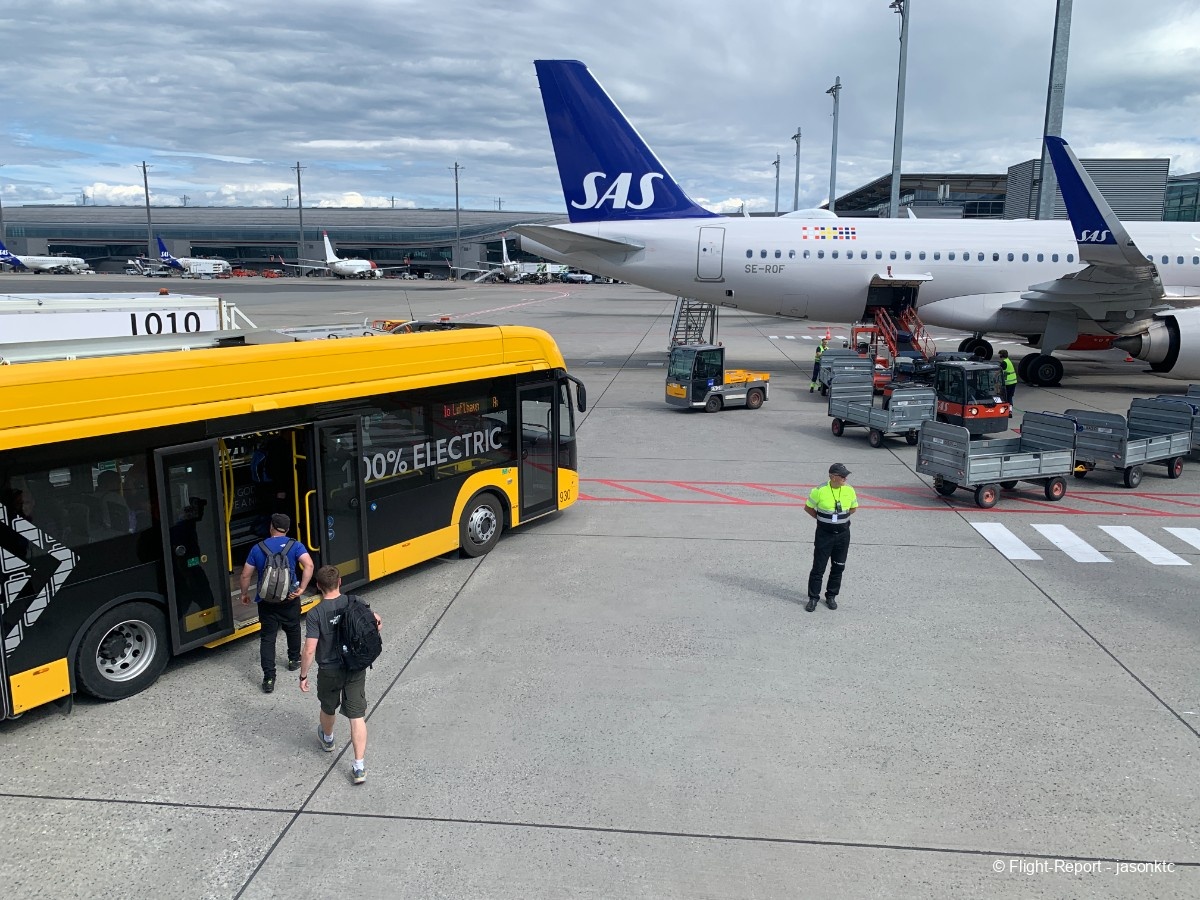
The bus ride took about seven minutes and most planes that I saw at OSL were mostly A320neos from SAS, E195 from SAS Link and Norwegian's B737s. Below is LN-NIO, a Norwegian's B738 that has UNICEF tail design.
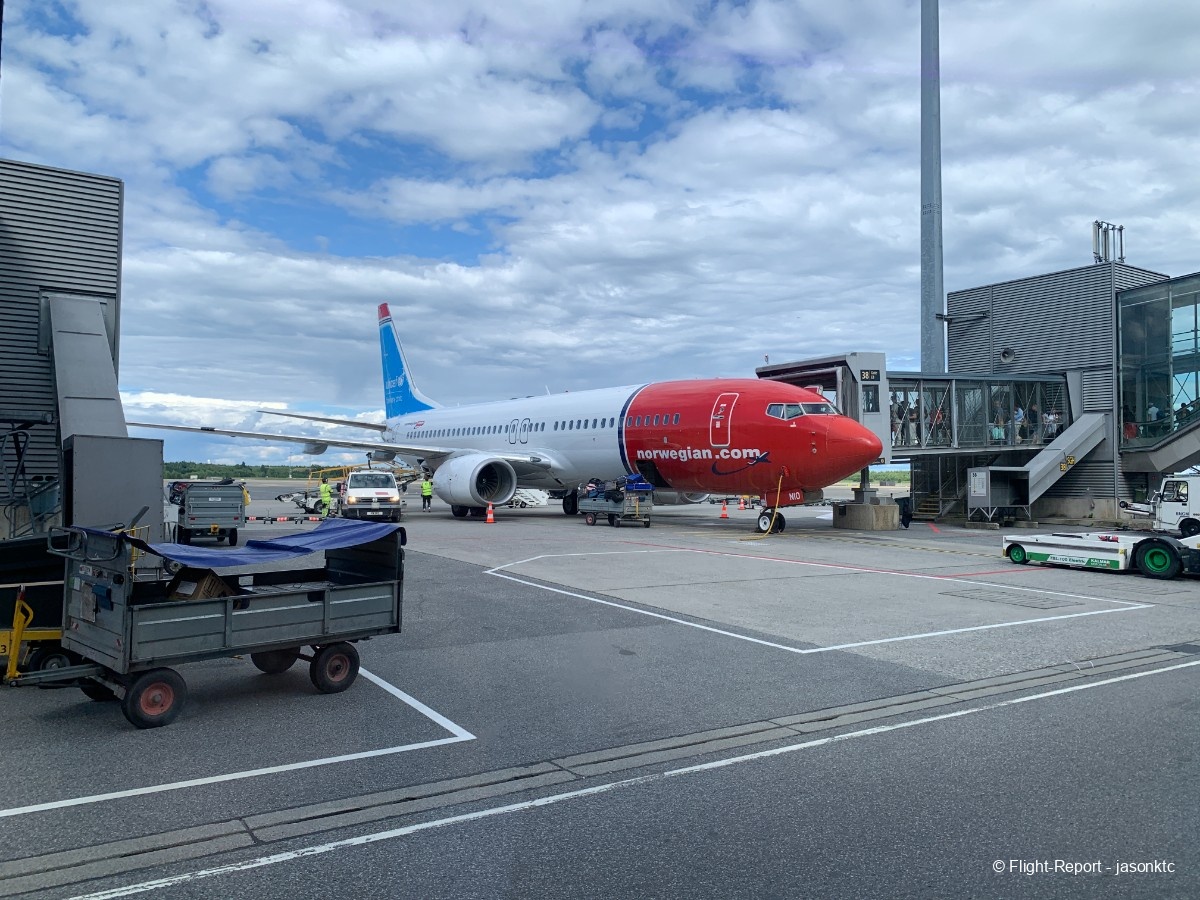
After getting off the bus, we headed to the border control via an escalator which was unfortunately inoperative. There was no queue at the border control. I got the Norwegian entry stamp on my passport! Sadly, these Schengen stamps will be phased out in October, 2025 with the introduction of digital EES. Not a big deal, but less fun when flicking through the passport to see places that I have visited.
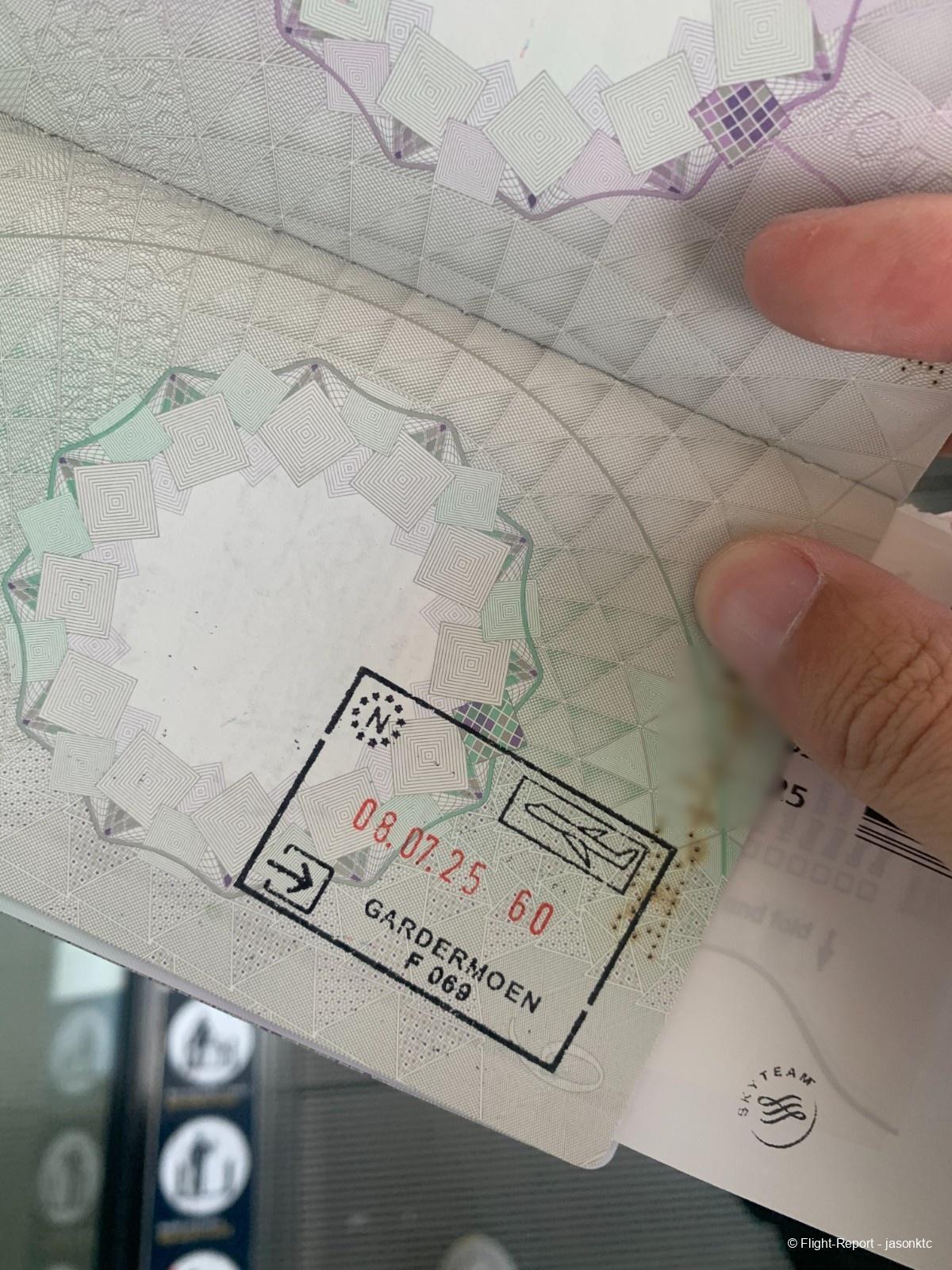
I could only manage to take a quick snap of OSL when I was heading to baggage collection. I think the below photo was part of the departure area, and there is an an interesting tiger sculpture. Overall, the airport gave a clean, modern and spacious impression.
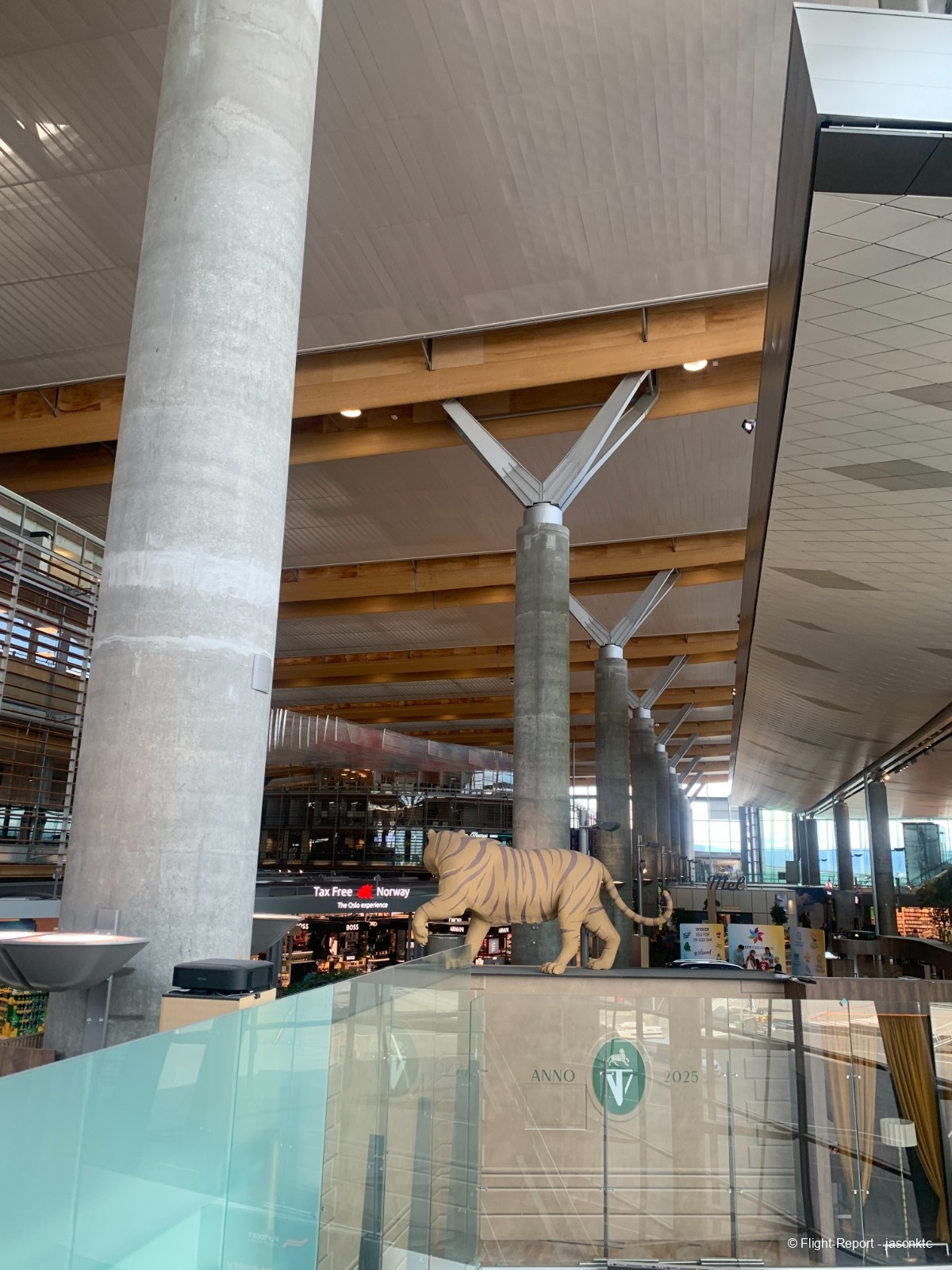
Before entering the baggage reclaim area, there is a huge duty-free shop that looks like a supermarket. This is the last chance to buy things like alcoholic beverages that are subjected to high tax in Norway before officially entering the country. There are also the usual duty-free products such as sweets, perfumes and cosmetics.
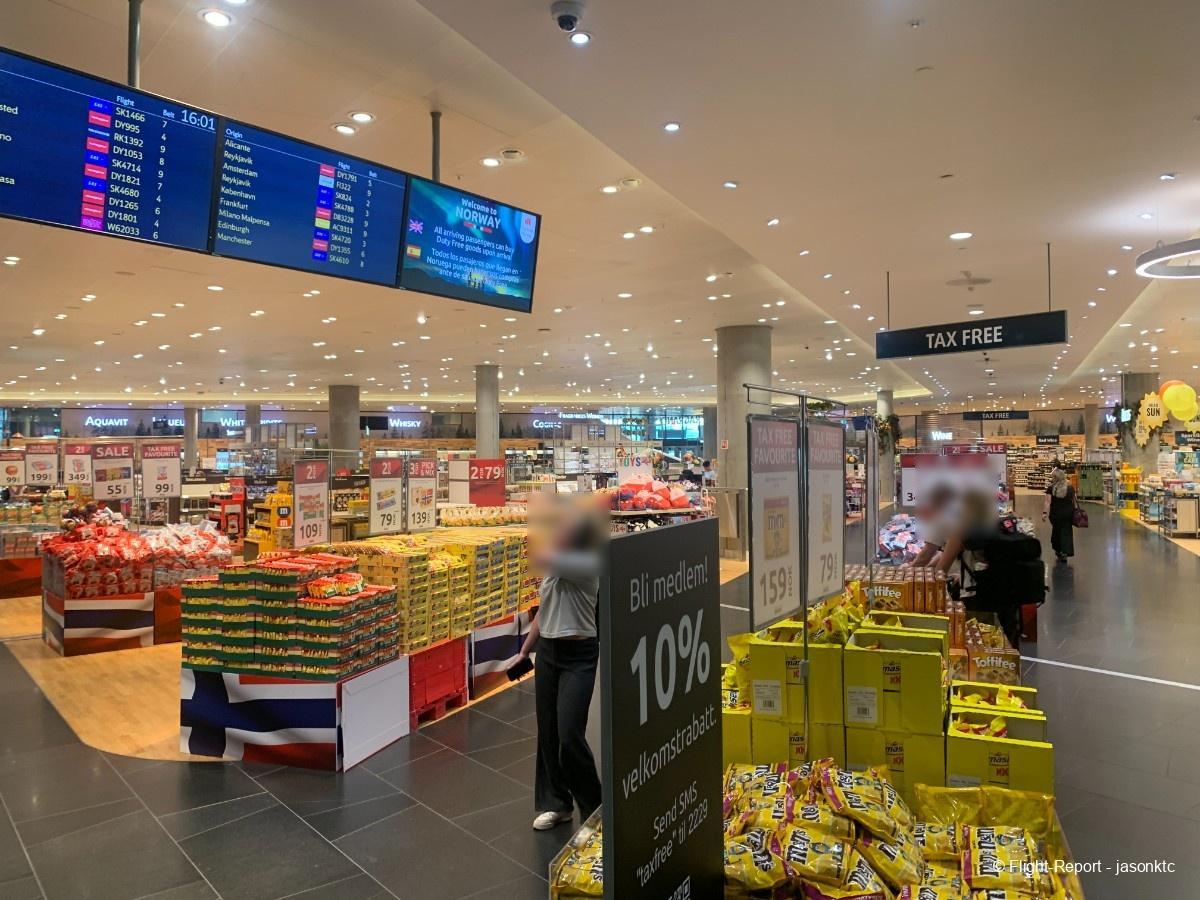
Our flight was allocated to belt 5 in the baggage reclaim area. My baggage came out in less than five minutes and I quickly proceeded to Oslo Lufthavn Station.
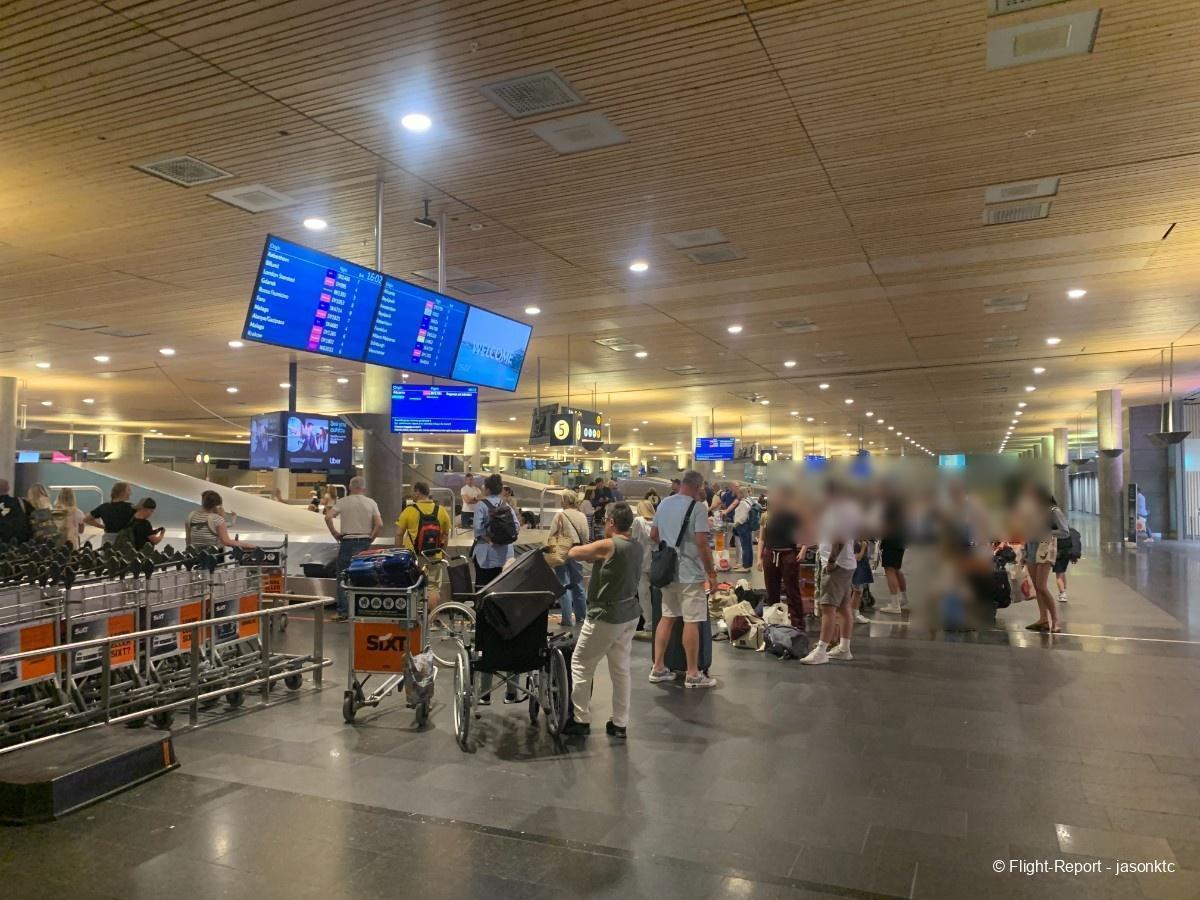
There are quite a variety of cafes, restaurants and convenience stores on the way to the station.
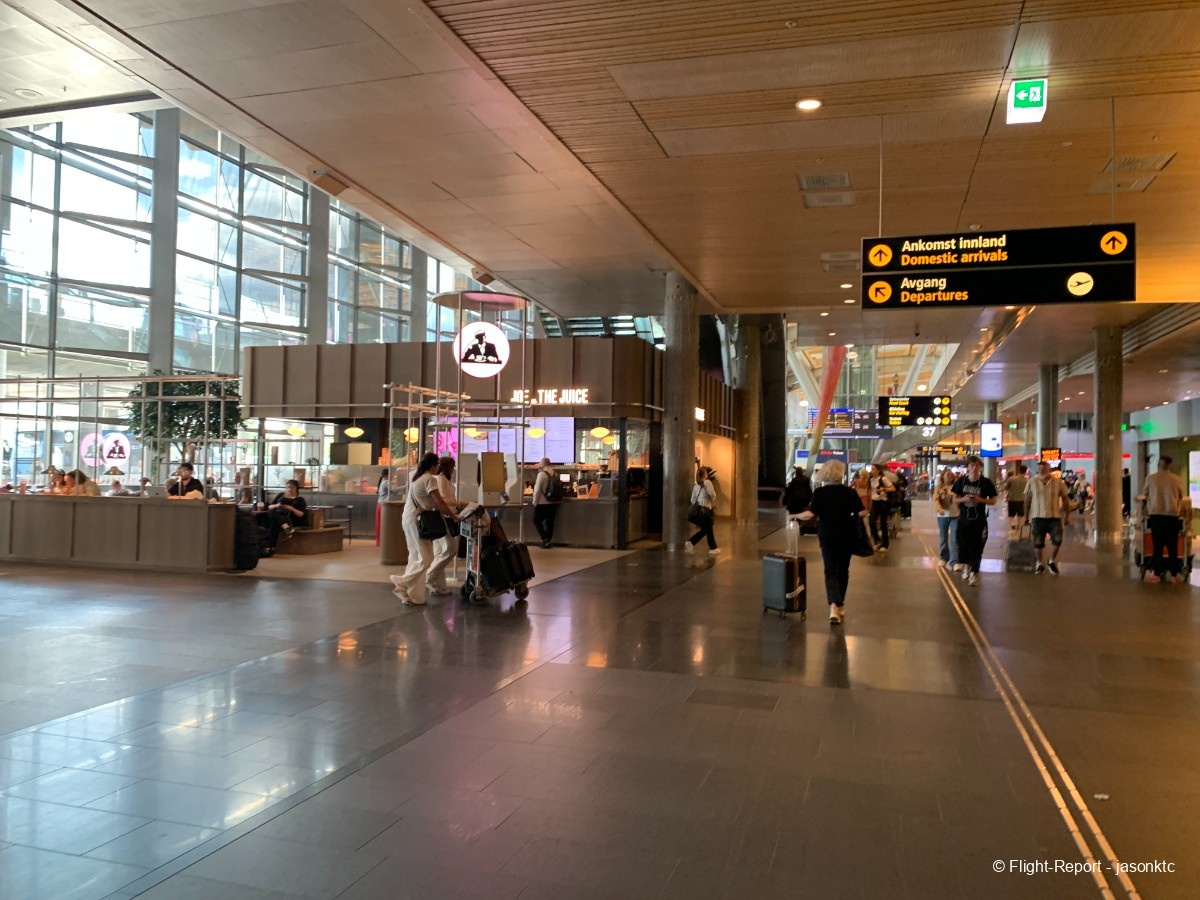
There are two options to travel to Oslo's city centre by rail : Flytoget or Vy's regional trains. Flytoget is the airport express service and the fastest train to Oslo Central Station takes 19 minutes. A single ticket costs NOK 252/ GBP 18.3 at the time of writing. Alternatively, you can take Oslo's regional trains (Line: RE10, RE11, R12) operated by Vy (Norway's railway company) that take about 23 minutes to Oslo Central Station. The regional trains cost NOK 129/ GBP 9.4, which is almost half the price and only four minutes slower. I think the choice is obvious.
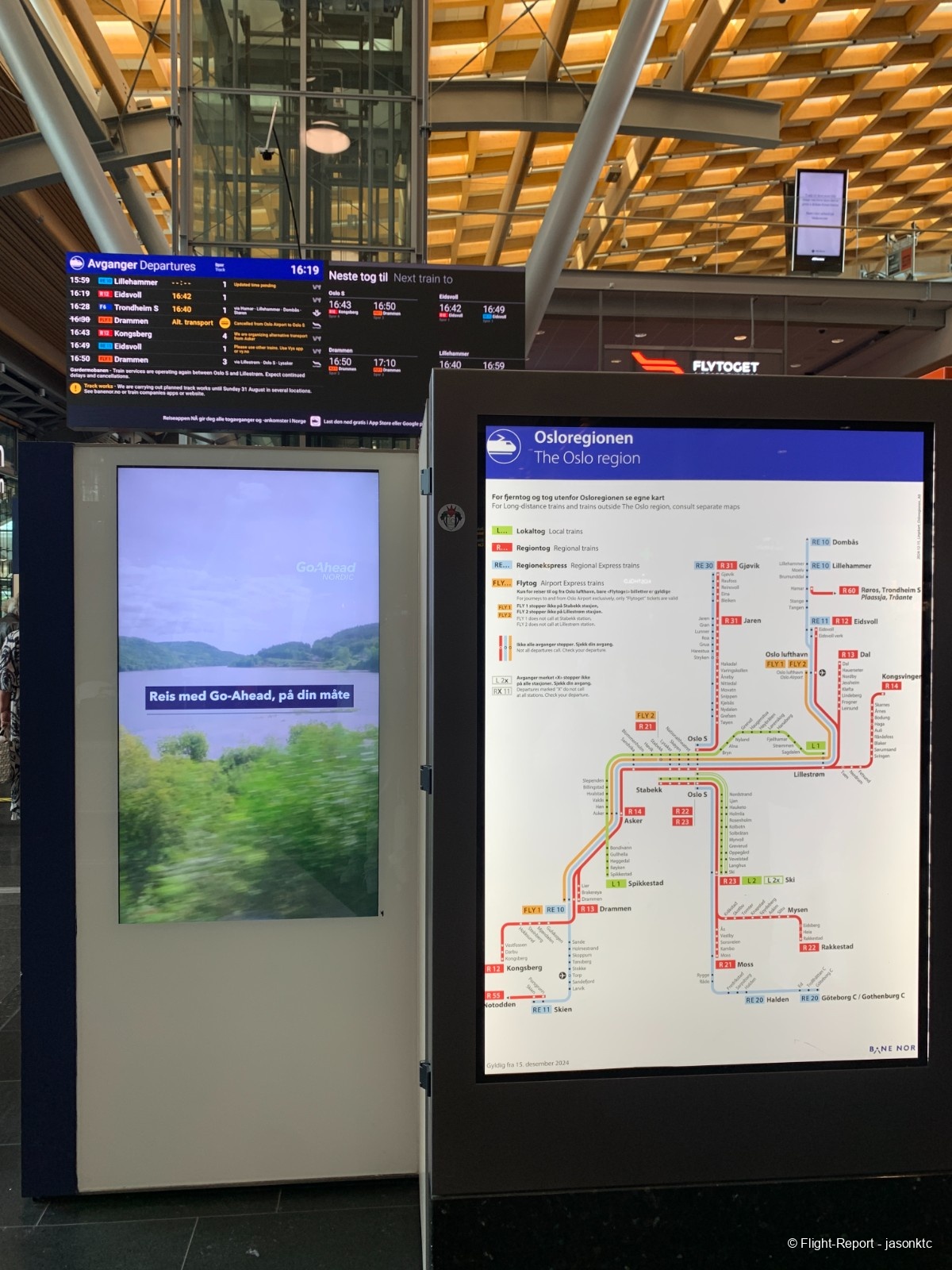
Passengers have to buy ticket for the regional trains either from the ticket machine or through the apps of Ruter (for all Oslo's city transportations) or Vy. I recommend buying tickets on the app as there may be additional surcharge if buying from the ticket machine or onboard. The ticket to Oslo Central Station covers four zones, which means you can use all kinds of public transportation in the zones within 150 minutes. I did not buy the zone ticket as I have bought the Oslo Pass, a tourist pass that gives free admission to almost all museums and free public transportations in Oslo including the regional trains between Oslo Airport and the city (but not Flytoget). I bought a 24 hours pass and cost NOK 550/ GBP40.
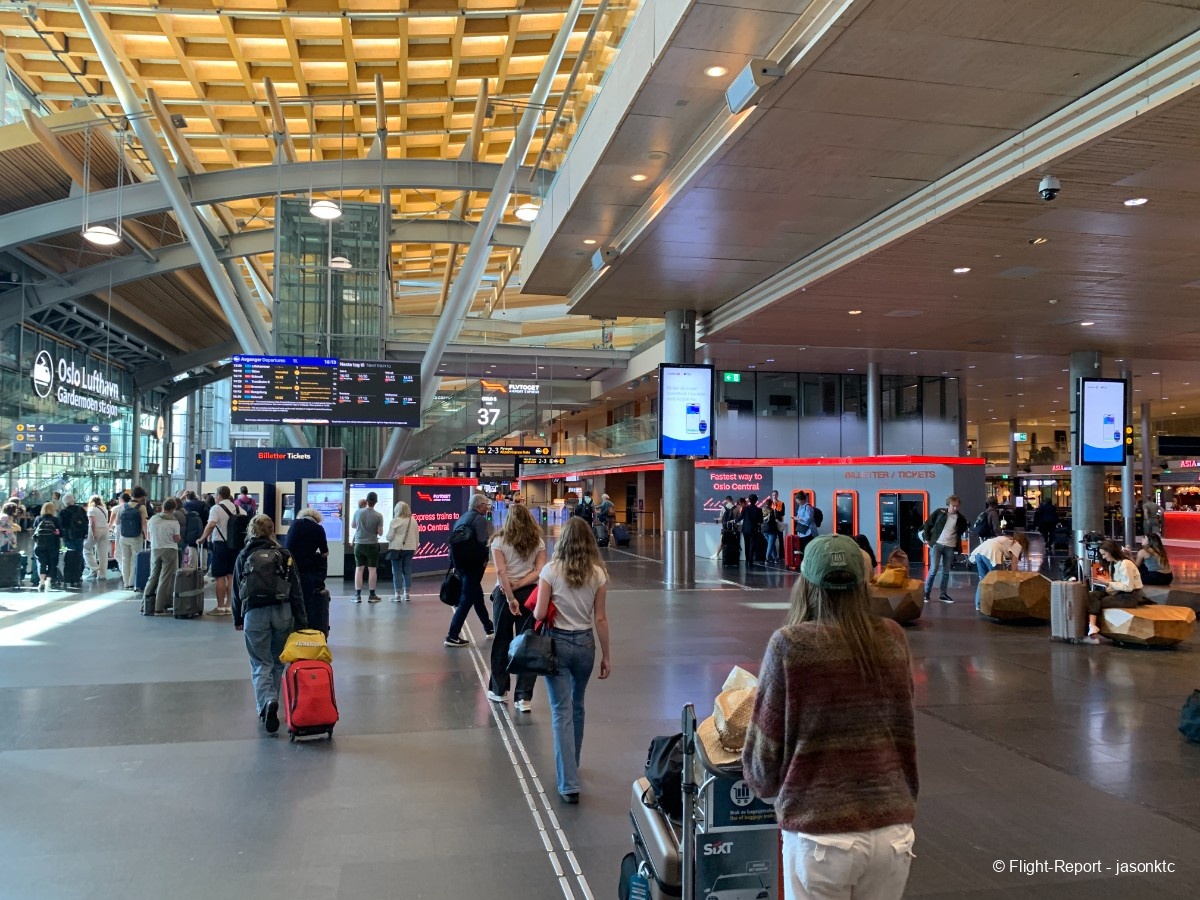
The platforms for the regional trains and Flytoget are next to each other.
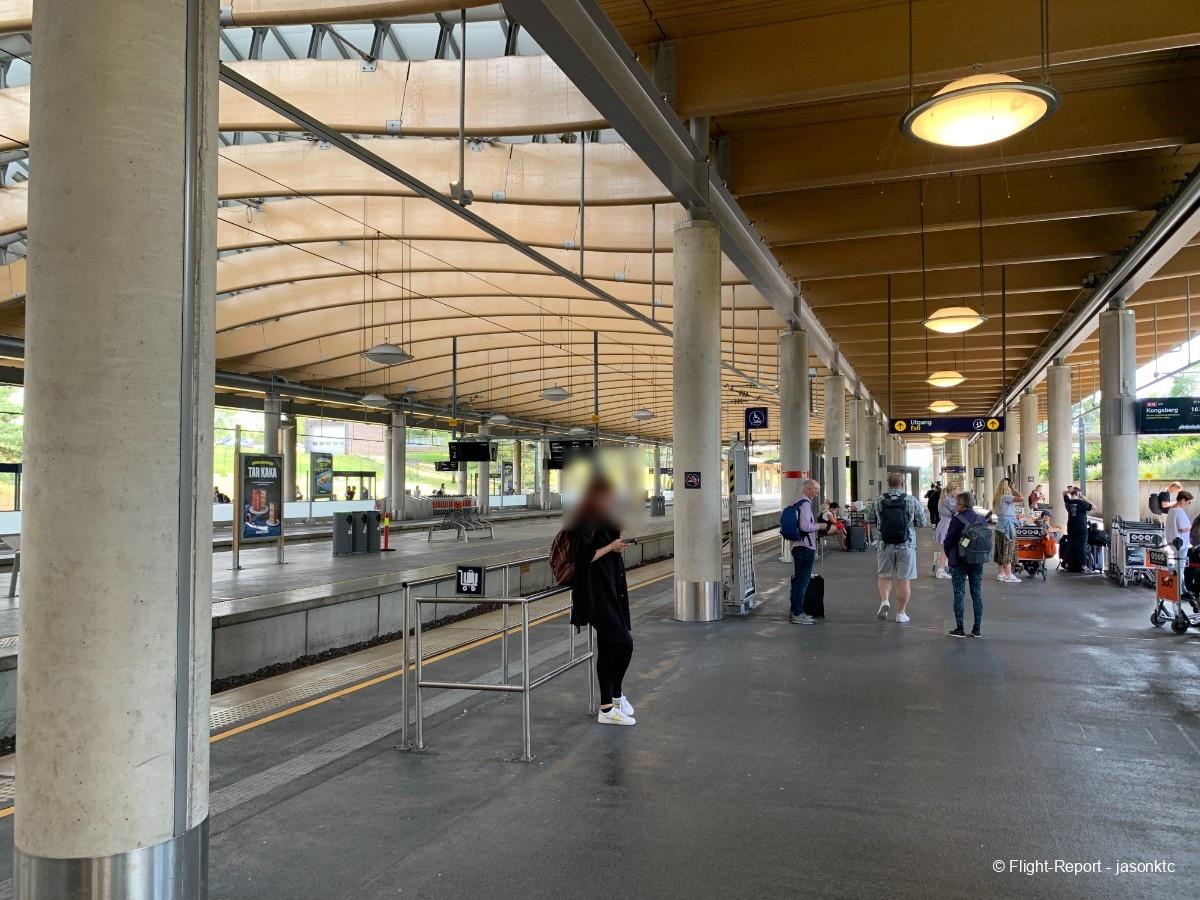
Unfortunately, I had really bad luck with trains that day. All the trains between Oslo Central Station and Lillestrøm were disrupted by signal failure (not again!) and planned engineering work. The estimated time of arrival for my R12 train kept delaying, sometimes even disappearing.
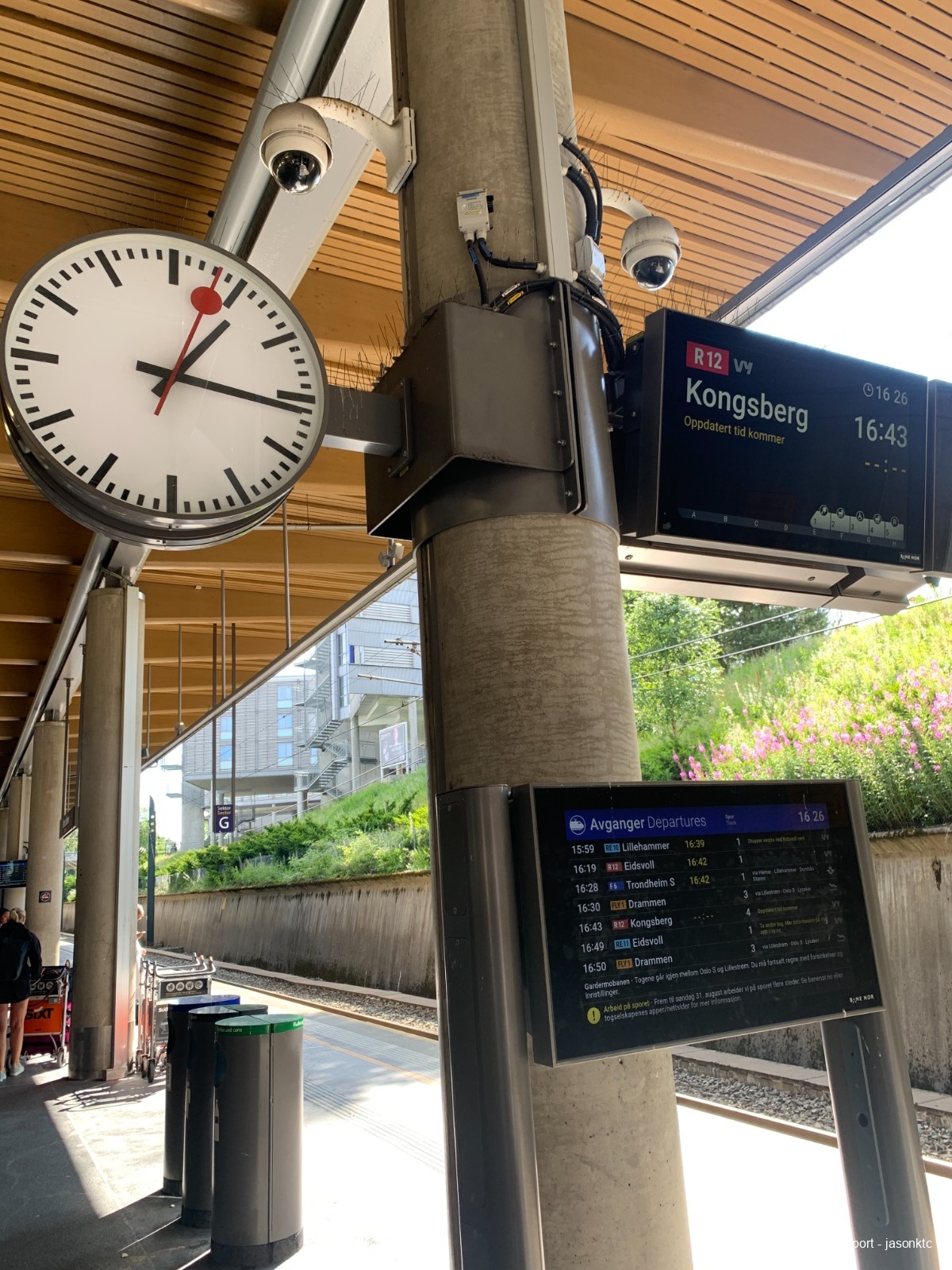
At the end, it took me almost an hour to arrive at Oslo Central Station at 17:17. Who could have guessed my bad luck with trains in this trip would continue…
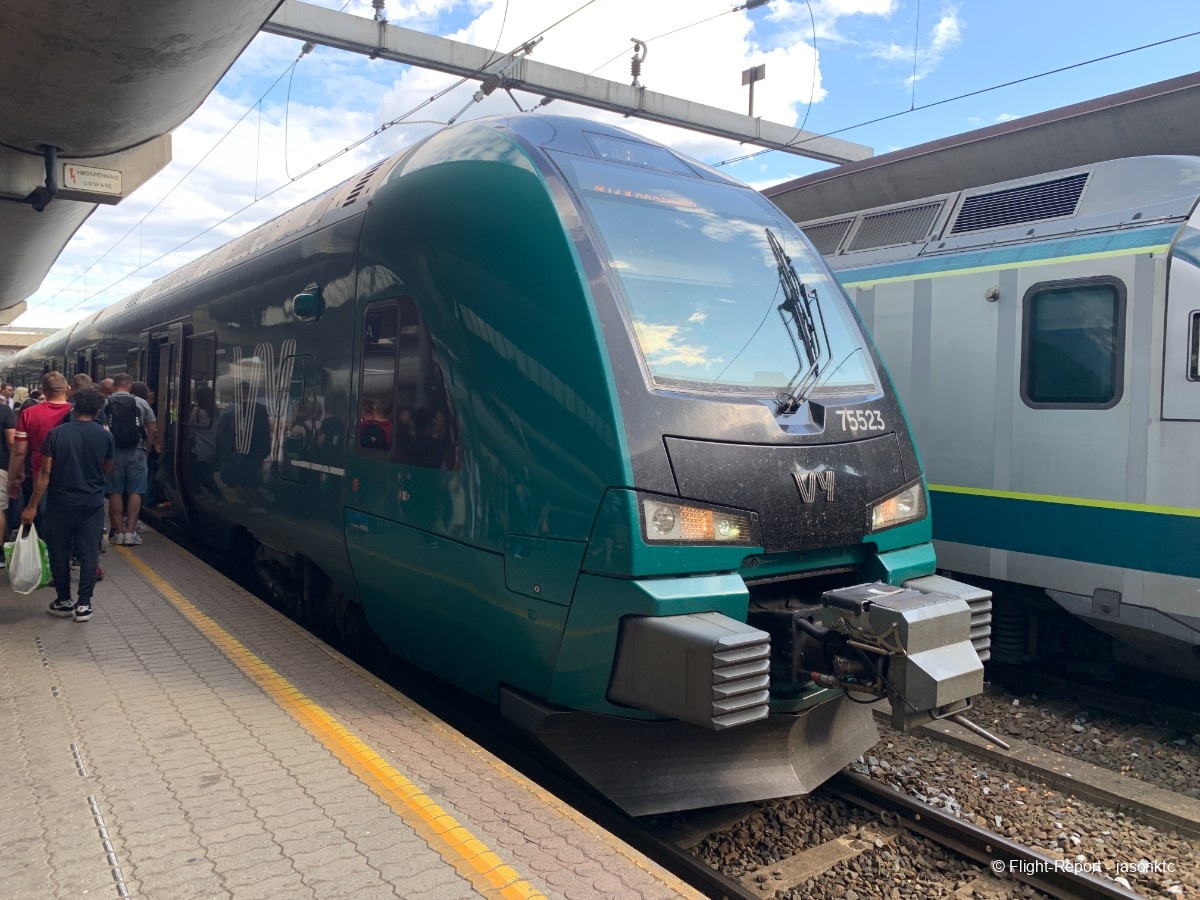
On the other hand, I had very good luck with the weather throughout the trip! I was greeted with nice weather when I exited Oslo Central Station to the public square of Jernbanetorget.
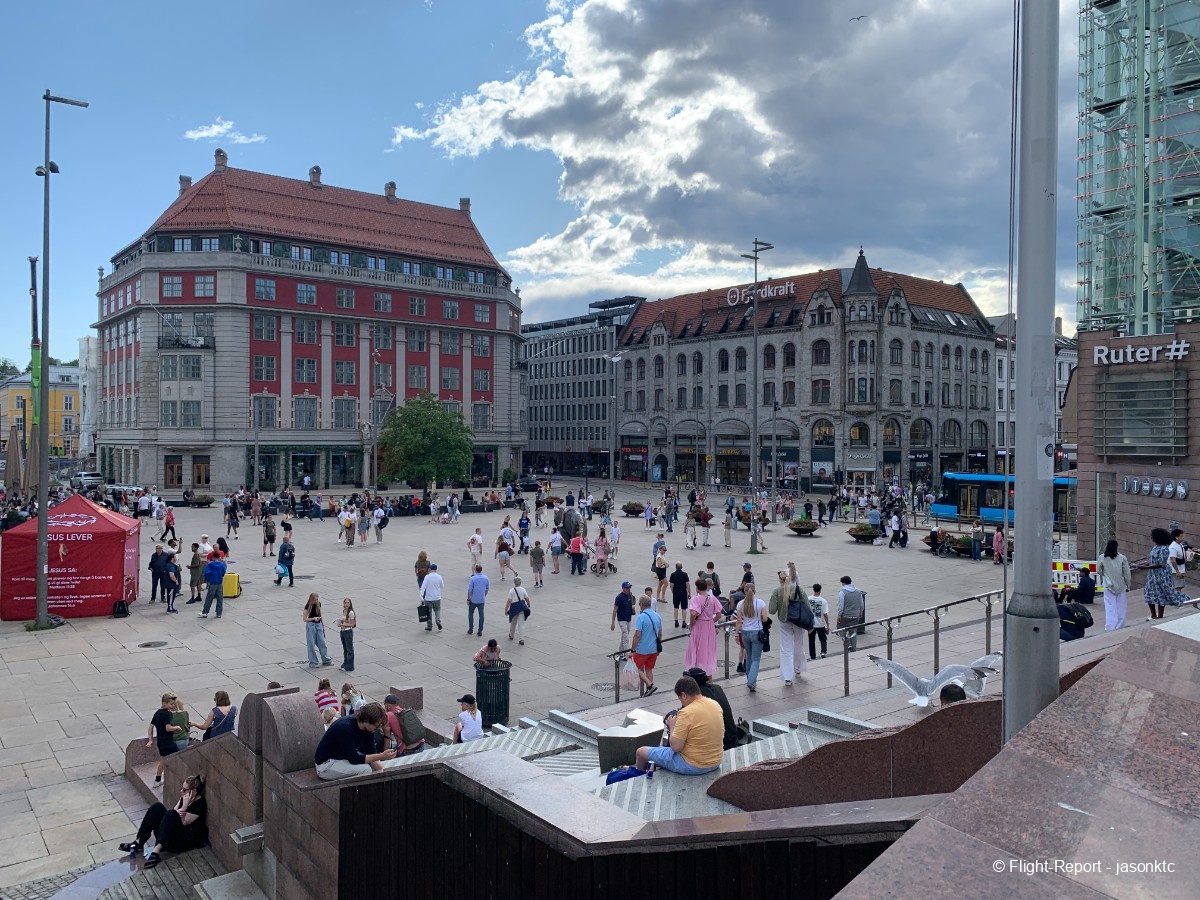
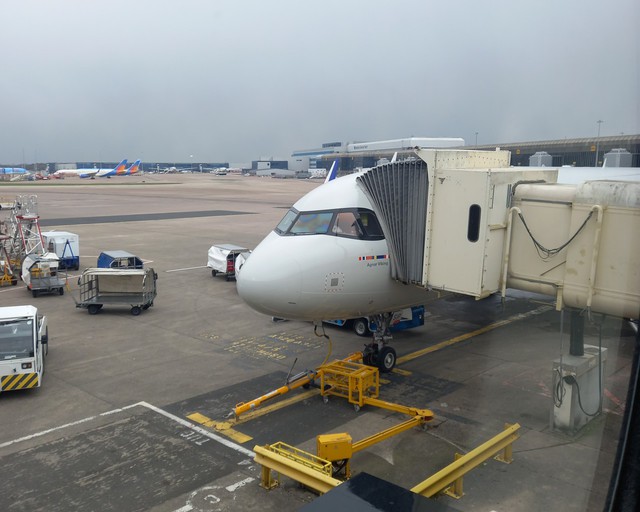
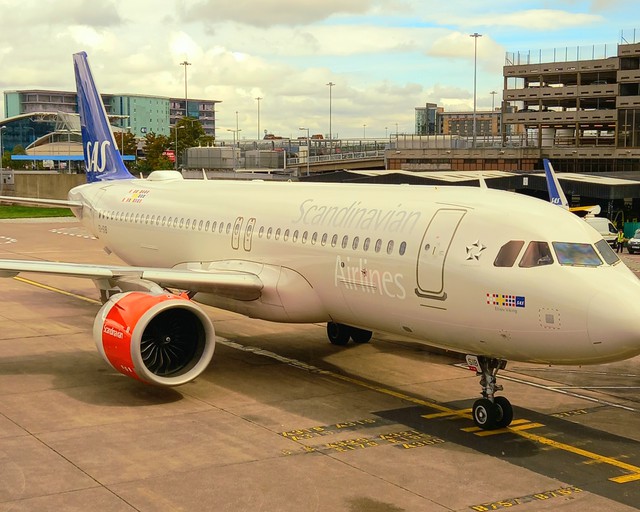

I really loved reading this detailed review, especially the effort you have made to publish it barely 2 days after the flight !
Indeed MAN T1 's design is awful however this terminal will be partly demolished and will make way to become an upgraded T3.
SAS Connect Crews are not SAS Mainline crews and are on different contracts. They are mostly based at Heathrow. I do hope you get to fly with SAS Mainline on the way back and you will immediately note a very Scandi vibe from the Scandinavian crew.
Loving the snazzy inflight menucard but yes the cabin needs upgrading. With SAS move to Skyteam, hopefully we will start to see refurbishment soon.
You memtion that the free inflight service now includes water ? High time SAS offered water I say.
Do enjoy my own MAN-OSL-MAN as well as other SAS reviews. Thanks again for a wonderful review !
Dear Thejetflyer,
Thanks for your feedback, I greatly appreciated it.
I am glad that MAN will get its upgrade soon. The people in the Northern England certainly deserve some better transport infrastructure upgrade.
Unfortunately, I booked this SAS flight as a one-way ticket as I left Norway from Stavanger not Oslo. However, I did receive the Scandi vibe that you mentioned on my other two flights on Widerøe and Norwegian, please stay tuned for that!
I am not sure whether these A320ceos will get refurbishment though as SAS are undergoing fleet renewal. These A320ceos are relatively old and may be returned to lessor when the lease is finished without getting any further refurbishment. But I think the most important thing is to keep the planes clean and that does not matter with the age of the plane.
Yes I will certainly read your reviews, too. Thanks for your great support and time in reading my long review!